Category
Journals
7 entries in this category | view all categories
You Devil! A Fairy Tale
Posted October 2019 in Journals
With Halloween apologies to our flying bat friends, role-playing courtesy of the Vienna stage ca. 1894 pits the demons of the mirror’s Vanity and Indulgence against our better angels.
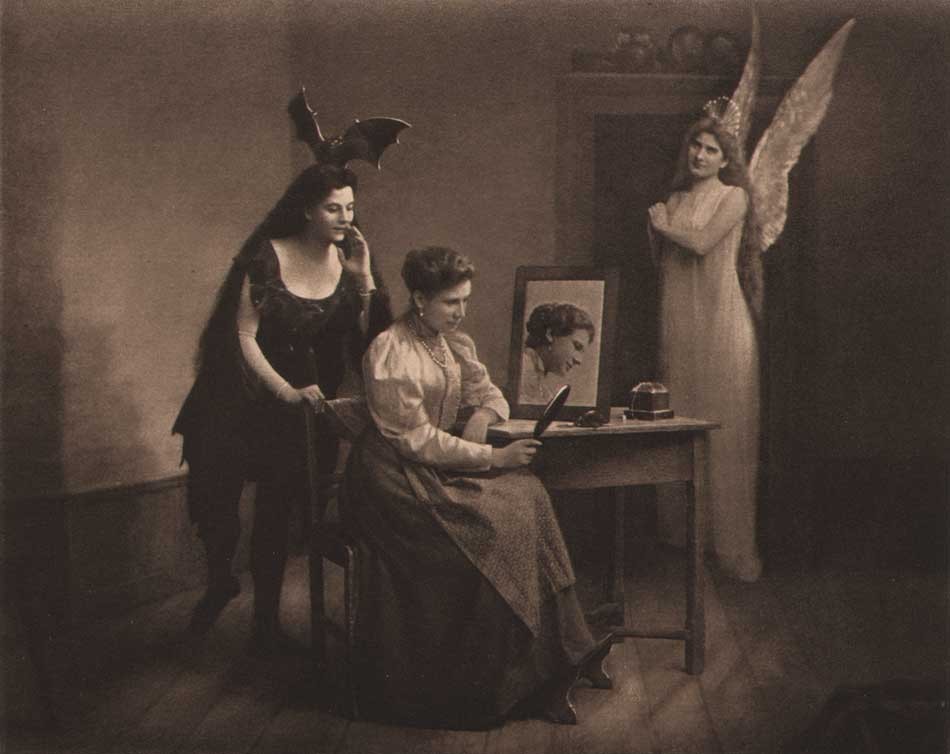 “Scene aus dem Ballet Rund um Wien” (Scene from the Ballet “Around Vienna”) by (Baron) Albert Freiherrn von Rothschild, Austrian: (1844-1911): 1896: Chine-collé photogravure from atelier k.u.k. Military Geographical Institute in Vienna. (11.1 x 13.9 | 16.0 x 23.6 cm) Published in the July,1896 issue of the Austrian photographic journal Photographische Correspondenz, ballerina Camilla Pagliero (1859-1925) examines herself in the mirror while trying on some jewelry ⎯ while the allegorical forces of evil at left ⎯ (Austrian stage actress Marie Schleinzer, (1874-1949) mistress to Archduke Otto of Austria) and good at far right (most likely Hedwig Haentjens, as an angel) make starring roles. Possessing “all the virtues of amateur photography”, the editors of the journal in the following rough translation from the original German stated this… “image is exceedingly characteristic, and the effects are so locked together that the most beautiful in the mirror-image confronts Freiherr von Rothschild with his image "blurred direction". We rejoice in the example given here, because, of the small format and the consequent reduced scale, there is so seldom the opportunity to make use of the indefinite charm, whereby the imagination of the observer is called upon to shape the picture.” Austrian Court Ballet director Josef Bayer (1852-1913) composed “Around Vienna” (Rund um Wien) in 1894 as a golden jubilee celebration honoring Viennese Waltz King Johann Strauss II. (1825-99) It was performed in October that year at the Vienna State Opera house. From: PhotoSeed Archive
“Scene aus dem Ballet Rund um Wien” (Scene from the Ballet “Around Vienna”) by (Baron) Albert Freiherrn von Rothschild, Austrian: (1844-1911): 1896: Chine-collé photogravure from atelier k.u.k. Military Geographical Institute in Vienna. (11.1 x 13.9 | 16.0 x 23.6 cm) Published in the July,1896 issue of the Austrian photographic journal Photographische Correspondenz, ballerina Camilla Pagliero (1859-1925) examines herself in the mirror while trying on some jewelry ⎯ while the allegorical forces of evil at left ⎯ (Austrian stage actress Marie Schleinzer, (1874-1949) mistress to Archduke Otto of Austria) and good at far right (most likely Hedwig Haentjens, as an angel) make starring roles. Possessing “all the virtues of amateur photography”, the editors of the journal in the following rough translation from the original German stated this… “image is exceedingly characteristic, and the effects are so locked together that the most beautiful in the mirror-image confronts Freiherr von Rothschild with his image "blurred direction". We rejoice in the example given here, because, of the small format and the consequent reduced scale, there is so seldom the opportunity to make use of the indefinite charm, whereby the imagination of the observer is called upon to shape the picture.” Austrian Court Ballet director Josef Bayer (1852-1913) composed “Around Vienna” (Rund um Wien) in 1894 as a golden jubilee celebration honoring Viennese Waltz King Johann Strauss II. (1825-99) It was performed in October that year at the Vienna State Opera house. From: PhotoSeed ArchiveSummer Streams Wide & Small
Posted June 2019 in Alternate Processes, Childhood Photography, Color Photography, Documentary Photography, Journals, New Additions, Painters|Photographers, Scientific Photography, Significant Photographers, Significant Photographs, Unknown Photographers
Herein a summer interlude, if you will, of still, trickling and gushing streams from years past. And if they inspire and beckon for the present, find your own peace or wonderment in the mountains, valleys or pastures of summer wherever your own stream flows.
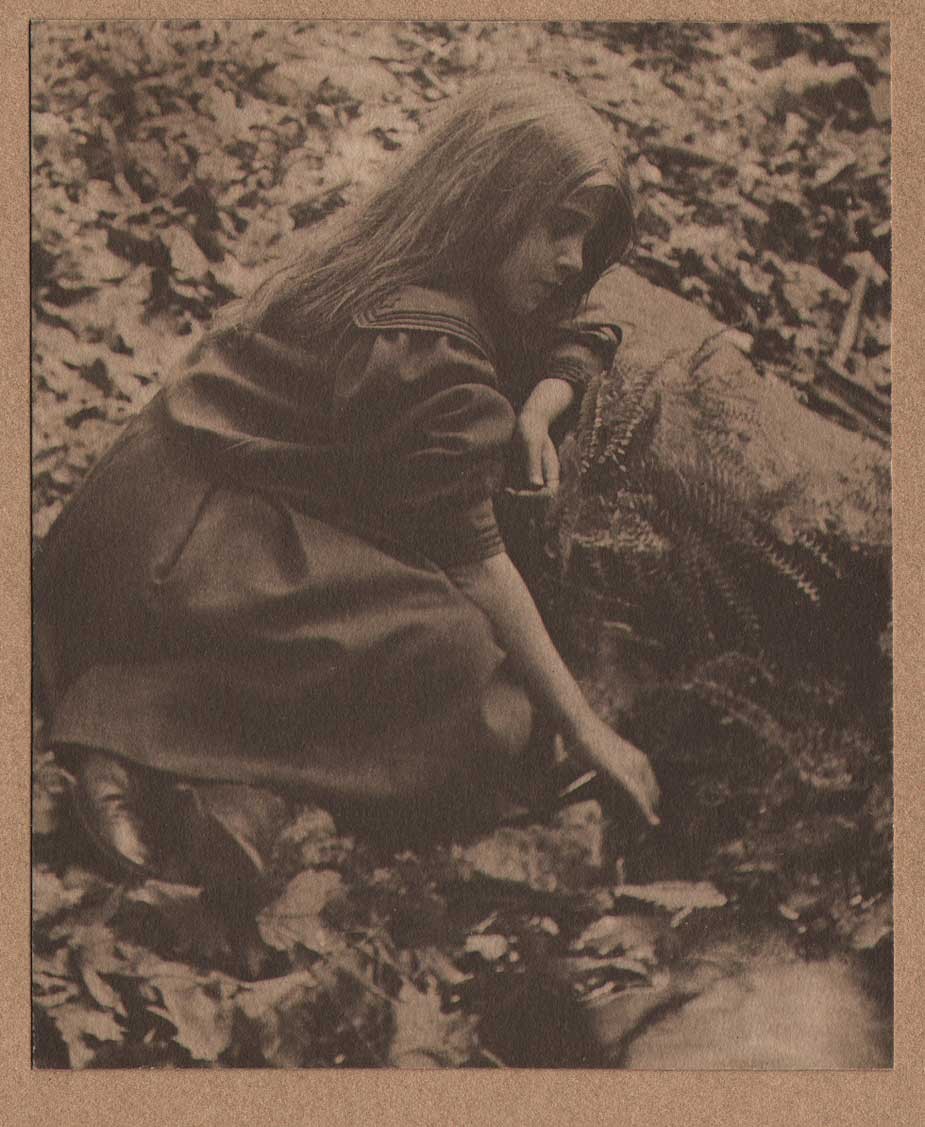 “Dorothy Tucker Gathering Ferns”: Charles Rollins Tucker, American (b. 1868): ca. 1910: mounted brown-toned platinum print: 9.4 x 7.7 cm | 31.2 x 16.0 cm. Born in August, 1899, Dorothy Tucker, a constant photographic subject for her father, then a high school physics teacher at Curtis High School on Staten Island, New York state, holds a spray of freshly-picked ferns while investigating the edge of a stream in the woods. From: PhotoSeed Archive
“Dorothy Tucker Gathering Ferns”: Charles Rollins Tucker, American (b. 1868): ca. 1910: mounted brown-toned platinum print: 9.4 x 7.7 cm | 31.2 x 16.0 cm. Born in August, 1899, Dorothy Tucker, a constant photographic subject for her father, then a high school physics teacher at Curtis High School on Staten Island, New York state, holds a spray of freshly-picked ferns while investigating the edge of a stream in the woods. From: PhotoSeed Archive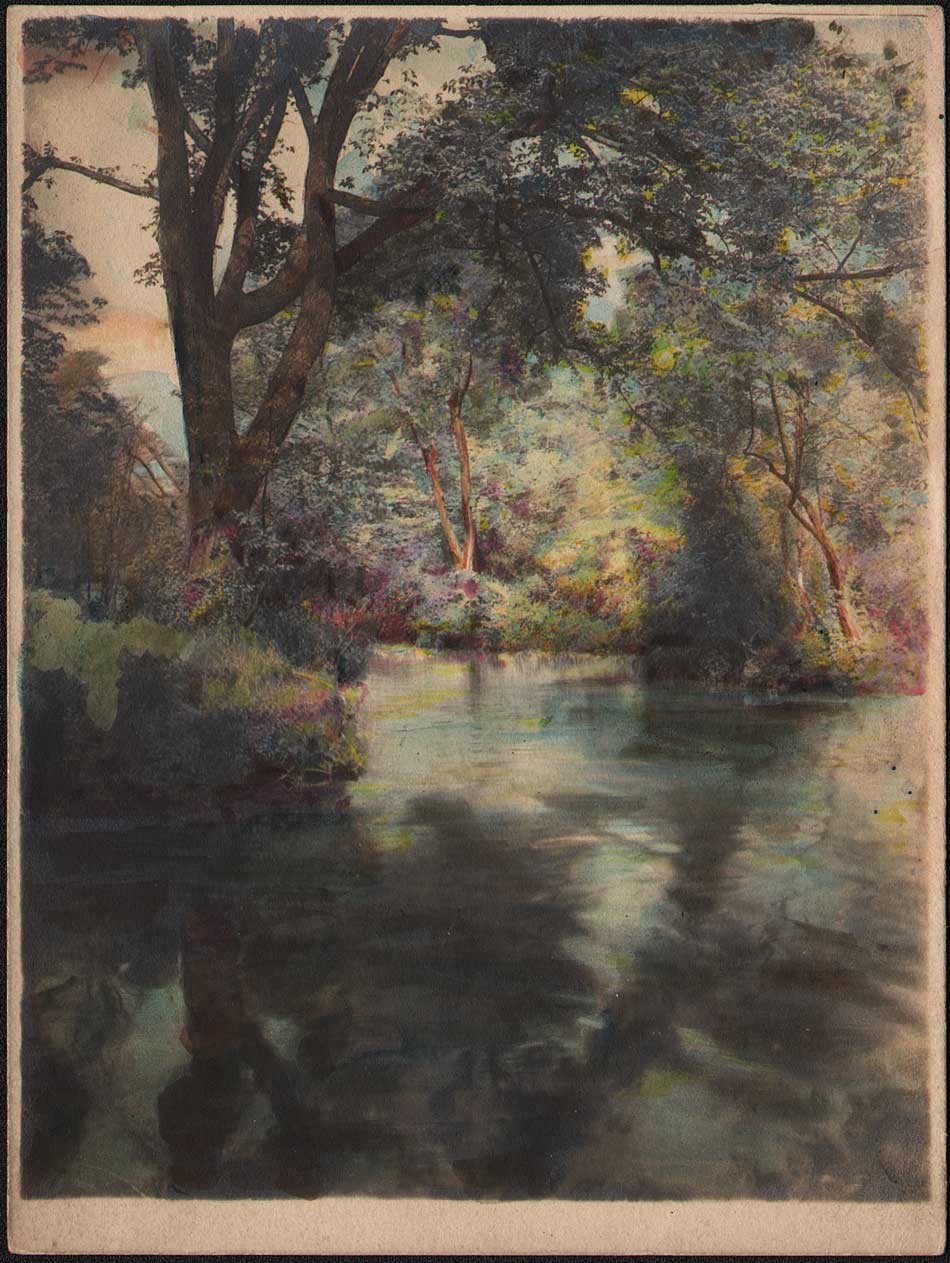 “Stream or Pond at Prospect Park"(Brooklyn, New York): ca. 1910-20: Unknown Brooklyn photographer: hand-colored gelatin silver print: 11.7 x 8.9 cm | 12.4 x 9.3 cm: From: PhotoSeed Archive
“Stream or Pond at Prospect Park"(Brooklyn, New York): ca. 1910-20: Unknown Brooklyn photographer: hand-colored gelatin silver print: 11.7 x 8.9 cm | 12.4 x 9.3 cm: From: PhotoSeed Archive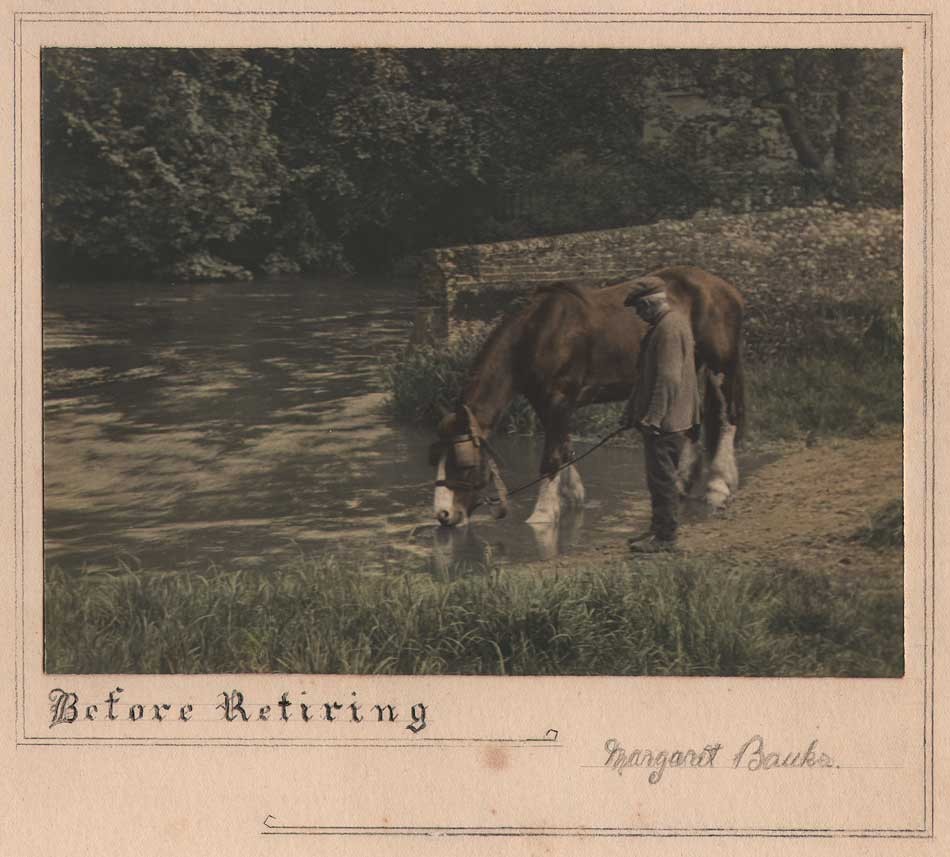 “Before Retiring”: ca. 1910-20: Margaret Bauks, British- (possibly Margaret Florence Bauks: b. 1872?) : hand-colored gelatin silver print: 11.6 x 15.9 cm | 27.8 x 22.8 cm: From: PhotoSeed Archive
“Before Retiring”: ca. 1910-20: Margaret Bauks, British- (possibly Margaret Florence Bauks: b. 1872?) : hand-colored gelatin silver print: 11.6 x 15.9 cm | 27.8 x 22.8 cm: From: PhotoSeed Archive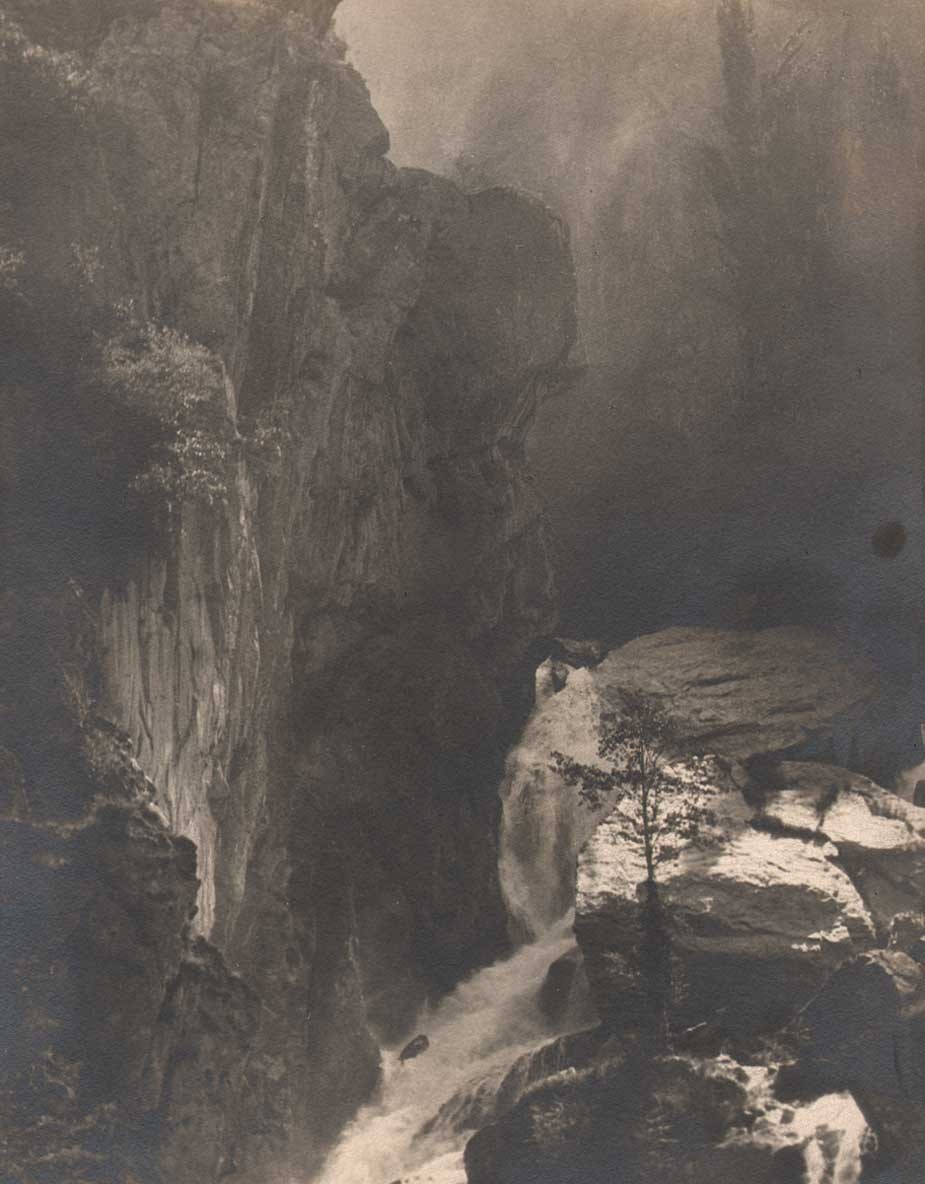 “A Stream of Savoy”: ca. 1927: this print exhibited 1935: Frank Roy Fraprie, American (1874-1951): vintage Bromide print: 24.0 x 18.6 cm | 30.5 x 25.4 cm: As noted in the 1946 American Annual of Photography, (p. 170) Fraprie had been taking photographs in June of 1926 in Eastern France. The area, located in the Haute-Savoie, or Upper Savoy, is a mountainous region of spectacular beauty which includes Lake Annecy, one of France’s largest freshwater lakes. Photographic historian Christian Peterson’s biography of Fraprie gives some background on this important photographer and editor: “Fraprie was the most influential author/publisher of American pictorial photography during the period following the Photo-Secession. From the 1910s to the 1940s, he wrote books and countless articles on all aspects of pictorialism. He edited photographic monthlies and annuals for nearly the entire first half of the twentieth century. In addition, he created his own highly successful pictorial photographs and exhibited them extensively.” From: PhotoSeed Archive
“A Stream of Savoy”: ca. 1927: this print exhibited 1935: Frank Roy Fraprie, American (1874-1951): vintage Bromide print: 24.0 x 18.6 cm | 30.5 x 25.4 cm: As noted in the 1946 American Annual of Photography, (p. 170) Fraprie had been taking photographs in June of 1926 in Eastern France. The area, located in the Haute-Savoie, or Upper Savoy, is a mountainous region of spectacular beauty which includes Lake Annecy, one of France’s largest freshwater lakes. Photographic historian Christian Peterson’s biography of Fraprie gives some background on this important photographer and editor: “Fraprie was the most influential author/publisher of American pictorial photography during the period following the Photo-Secession. From the 1910s to the 1940s, he wrote books and countless articles on all aspects of pictorialism. He edited photographic monthlies and annuals for nearly the entire first half of the twentieth century. In addition, he created his own highly successful pictorial photographs and exhibited them extensively.” From: PhotoSeed Archive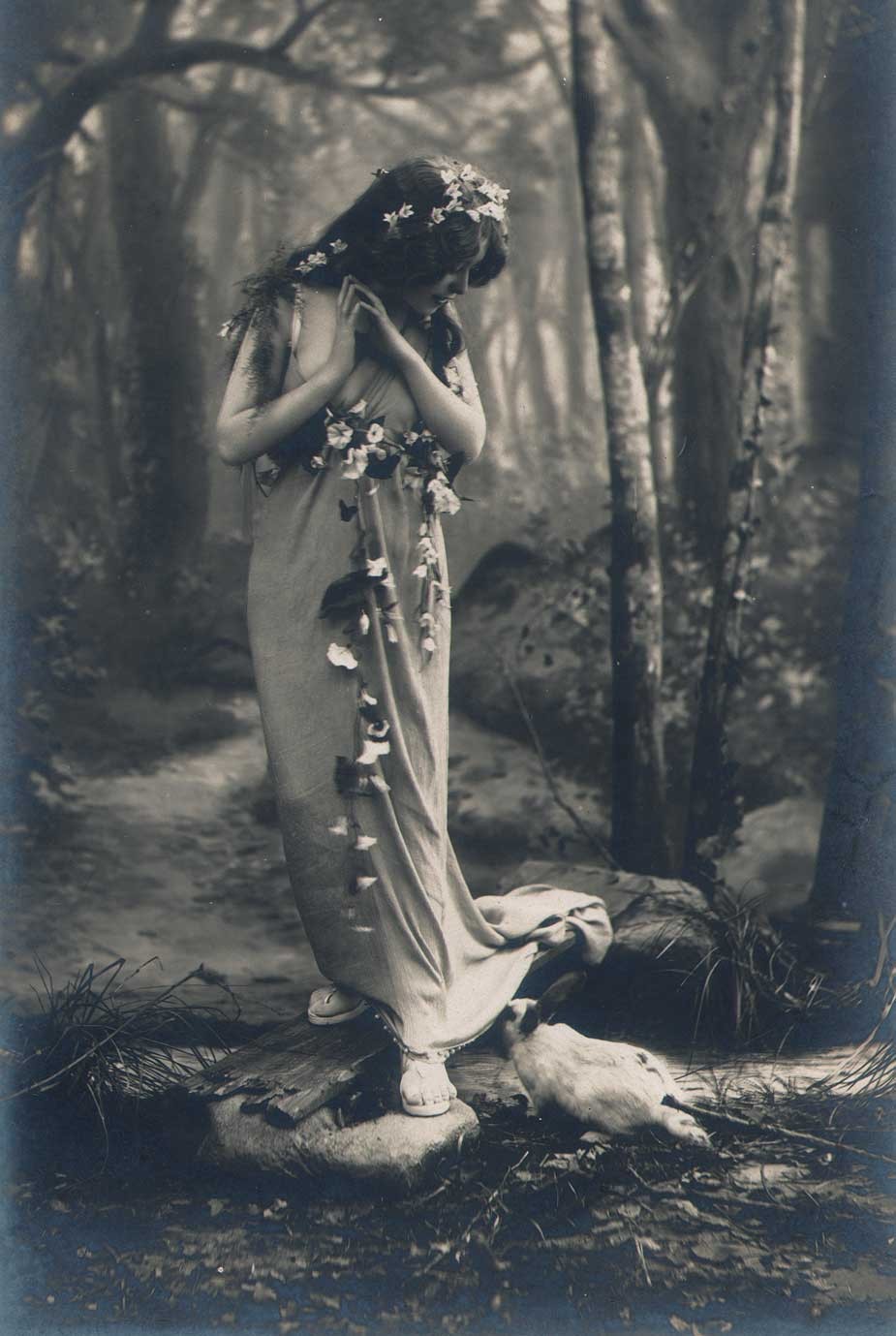 Detail: “Les Fleurs Dans Le Bois” : Léopold-Émile Reutlinger: French (1863-1937): vintage Bromide photograph, ca. 1905. 22.3 x 14.1 | 34.0 x 24.2 cm. Featuring a painted backdrop and wood board placed over a “stream”, this studio photograph features a white rabbit investigating the Belle Epoque era model identified from other variants as “Miss Doll”.(proper identification of this model would be of interest as she has remained a popular subject seen in countless vintage postcards, many hand-tinted) This example was printed by the Milan atelier Maison Tensi and included as a full-page plate in the February, 1905 issue of “La Fotographia Artistica”, a French/Italian photographic journal. From: PhotoSeed Archive
Detail: “Les Fleurs Dans Le Bois” : Léopold-Émile Reutlinger: French (1863-1937): vintage Bromide photograph, ca. 1905. 22.3 x 14.1 | 34.0 x 24.2 cm. Featuring a painted backdrop and wood board placed over a “stream”, this studio photograph features a white rabbit investigating the Belle Epoque era model identified from other variants as “Miss Doll”.(proper identification of this model would be of interest as she has remained a popular subject seen in countless vintage postcards, many hand-tinted) This example was printed by the Milan atelier Maison Tensi and included as a full-page plate in the February, 1905 issue of “La Fotographia Artistica”, a French/Italian photographic journal. From: PhotoSeed Archive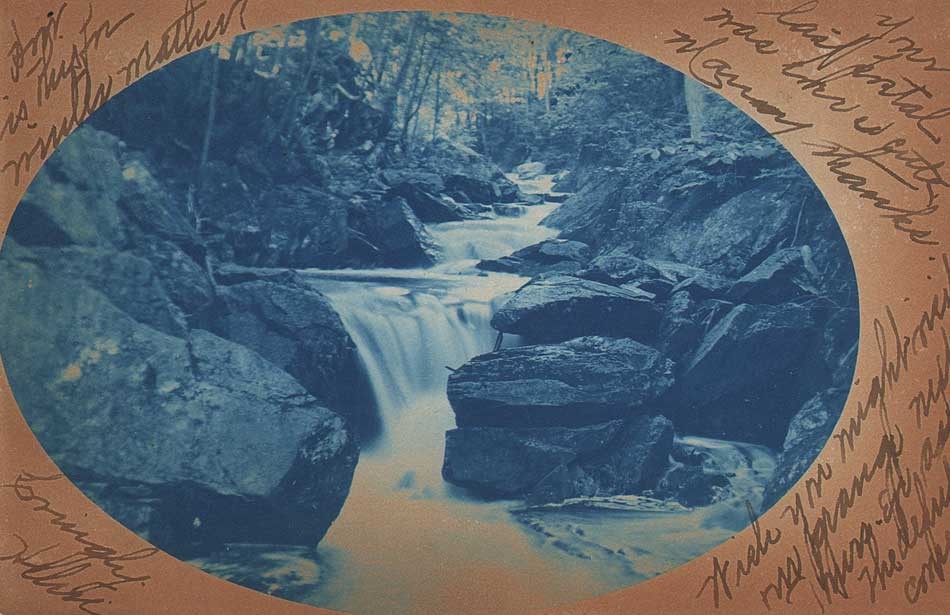 “A Rocky Brook” (New England?) : ca. 1906: Unknown American photographer: vintage cyanotype rppc: 8.9 x 13.8 cm. This idyllic cascading waterfall may depict the Minnewawa Glen in Marlborough, New Hampshire. Signed on the recto: “Lovingly Helen” in the lower left corner, it’s postmarked November 15, 1906 from Marlboro, N.H. addressed to Miss Nettie A. Hastings of East Sullivan, N.H. From: PhotoSeed Archive
“A Rocky Brook” (New England?) : ca. 1906: Unknown American photographer: vintage cyanotype rppc: 8.9 x 13.8 cm. This idyllic cascading waterfall may depict the Minnewawa Glen in Marlborough, New Hampshire. Signed on the recto: “Lovingly Helen” in the lower left corner, it’s postmarked November 15, 1906 from Marlboro, N.H. addressed to Miss Nettie A. Hastings of East Sullivan, N.H. From: PhotoSeed Archive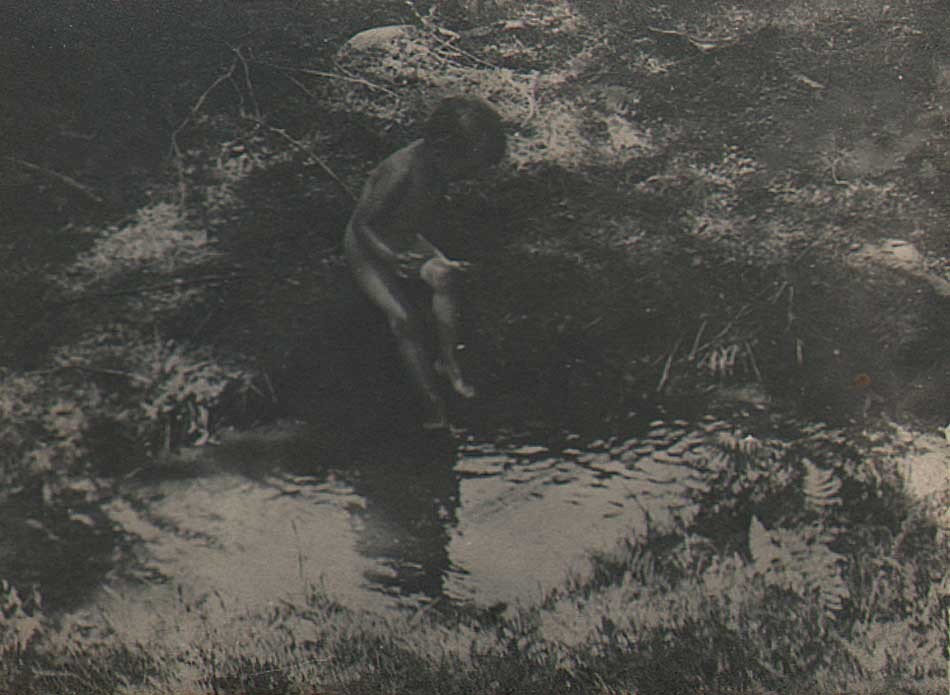 “John Robert Tucker Skinny Dipping”: Charles Rollins Tucker, American (b. 1868): ca. 1915: unmounted platinum print: 3.8 x 5.2 cm. Born in March, 1914, John Robert Tucker, was the second of three children born to the former Mary Carruthers and photographer Charles R. Tucker. Here, the young boy plays in a woodland stream, with the photograph most likely taken in New England. John, according to his 1941 marriage certificate, was an electrical engineer by training. He died in 1991 in La Habra, Orange County, CA. From: PhotoSeed Archive
“John Robert Tucker Skinny Dipping”: Charles Rollins Tucker, American (b. 1868): ca. 1915: unmounted platinum print: 3.8 x 5.2 cm. Born in March, 1914, John Robert Tucker, was the second of three children born to the former Mary Carruthers and photographer Charles R. Tucker. Here, the young boy plays in a woodland stream, with the photograph most likely taken in New England. John, according to his 1941 marriage certificate, was an electrical engineer by training. He died in 1991 in La Habra, Orange County, CA. From: PhotoSeed Archive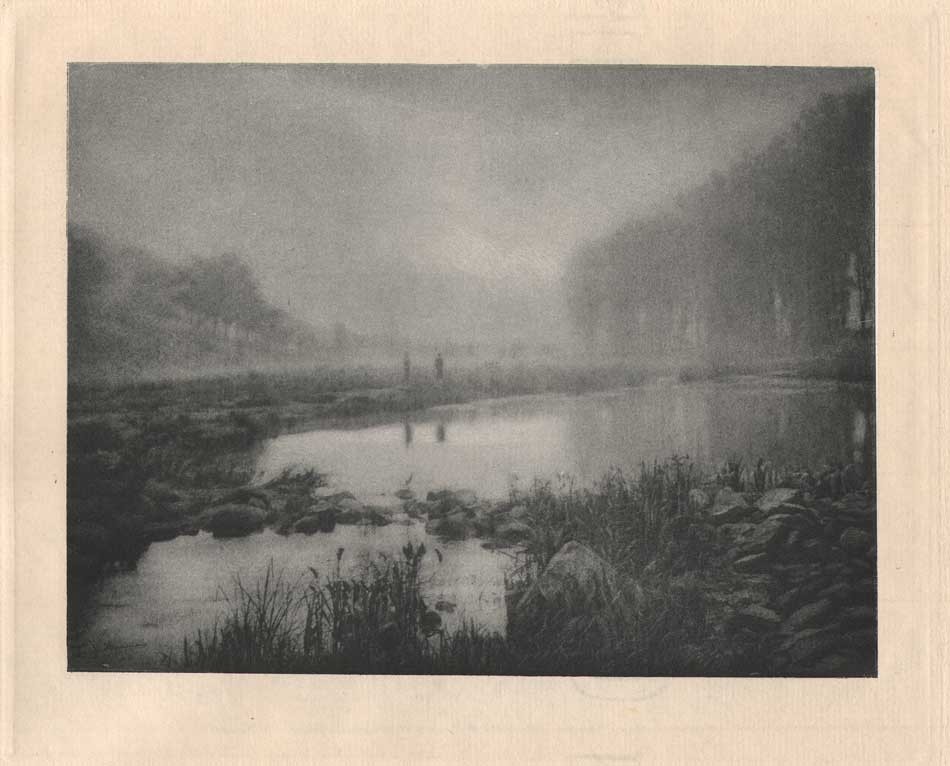 “Brume après la Pluie”: (1906) 1908: Gustave Marissiaux, Belgian (1872-1929) Photogravure on Van Gelder Zonen laid paper: 13.4 x 17.6 | 28.4 x 39.9 cm. Plate XXVI from Marissiaux’s tour-de-force gravure folio “Visions D’Artiste” comprised of 30 plates dating 1899-1908. Translating to “Mist after the Rain”, two figures in the distance stand looking out over an enlarged pond or stream located in "La Terre Wallonne” as identified in the portfolio index: more commonly known today as Wallonia- the southern region of Belgium. From: PhotoSeed Archive
“Brume après la Pluie”: (1906) 1908: Gustave Marissiaux, Belgian (1872-1929) Photogravure on Van Gelder Zonen laid paper: 13.4 x 17.6 | 28.4 x 39.9 cm. Plate XXVI from Marissiaux’s tour-de-force gravure folio “Visions D’Artiste” comprised of 30 plates dating 1899-1908. Translating to “Mist after the Rain”, two figures in the distance stand looking out over an enlarged pond or stream located in "La Terre Wallonne” as identified in the portfolio index: more commonly known today as Wallonia- the southern region of Belgium. From: PhotoSeed Archive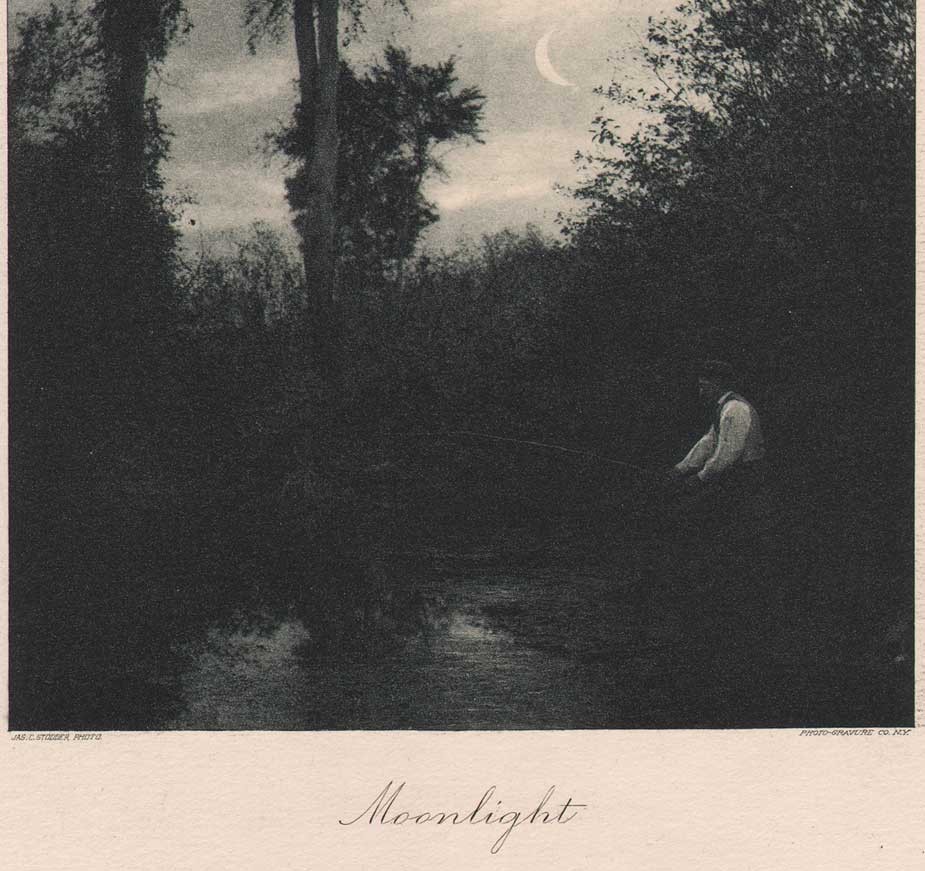 Detail: “Moonlight”: James C. Stodder, American: (1838-1917). 1890. Hand-pulled photogravure published in periodical "Sun & Shade”, New York: November, 1890: whole #27: N.Y. Photogravure Co.: 18.3 x 11.9 | 35.0 x 27.4 cm. A crescent moon rises above a wooded landscape at dusk while a gentleman fishes from the banks of a pond or stream. Stodder graduated from Rensselaer Polytechnic Institute in 1859 and moved to Bangor, Maine, where he first learned the wet-plate process of photography. A lawyer, he was son of a Boston jeweler, (obit) and financially well off. In 1876, he accompanied famed Hudson River School painter Frederic E. Church to the Mount Katahdin region of Maine. From: PhotoSeed Archive
Detail: “Moonlight”: James C. Stodder, American: (1838-1917). 1890. Hand-pulled photogravure published in periodical "Sun & Shade”, New York: November, 1890: whole #27: N.Y. Photogravure Co.: 18.3 x 11.9 | 35.0 x 27.4 cm. A crescent moon rises above a wooded landscape at dusk while a gentleman fishes from the banks of a pond or stream. Stodder graduated from Rensselaer Polytechnic Institute in 1859 and moved to Bangor, Maine, where he first learned the wet-plate process of photography. A lawyer, he was son of a Boston jeweler, (obit) and financially well off. In 1876, he accompanied famed Hudson River School painter Frederic E. Church to the Mount Katahdin region of Maine. From: PhotoSeed Archive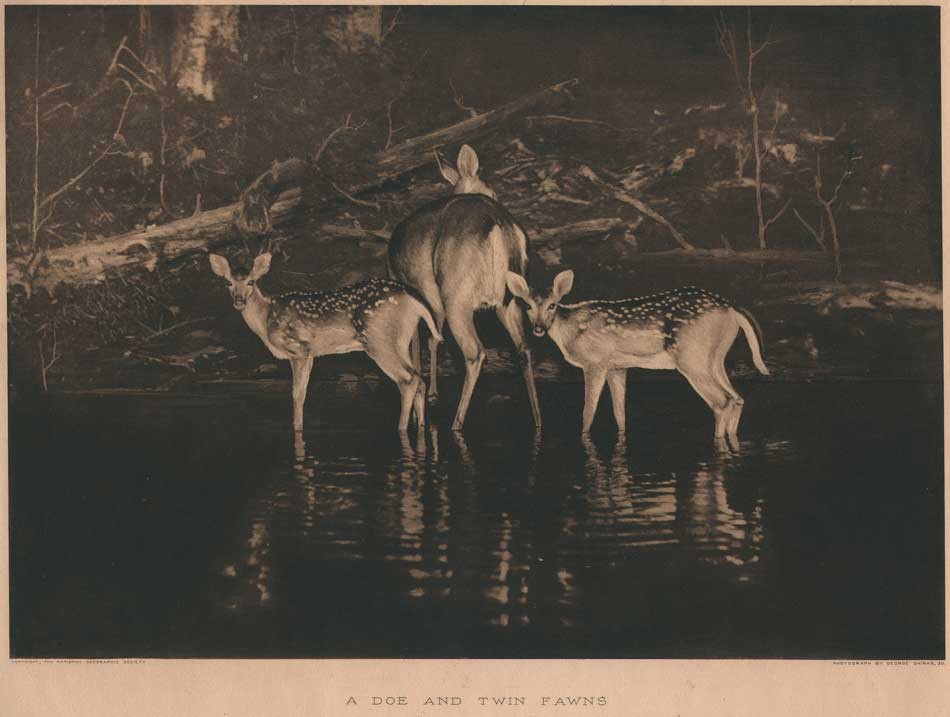 “A Doe and Twin Fawns” (taken 1896) 1916: George Shiras 3rd, American (1859-1942) Vintage photogravure published by the National Geographic Society, Washington, D.C. : 21.2 x 30.3 | 40.5 x 50.8 cm. A pioneer of using flashlight photography to record wildlife in their natural environments at night, Shiras used the method of “Jacklighting”, a form of hunting using a fixed continuous light source mounted in the bow of a canoe to draw the attention of wildlife: in this case three deer, while then utilizing magnesium flash-powder to freeze the scene in-camera. His series of twelve midnight views, including “A Doe and Twin Fawns”-also known as “Innocents Abroad” would earn Shiras international acclaim and many important awards. A one-term Congressman for the state of Michigan, (his father George Shiras Sr. was a former Justice of the U.S. Supreme Court) he was also an important naturalist who helped placed migratory birds and fish under Federal control. (The eventual 1918 Migratory Bird Treaty Act had groundings in legislation Shiras introduced to Congress in 1903 as the first comprehensive migratory bird law not voted on.) For additional background, see article by Matthew Brower in the journal History of Photography, Summer,2008: “George Shiras and the Circulation of Wildlife Photography”. From: PhotoSeed Archive
“A Doe and Twin Fawns” (taken 1896) 1916: George Shiras 3rd, American (1859-1942) Vintage photogravure published by the National Geographic Society, Washington, D.C. : 21.2 x 30.3 | 40.5 x 50.8 cm. A pioneer of using flashlight photography to record wildlife in their natural environments at night, Shiras used the method of “Jacklighting”, a form of hunting using a fixed continuous light source mounted in the bow of a canoe to draw the attention of wildlife: in this case three deer, while then utilizing magnesium flash-powder to freeze the scene in-camera. His series of twelve midnight views, including “A Doe and Twin Fawns”-also known as “Innocents Abroad” would earn Shiras international acclaim and many important awards. A one-term Congressman for the state of Michigan, (his father George Shiras Sr. was a former Justice of the U.S. Supreme Court) he was also an important naturalist who helped placed migratory birds and fish under Federal control. (The eventual 1918 Migratory Bird Treaty Act had groundings in legislation Shiras introduced to Congress in 1903 as the first comprehensive migratory bird law not voted on.) For additional background, see article by Matthew Brower in the journal History of Photography, Summer,2008: “George Shiras and the Circulation of Wildlife Photography”. From: PhotoSeed Archive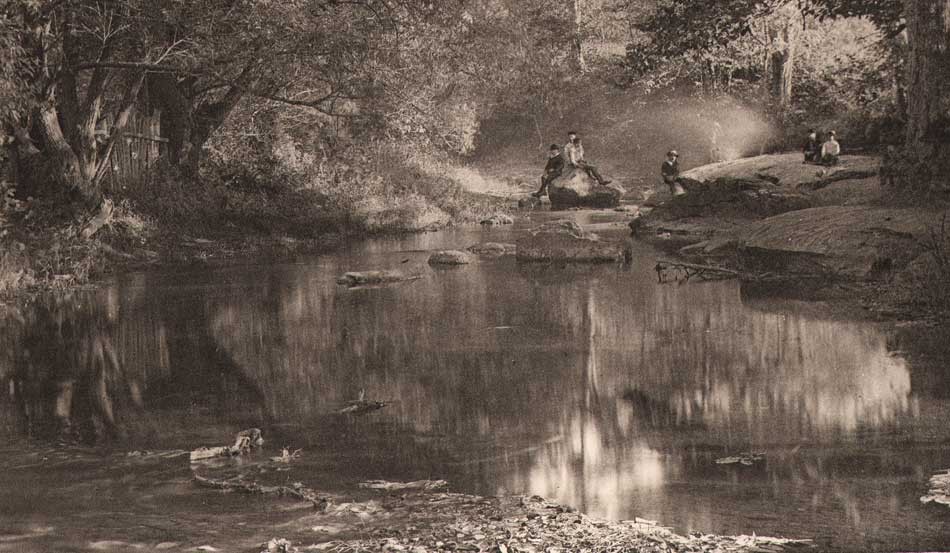 Detail: “A Corn Roast” Oliver Patterson Watts, American: (1865-1953). 1892. Hand-pulled photogravure published in periodical "Sun & Shade”, New York: June, 1892: whole #46: N.Y. Photogravure Co.: 14.7 x 23.2 | 34.6 x 27.4 cm. The index for the issue of Sun & Shade in which this photograph appears states: “Mr. Watts writes us that while wandering with his camera along “The Green,” a favorite picnic ground near Thomastown,(sic) Maine, he came upon this group of boys roasting corn and potatoes. At the sight of the camera they immediately grouped themselves, anxious to be “took.” The negative was made with a Scovill Favorite Camera, Waterbury lens, with an exposure of five seconds on a seed plate. It was developed with Pyro and Sodium Carbonate.” Dr. Oliver Patterson Watts was born in Thomaston, Maine, and graduated from Bowdoin College in 1889. Interestingly, in 1890, Potts and Dr. Julius Stieglitz, the brother of Alfred Stieglitz, were fellow scholars in chemistry at the newly opened Clark University in Worcester, MA. He later entered the University of Wisconsin in 1905 and took charge of the Carnegie Research on Electrolytic Iron under Dr. Charles F. Burgess. According to an Oct. 2009 article on Potts for the online resource Plating & Surface Finishing, the most important of his fifty-nine papers on plating and corrosion is probably “Rapid Nickel Plating,” presented before the Electrochemical Society in 1915. From: PhotoSeed Archive
Detail: “A Corn Roast” Oliver Patterson Watts, American: (1865-1953). 1892. Hand-pulled photogravure published in periodical "Sun & Shade”, New York: June, 1892: whole #46: N.Y. Photogravure Co.: 14.7 x 23.2 | 34.6 x 27.4 cm. The index for the issue of Sun & Shade in which this photograph appears states: “Mr. Watts writes us that while wandering with his camera along “The Green,” a favorite picnic ground near Thomastown,(sic) Maine, he came upon this group of boys roasting corn and potatoes. At the sight of the camera they immediately grouped themselves, anxious to be “took.” The negative was made with a Scovill Favorite Camera, Waterbury lens, with an exposure of five seconds on a seed plate. It was developed with Pyro and Sodium Carbonate.” Dr. Oliver Patterson Watts was born in Thomaston, Maine, and graduated from Bowdoin College in 1889. Interestingly, in 1890, Potts and Dr. Julius Stieglitz, the brother of Alfred Stieglitz, were fellow scholars in chemistry at the newly opened Clark University in Worcester, MA. He later entered the University of Wisconsin in 1905 and took charge of the Carnegie Research on Electrolytic Iron under Dr. Charles F. Burgess. According to an Oct. 2009 article on Potts for the online resource Plating & Surface Finishing, the most important of his fifty-nine papers on plating and corrosion is probably “Rapid Nickel Plating,” presented before the Electrochemical Society in 1915. From: PhotoSeed Archive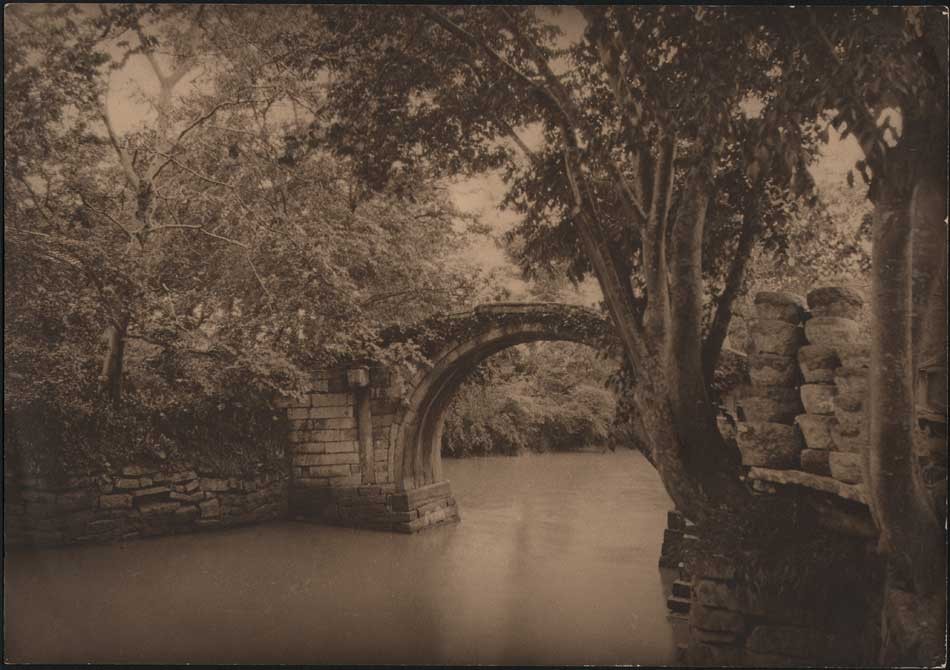 “Mutu Bridge”: Donald Mennie, Scottish (1875-1944) 1922: Vintage unmounted bromide print: 24.2 x 34.6 cm. This picturesque Chinese river scene first appeared as a full-page plate variant in the 1914 volume “My Lady of the Chinese Courtyard” (between pp. 254-5) by author Elizabeth Cooper and then as Plate #7 “Mutu Bridge” in the photographer’s ca. 1914 work “Picturesque China: A Series of Vandyck Photogravures illustrating Chinese Life and Surroundings”. From: PhotoSeed Archive
“Mutu Bridge”: Donald Mennie, Scottish (1875-1944) 1922: Vintage unmounted bromide print: 24.2 x 34.6 cm. This picturesque Chinese river scene first appeared as a full-page plate variant in the 1914 volume “My Lady of the Chinese Courtyard” (between pp. 254-5) by author Elizabeth Cooper and then as Plate #7 “Mutu Bridge” in the photographer’s ca. 1914 work “Picturesque China: A Series of Vandyck Photogravures illustrating Chinese Life and Surroundings”. From: PhotoSeed Archive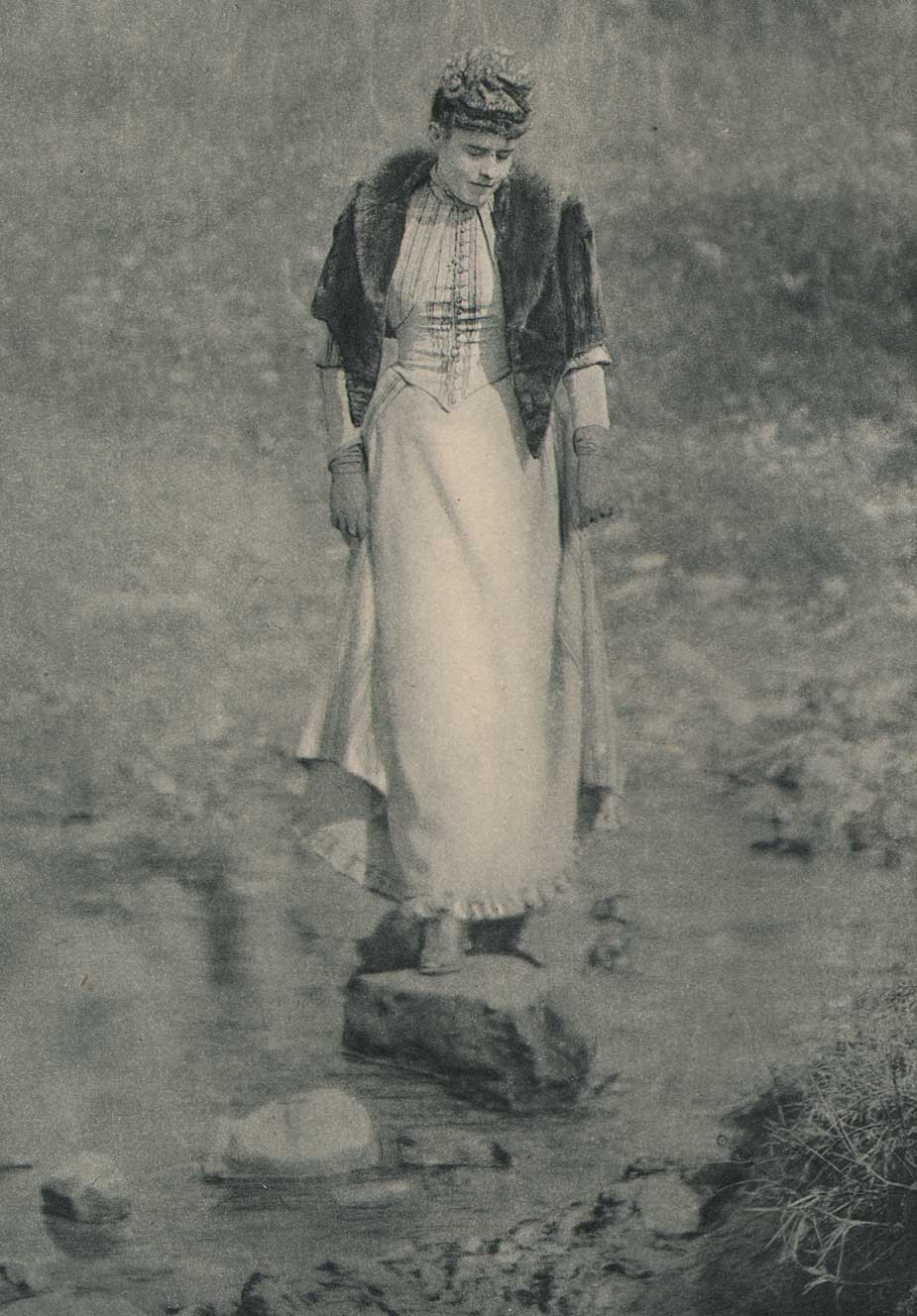 Detail: “Stepping Stones” George Bacon Wood Jr., American: (1832-1909). 1894. Hand-pulled photogravure published in periodical "Sun & Shade”, New York: January, 1894: whole #65: N.Y. Photogravure Co.: 20.5 x 11.7 | 34.9 x 27.5 cm. The index for the issue of Sun & Shade in which this photograph appears states: “To the meditative woman crossing the brook with careful steps upon the projecting stones, Oliver Wendell Holmes’ words, in his “Professor at the Breakfast Table,” can be appropriately applied: “The wisest woman you talk with is ignorant of something that you know, but an elegant woman never forgets her elegance.” With no eye to see her, as she crosses the woodland stream, the figure in the picture appears reposeful, full of thought, and unconsciously elegant in pose. This is a charming photograph from nature, simple, truthful and artistic.” From: PhotoSeed Archive
Detail: “Stepping Stones” George Bacon Wood Jr., American: (1832-1909). 1894. Hand-pulled photogravure published in periodical "Sun & Shade”, New York: January, 1894: whole #65: N.Y. Photogravure Co.: 20.5 x 11.7 | 34.9 x 27.5 cm. The index for the issue of Sun & Shade in which this photograph appears states: “To the meditative woman crossing the brook with careful steps upon the projecting stones, Oliver Wendell Holmes’ words, in his “Professor at the Breakfast Table,” can be appropriately applied: “The wisest woman you talk with is ignorant of something that you know, but an elegant woman never forgets her elegance.” With no eye to see her, as she crosses the woodland stream, the figure in the picture appears reposeful, full of thought, and unconsciously elegant in pose. This is a charming photograph from nature, simple, truthful and artistic.” From: PhotoSeed Archive “Derniers Rayons Dans la Forêt”: Guglielmo Oliaro, Italian: (1874 -1936) vintage Bromide photograph, ca. 1900? 1907: 16.6 x 22.5 | 23.5 x 32.7 cm. Translating to “Last Rays In The Forest”, this bucolic scene at dusk features a rushing stream and footbridge bisecting a a silhouetted line of Pollarded Willow trees. From Turin, amateur photographer Dr. Guglielmo Oliaro was very interested in the arts, founding a medical publishing house that survives to this day: From the InterFairs online resource: “Minerva Medica was the brainchild of a Turin GP (General Practitioner -ed.) Dr. Guglielmo Oliaro, a scientist with a passion for literature, art and music. It was on December 8 1925 that Dr. Oliaro got together with a small group of partners to set up the original company, Tipografia Editrice Minerva based in Turin. The creation of that company was a response to the growing success both in Italy and abroad, of Minerva Medica, a weekly journal for the general practitioner that first came out in 1909. Edizioni Minerva Medica S.p.A. was set up as a limited company by Dr. Guglielmo Oliaro on June 9 1934, for the purpose of supplying the Italian medical profession with text-books and scientific journals.” This example of Oliaro’s work was printed by the Milan atelier Maison Tensi and included as a full-page plate in the April, 1907 issue of “La Fotographia Artistica”, a French/Italian photographic journal. From: PhotoSeed Archive
“Derniers Rayons Dans la Forêt”: Guglielmo Oliaro, Italian: (1874 -1936) vintage Bromide photograph, ca. 1900? 1907: 16.6 x 22.5 | 23.5 x 32.7 cm. Translating to “Last Rays In The Forest”, this bucolic scene at dusk features a rushing stream and footbridge bisecting a a silhouetted line of Pollarded Willow trees. From Turin, amateur photographer Dr. Guglielmo Oliaro was very interested in the arts, founding a medical publishing house that survives to this day: From the InterFairs online resource: “Minerva Medica was the brainchild of a Turin GP (General Practitioner -ed.) Dr. Guglielmo Oliaro, a scientist with a passion for literature, art and music. It was on December 8 1925 that Dr. Oliaro got together with a small group of partners to set up the original company, Tipografia Editrice Minerva based in Turin. The creation of that company was a response to the growing success both in Italy and abroad, of Minerva Medica, a weekly journal for the general practitioner that first came out in 1909. Edizioni Minerva Medica S.p.A. was set up as a limited company by Dr. Guglielmo Oliaro on June 9 1934, for the purpose of supplying the Italian medical profession with text-books and scientific journals.” This example of Oliaro’s work was printed by the Milan atelier Maison Tensi and included as a full-page plate in the April, 1907 issue of “La Fotographia Artistica”, a French/Italian photographic journal. From: PhotoSeed Archive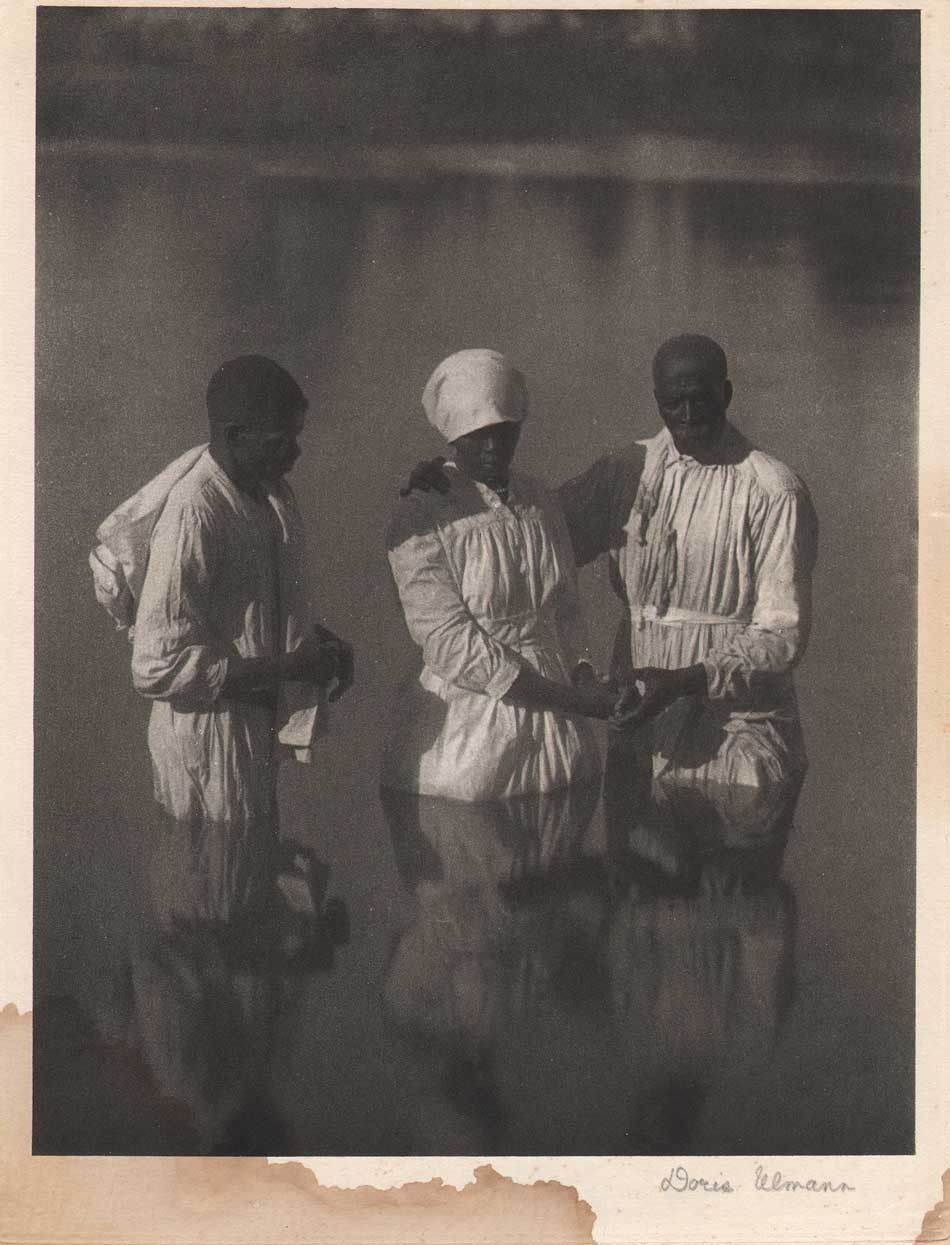 “Baptismal Scene” : Doris Ulmann, American: (1882 –1934) 1933: Signed, hand-pulled photogravure included as additional loose plate from deluxe edition of “Roll, Jordan, Roll”: 21.3 x 16.4 | 28.3 x 20.7 cm. In a rather interesting coincidence, this particular example of a summer stream showing a well-known river baptism by Ulmann has been partially immersed by moisture along the lower margin. From p. 116 of the volume: “A candidate for admission into the church must first be baptized. The Methodists have water sprinkled on their heads, but Baptists must be publicly immersed. These “baptisms” attract large crowds of onlookers. The candidates all arrive at the “pool” dressed in long white robes, which are carefully put away after the ceremony to serve as their shrouds some day. When they are assembled, the preacher and the leader, also dressed in white robes, lead the first candidate down into the water, where he is dipped three times, once in the name of the Father, once in the name of the Son, and once in the name of the Holy Ghost. As he is lead up out of the water, all his sins are left behind, drowned and buried in a watery grave. His soul is cleansed white as snow and he is ready to be received into full church membership. Unless he “falls” into sin and gets “turned out” of the church, he will some day be received into fellowship with God’s holy angels up in heaven.” The following review of Roll, Jordon, Roll comes from Steve Watson and was included on the Amon Carter Museum of American Art website, first published in 2016: Photographer Doris Ulmann came from an affluent white New York City family. She took teacher training with photographer Lewis Hine at the Ethical Culture School and subsequently studied psychology and law at Columbia University. She also studied photography with Clarence H. White, a founding member of the Photo-Secession movement known for teaching the Pictorialist style. Ulmann collaborated with novelist Julia Peterkin on a book project titled Roll, Jordan, Roll(New York: R.O. Ballou, 1933). The book focuses on the lives of former slaves and their descendants on a plantation in the Gullah coastal region of South Carolina. Peterkin, who won the Pulitzer Prize for her novel Scarlet Sister Mary (Indianapolis: Bobbs-Merrill, 1928), was born in South Carolina and raised by a black nursemaid who taught her the Gullah dialect. She married the heir to Lang Syne, a 2,000-acre cotton plantation, which became the setting for Roll, Jordan, Roll. Ulmann began photographing there in 1929. Roll, Jordan, Roll is titled after the spiritual written by English Methodist leader Charles Wesley in the 18th century which became well-known among slaves in the United States during the 19th century. Appropriated as a coded message for escape, by the end of the American Civil War it had become known through much of the eastern United States. In the 20th century it helped inspire the blues, and it remains a staple in gospel music. Roll, Jordan, Roll was illustrated with 90 photogravure plates made from Ulmann’s large-format negatives. Although they comprise an amazing ethnographic study, today Ulmann’s Pictorialist aesthetic seems a strange choice for making documentary images. The hazy, soft-focus photographs lend a sentimental, nostalgic impression that belies the underlying exploitative history of her subjects. From: PhotoSeed Archive
“Baptismal Scene” : Doris Ulmann, American: (1882 –1934) 1933: Signed, hand-pulled photogravure included as additional loose plate from deluxe edition of “Roll, Jordan, Roll”: 21.3 x 16.4 | 28.3 x 20.7 cm. In a rather interesting coincidence, this particular example of a summer stream showing a well-known river baptism by Ulmann has been partially immersed by moisture along the lower margin. From p. 116 of the volume: “A candidate for admission into the church must first be baptized. The Methodists have water sprinkled on their heads, but Baptists must be publicly immersed. These “baptisms” attract large crowds of onlookers. The candidates all arrive at the “pool” dressed in long white robes, which are carefully put away after the ceremony to serve as their shrouds some day. When they are assembled, the preacher and the leader, also dressed in white robes, lead the first candidate down into the water, where he is dipped three times, once in the name of the Father, once in the name of the Son, and once in the name of the Holy Ghost. As he is lead up out of the water, all his sins are left behind, drowned and buried in a watery grave. His soul is cleansed white as snow and he is ready to be received into full church membership. Unless he “falls” into sin and gets “turned out” of the church, he will some day be received into fellowship with God’s holy angels up in heaven.” The following review of Roll, Jordon, Roll comes from Steve Watson and was included on the Amon Carter Museum of American Art website, first published in 2016: Photographer Doris Ulmann came from an affluent white New York City family. She took teacher training with photographer Lewis Hine at the Ethical Culture School and subsequently studied psychology and law at Columbia University. She also studied photography with Clarence H. White, a founding member of the Photo-Secession movement known for teaching the Pictorialist style. Ulmann collaborated with novelist Julia Peterkin on a book project titled Roll, Jordan, Roll(New York: R.O. Ballou, 1933). The book focuses on the lives of former slaves and their descendants on a plantation in the Gullah coastal region of South Carolina. Peterkin, who won the Pulitzer Prize for her novel Scarlet Sister Mary (Indianapolis: Bobbs-Merrill, 1928), was born in South Carolina and raised by a black nursemaid who taught her the Gullah dialect. She married the heir to Lang Syne, a 2,000-acre cotton plantation, which became the setting for Roll, Jordan, Roll. Ulmann began photographing there in 1929. Roll, Jordan, Roll is titled after the spiritual written by English Methodist leader Charles Wesley in the 18th century which became well-known among slaves in the United States during the 19th century. Appropriated as a coded message for escape, by the end of the American Civil War it had become known through much of the eastern United States. In the 20th century it helped inspire the blues, and it remains a staple in gospel music. Roll, Jordan, Roll was illustrated with 90 photogravure plates made from Ulmann’s large-format negatives. Although they comprise an amazing ethnographic study, today Ulmann’s Pictorialist aesthetic seems a strange choice for making documentary images. The hazy, soft-focus photographs lend a sentimental, nostalgic impression that belies the underlying exploitative history of her subjects. From: PhotoSeed Archive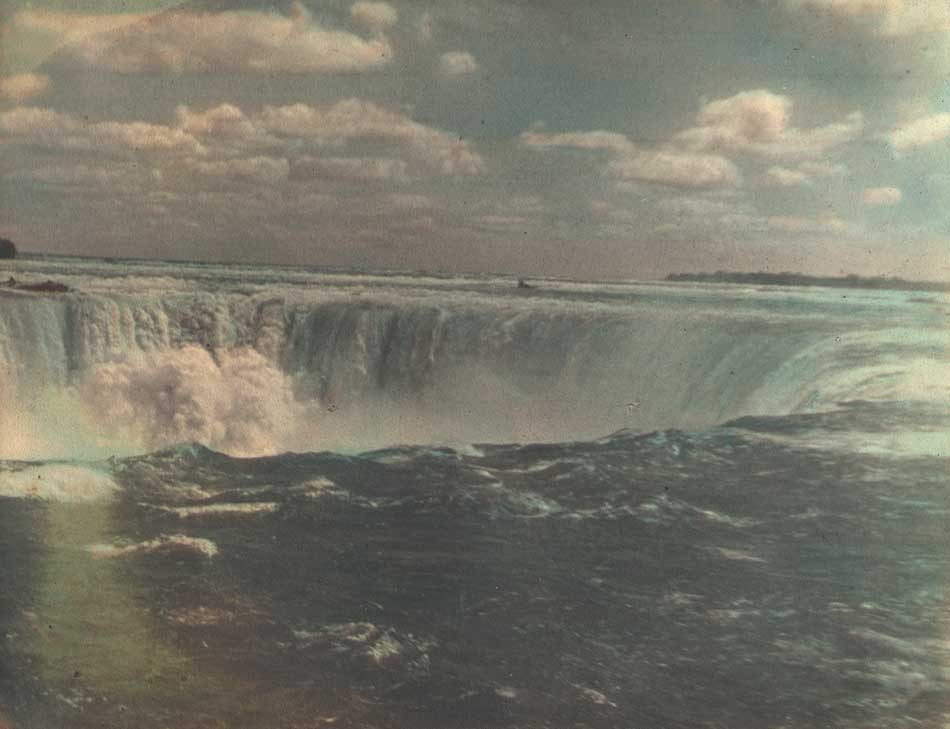 “Niagara Falls”: attributed to Arthur Hammond, American: born England: 1880-1962: hand-colored gelatin silver print mounted to album leaf, ca. 1930-1940: 19.2 x 24.2 | 25.0 x 32.7 cm. To conclude our post is a view of the ultimate Summer Stream: a view showing the Niagara River’s Horseshoe Falls from the Canadian side. From a personal album of nearly 100 photographs attributed to Hammond dating from around 1910-1940. Born in London, photographer Arthur Hammond arrived in America at Ellis Island in New York Harbor on July 31, 1909 and established himself with his own studio in Natick, MA outside Boston by 1912. In 1920, he authored the foundational book "Pictorial Composition in Photography" and became a leading voice for pictorialism in America through his position as associate editor of American Photography magazine that lasted 30 years from 1918-1949. From: PhotoSeed Archive
“Niagara Falls”: attributed to Arthur Hammond, American: born England: 1880-1962: hand-colored gelatin silver print mounted to album leaf, ca. 1930-1940: 19.2 x 24.2 | 25.0 x 32.7 cm. To conclude our post is a view of the ultimate Summer Stream: a view showing the Niagara River’s Horseshoe Falls from the Canadian side. From a personal album of nearly 100 photographs attributed to Hammond dating from around 1910-1940. Born in London, photographer Arthur Hammond arrived in America at Ellis Island in New York Harbor on July 31, 1909 and established himself with his own studio in Natick, MA outside Boston by 1912. In 1920, he authored the foundational book "Pictorial Composition in Photography" and became a leading voice for pictorialism in America through his position as associate editor of American Photography magazine that lasted 30 years from 1918-1949. From: PhotoSeed Archive
By the Stream
Paul Laurence Dunbar (1872-1906)
By the stream I dream in calm delight, and watch as in a glass,
How the clouds like crowds of snowy-hued and white-robed
maidens pass,
And the water into ripples breaks and sparkles as it spreads,
Like a host of armored knights with silver helmets on their heads.
And I deem the stream an emblem fit of human life may go,
For I find a mind may sparkle much and yet but shallows show,
And a soul may glow with myriad lights and wondrous mysteries,
When it only lies a dormant thing and mirrors what it sees.
Camera Work: Back in Print
Posted May 2018 in Advertising, History of Photography, Journals, Significant Photographers
Like the mythological bird the Phoenix, the groundbreaking photography and art journal Camera Work edited and published by Alfred Stieglitz of New York from 1903-17 is now available for purchase as a full run after long being out of print.
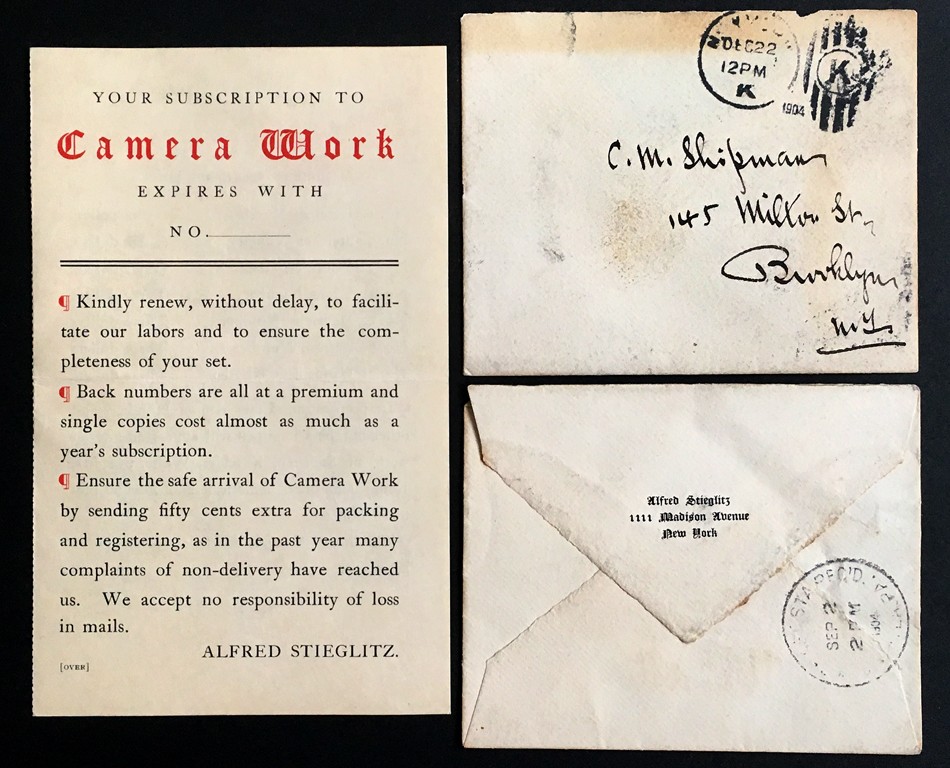 Rare Camera Work Ephemera: Left: This blank Camera Work subscription form for the year 1905 was mailed by publisher Alfred Stieglitz to photographer C.M. Shipman in Brooklyn, New York. (145 Milton St.) recto: 15.9 x 9.9 cm | opened: 9.9 x 19.8 cm | printed on Japan paper. Upper Right: The original mailing envelope (8.7 x 10.8 cm) addressed to Shipman in Stieglitz’s hand is stamped with a New York postmark of December 22, 1904. Lower Right: Another similar envelope addressed to photographer Adolph Petzold in Philadelphia and postmarked New York, September, 1904 is engraved on the verso: Alfred Stieglitz- 1111 Madison Avenue - New York. From: PhotoSeed Archive
Rare Camera Work Ephemera: Left: This blank Camera Work subscription form for the year 1905 was mailed by publisher Alfred Stieglitz to photographer C.M. Shipman in Brooklyn, New York. (145 Milton St.) recto: 15.9 x 9.9 cm | opened: 9.9 x 19.8 cm | printed on Japan paper. Upper Right: The original mailing envelope (8.7 x 10.8 cm) addressed to Shipman in Stieglitz’s hand is stamped with a New York postmark of December 22, 1904. Lower Right: Another similar envelope addressed to photographer Adolph Petzold in Philadelphia and postmarked New York, September, 1904 is engraved on the verso: Alfred Stieglitz- 1111 Madison Avenue - New York. From: PhotoSeed Archive
Remarkably and metaphorically, this bird, capably guided by St. Louis resident Pierre Vreyen, has risen again even though its first creator, while acknowledging the passion it took to create it was a most admirable thing, nonetheless went on to dispose of at least one known full run of Camera Work by setting it alight in 1929 at his Lake George estate. In 1933, writing in a two-page letter on July 10 from there to writer and critic Lewis Mumford, Stieglitz outlines the emotional capital he expended on his involvement with and creation of Camera Work:
“Four years ago the complete set of Camera Work I had had up here for years I offered to the Evening Star. It was a wonderful sight to watch the volumes burn. As you know books burn slowly…What a continuous heartache Camera Work represented & what blood was spilled over each issue fighting printers & fighting engravers—fighting paper dealers & paper manufacturers—fighting ink manufacturers & binders—fighting those who did the packing—fighting the post office—every step I controlled personally—as I sat there & realized what passion it all represented—I had to smile at myself.—Ye gods what won’t passion do.” (1.)
Originally from Liege, Belgium and trained as an electrician and draftsman but more recently plying his trade as a commercial photographer, Pierre explained to me his inspiration for bringing Camera Work back to life, so to speak:
“It all started when Mark (Katzman) said he would love to have a digital copy of Camera Work so he could open it anytime without the fear of over-manipulating his set of originals. I told him I would give him a hand doing it and it took 2 years to make.”
With the establishment of his website cameraworkmagazine.com, which includes short videos of him leafing through each newly published issue of Camera Work, one can order the full run of the journal in facsimile: the most complete and faithful copy of the original ever published. The cost is $1200, which includes a separate index issue, plus shipping.
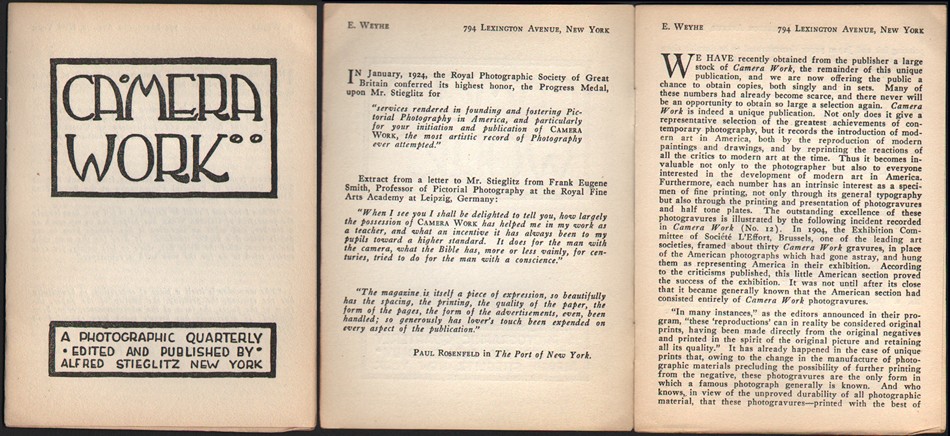 “Earliest known Camera Work Sales Catalogue” ( post publication): ca. 1924, uncoated paper: 13.8 x 10.1 cm (Cover). New York: E. Weyhe Gallery. This small pamphlet shows a facsimile of the CW cover at left while opened to the first gatefold at right. The prospectus by the E. Weyhe Gallery, located at 794 Lexington Avenue in New York City, reprinted press notices for CW along with a synopsis of available issues and prices, including the final Paul Strand double issue 49-50 from 1917 for $17.50: An excerpt: "We Have recently obtained from the publisher a large stock of Camera Work, the remainder of this unique chance to obtain copies, both singly and in sets. Many of these numbers had already become scarce, and there never will be an opportunity to obtain so large a selection again." From: PhotoSeed Archive
“Earliest known Camera Work Sales Catalogue” ( post publication): ca. 1924, uncoated paper: 13.8 x 10.1 cm (Cover). New York: E. Weyhe Gallery. This small pamphlet shows a facsimile of the CW cover at left while opened to the first gatefold at right. The prospectus by the E. Weyhe Gallery, located at 794 Lexington Avenue in New York City, reprinted press notices for CW along with a synopsis of available issues and prices, including the final Paul Strand double issue 49-50 from 1917 for $17.50: An excerpt: "We Have recently obtained from the publisher a large stock of Camera Work, the remainder of this unique chance to obtain copies, both singly and in sets. Many of these numbers had already become scarce, and there never will be an opportunity to obtain so large a selection again." From: PhotoSeed Archive
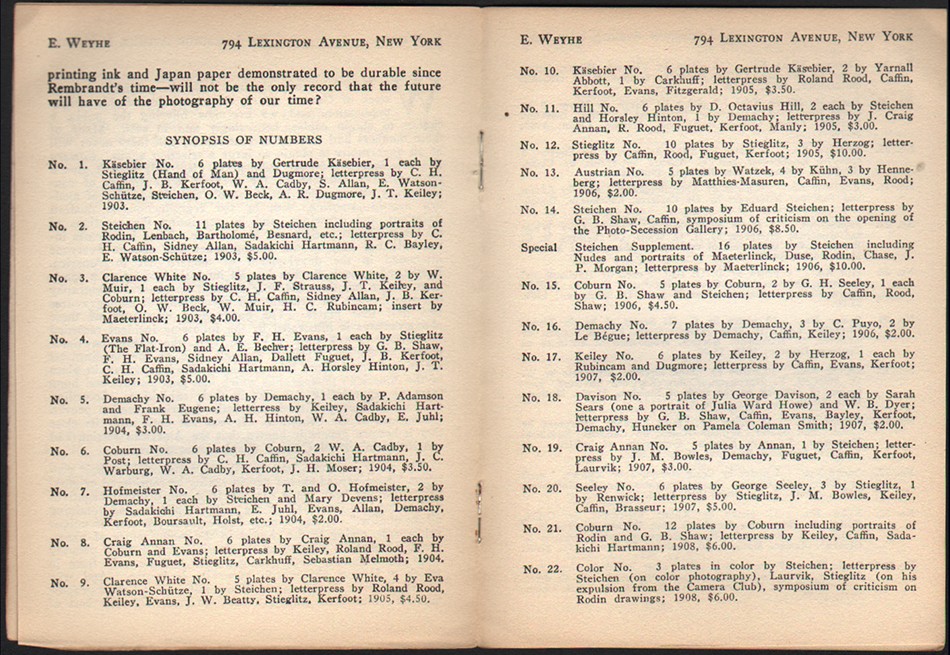 “Synopsis of Numbers: 1-22”: “Earliest known Camera Work Sales Catalogue” ( post publication): ca. 1924, uncoated paper: 13.8 x 20.1 cm (this gatefold). New York: E. Weyhe Gallery. The prospectus by the E. Weyhe Gallery, located at 794 Lexington Avenue in New York City, reprinted press notices for CW along with a synopsis of available issues and prices, including the final Paul Strand double issue 49-50 from 1917 for $17.50: An excerpt: "We Have recently obtained from the publisher a large stock of Camera Work, the remainder of this unique chance to obtain copies, both singly and in sets. Many of these numbers had already become scarce, and there never will be an opportunity to obtain so large a selection again." From: PhotoSeed Archive
“Synopsis of Numbers: 1-22”: “Earliest known Camera Work Sales Catalogue” ( post publication): ca. 1924, uncoated paper: 13.8 x 20.1 cm (this gatefold). New York: E. Weyhe Gallery. The prospectus by the E. Weyhe Gallery, located at 794 Lexington Avenue in New York City, reprinted press notices for CW along with a synopsis of available issues and prices, including the final Paul Strand double issue 49-50 from 1917 for $17.50: An excerpt: "We Have recently obtained from the publisher a large stock of Camera Work, the remainder of this unique chance to obtain copies, both singly and in sets. Many of these numbers had already become scarce, and there never will be an opportunity to obtain so large a selection again." From: PhotoSeed Archive
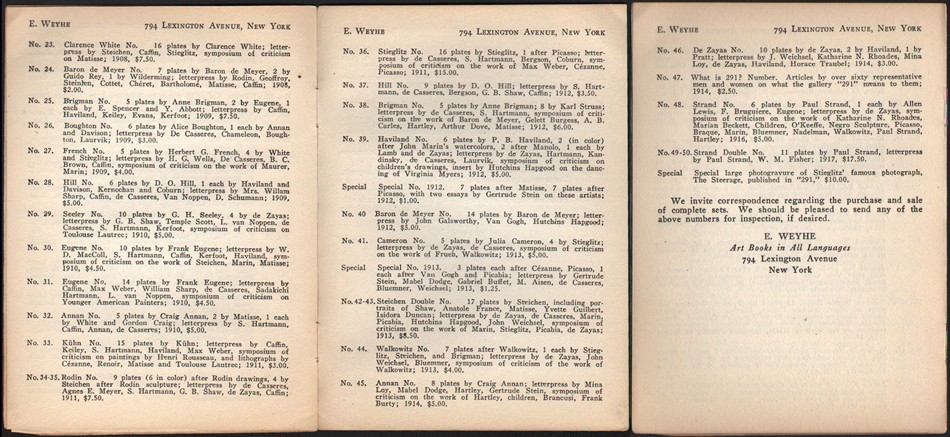 “Synopsis of Numbers: 23-48; 49-50; 2 special issues and special large plate gravure of The Steerage”: “Earliest known Camera Work Sales Catalogue” ( post publication): ca. 1924, uncoated paper: 13.8 x 20.1 cm (gatefold at left and back cover at right: 13.8 x 10.1 cm ). New York: E. Weyhe Gallery. The prospectus by the E. Weyhe Gallery, located at 794 Lexington Avenue in New York City, reprinted press notices for CW along with a synopsis of available issues and prices, including the final Paul Strand double issue 49-50 from 1917 for $17.50: An excerpt: "We Have recently obtained from the publisher a large stock of Camera Work, the remainder of this unique chance to obtain copies, both singly and in sets. Many of these numbers had already become scarce, and there never will be an opportunity to obtain so large a selection again." From: PhotoSeed Archive
“Synopsis of Numbers: 23-48; 49-50; 2 special issues and special large plate gravure of The Steerage”: “Earliest known Camera Work Sales Catalogue” ( post publication): ca. 1924, uncoated paper: 13.8 x 20.1 cm (gatefold at left and back cover at right: 13.8 x 10.1 cm ). New York: E. Weyhe Gallery. The prospectus by the E. Weyhe Gallery, located at 794 Lexington Avenue in New York City, reprinted press notices for CW along with a synopsis of available issues and prices, including the final Paul Strand double issue 49-50 from 1917 for $17.50: An excerpt: "We Have recently obtained from the publisher a large stock of Camera Work, the remainder of this unique chance to obtain copies, both singly and in sets. Many of these numbers had already become scarce, and there never will be an opportunity to obtain so large a selection again." From: PhotoSeed Archive
Pierre says: “The aim of this project is to put (Camera Work) in the hands of schools, teachers, students, museums, libraries, collectors, appraisers, auction houses, individuals, etc… a high quality reproduction of the originals at a reasonable price.”
Intrigued, I asked him what some of the challenges were for pulling the project off, and I couldn’t help but think of parallels Stieglitz himself surely encountered, yet updated for the digital age:
“There were many challenges. At first was where to start? From what? Luckily I found the Modernist Journal Project online which has a digital copy of Camera Work. It is incomplete but we contacted them and they were kind enough to supply us with their raw files. I used their files for the text pages but not for the plates.
The text pages needed a lot of work in Photoshop to clean, resize, straighten, etc… and then we had to photograph many of the plate pages Mark (Katzman) had no high res files in his archive. I also had to align the often found ghost image present on the facing page of the plates. Look at the video clips I have on the website and you’ll see what I mean. Especially visible in number 49-50.”
Continuing, and with the knowledge he has put up a significant amount of his own money to complete 25 full sets of Camera Work, Pierre spoke of finding someone to print the issues, something that happens less and less in this digital age:
…“I had to find a printer. I first looked online but the choices are limited and it ends up getting expensive really quick when you want to use a print on demand service like blurb.com. So I looked locally.
 International Camera Work Scholarship: With "The Red Man", a head study reproduced as a photogravure plate in Camera Work I by Gertrude Käsebier from 1903 projected on the screen at left, Professor Dr. Bettina Gockel, principal investigator for the project Camera Work: Inside/Out at the University of Zurich from 2015-18 delivers her paper: "More Than Genius: The Invention of Photographic Genius and the Importance of the Journal Camera Work" during the symposium Rethinking "Pictorialism": American Art and Photography, 1895 to 1925 at Princeton University in October, 2017. Photo by David Spencer for PhotoSeed Archive
International Camera Work Scholarship: With "The Red Man", a head study reproduced as a photogravure plate in Camera Work I by Gertrude Käsebier from 1903 projected on the screen at left, Professor Dr. Bettina Gockel, principal investigator for the project Camera Work: Inside/Out at the University of Zurich from 2015-18 delivers her paper: "More Than Genius: The Invention of Photographic Genius and the Importance of the Journal Camera Work" during the symposium Rethinking "Pictorialism": American Art and Photography, 1895 to 1925 at Princeton University in October, 2017. Photo by David Spencer for PhotoSeed Archive
I found a printer that was in St. Louis but after many, many weeks of proofs and tries, it did not work out. Back to square 1, I found another printer about 80 miles from St. Louis and this is the one I ended up using. All in all, it took me 6 months dealing with different printers to finally get what you saw in Rochester, the final product.”
As an added bonus, Pierre will also sell you a piece of history from the pages of Camera Work: approximately 180 individual advertising pages from the journal are listed on his site and can be ordered as 16 x 20” framable art prints for the bargain of $30 each.
Would the master Approve?
Not that my opinion matters, but here goes. It’s hard to guess if Alfred Stieglitz would have embraced the concept of digitization. My hunch says no, because I want to believe one of the most important legacies he left the world, Camera Work magazine, was something he would have been insistent be appreciated in its’ original form.
All well and good if you can get ahold of vintage copies, or have the tenacity and financial resources to acquire a full run of the 50 issues and supplements. But to those of us in the 21st century, the importance of the groundbreaking nature of the journal as well as the superb photogravure plates contained within give many of us ample reason to collect at least a few of the plates.
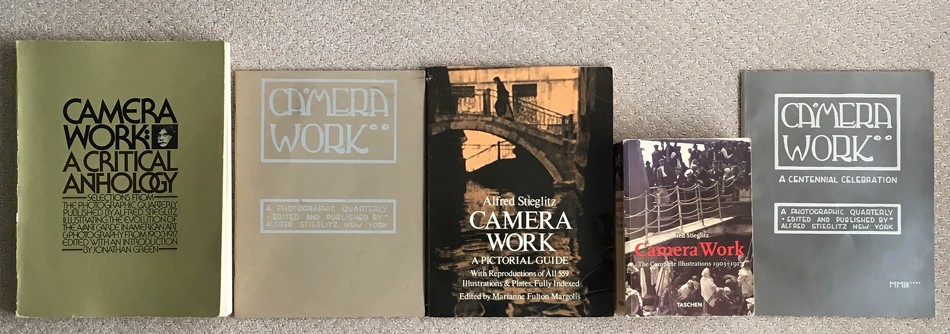 Published Literature: Camera Work: A chronological timeline of significant works are seen left to right: 1973: "Camera Work: A Critical Anthology" by Jonathan Green. This was the first significant evaluation of Camera Work, with an emphasis on the articles and text rather than the reproductions; 1973: "Camera Work: A Photographic Quarterly Edited and Published by Alfred Stieglitz, New York". Published by the Minneapolis Institute of Arts, this volume accompanied the exhibition, “I Am an American,” that traveled to more than a dozen towns in Minnesota on the Minneapolis Institute of Arts’ Artmobile; 1978: "Camera Work: A Pictorial Guide" by Marianne Fulton Margolis was the first instance all 559 plates from Camera Work were published in a single-volume reference; 1997: "Camera Work- The Complete Illustrations 1903-1917". Published by Benedikt Taschen with an essay by Pam Roberts additionally translated into German and French, it featured all plates taken from a complete set of the journal owned by the Royal Photographic Society, Bath; 2003: "Camera Work: A Centennial Celebration": In celebration of the 100th anniversary of the publication of Camera Work, a traveling exhibition was organized by Stephen Perloff, editor of The Photo Review and The Photograph Collector. From: PhotoSeed Archive
Published Literature: Camera Work: A chronological timeline of significant works are seen left to right: 1973: "Camera Work: A Critical Anthology" by Jonathan Green. This was the first significant evaluation of Camera Work, with an emphasis on the articles and text rather than the reproductions; 1973: "Camera Work: A Photographic Quarterly Edited and Published by Alfred Stieglitz, New York". Published by the Minneapolis Institute of Arts, this volume accompanied the exhibition, “I Am an American,” that traveled to more than a dozen towns in Minnesota on the Minneapolis Institute of Arts’ Artmobile; 1978: "Camera Work: A Pictorial Guide" by Marianne Fulton Margolis was the first instance all 559 plates from Camera Work were published in a single-volume reference; 1997: "Camera Work- The Complete Illustrations 1903-1917". Published by Benedikt Taschen with an essay by Pam Roberts additionally translated into German and French, it featured all plates taken from a complete set of the journal owned by the Royal Photographic Society, Bath; 2003: "Camera Work: A Centennial Celebration": In celebration of the 100th anniversary of the publication of Camera Work, a traveling exhibition was organized by Stephen Perloff, editor of The Photo Review and The Photograph Collector. From: PhotoSeed Archive
Speaking personally, a delicate japan tissue gravure of a collaborative effort by Stieglitz and Clarence White from Camera Work was one of my very first photographic purchases as a collector. I convinced myself I would frame that photograph and hang it on the wall, but it slowly drifted to the bottom of an acid-free case as I rapidly descended into the madness of collecting vintage photographs, never to look back.
For the sake of historical context, a timeline of the most notable publishing efforts promoting Camera Work scholarship, although certainly not exhaustive given the hundreds, perhaps thousands of citations for the journal not listed here, are necessary for the record, and reveal ample support and evidence for Pierre Vreyen’s efforts at getting it back in print. I’ve also included a few links at the end of this post for some exciting recent scholarship and digitization efforts.
Camera Work: Key Dates & published Literature
1903-1917:
Issued quarterly in New York by Alfred Stieglitz, (1864-1946) the journal featured a cover design by a young Edward Steichen who created the Craftsman inspired typeface logo anchored by an outlined box: “A Photographic Quarterly* Edited And Published By * Alfred Stieglitz New York”. Steichen’s efforts included the overall design aesthetic for the interior pages, which even extended to the advertising pages published in the back of each issue. Through primary sources, Camera Work is known to have had a larger subscriber base when it was first introduced in the first decade of the 20th Century but waned considerably with the outset of World War I in Europe. In a three page letter written by Stieglitz to the writer and critic Lewis Mumford dated October 15, 1935, he states the size of the edition for individual issues while giving other valuable information on the albatross Camera Work had become to him, along with the solution:
“Camera Work has gone off to you in 4 packages by parcel post…As for the missing Plates they were not torn out of the books but were never put into those copies. You see many of the gravures were tipped in my hand (by me) after the numbers had been printed & bound. And I only completed the number of copies as were subscribed for. The edition was always 1000 copies except 49–50—that was 350. When I destroyed about 10000 copies of Camera Work—they were smothering me—I destroyed virtually all the Plates that had not been used. That’s why I can’t complete your incomplete copies.” (2.)
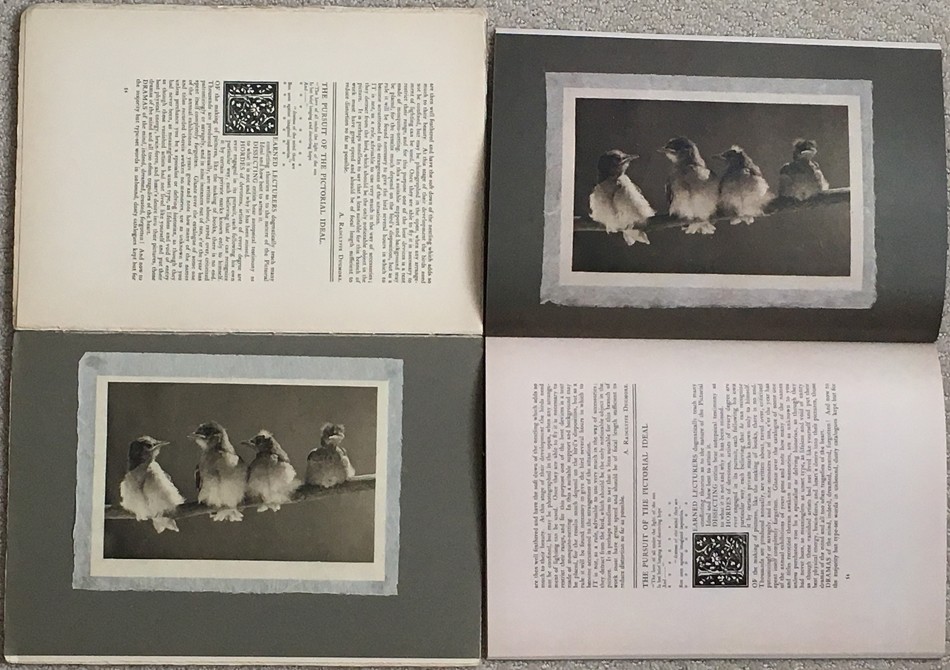 Vintage or Modern? Bottom Left: This mounted photogravure plate in Camera Work I from 1903 titled "A Study in Natural History" is by the American photographer A. Radclyffe Dugmore. This vintage example is opened to show it in relation to the opposing text page in an incomplete copy owned by the PhotoSeed Archive. Upper Right: The same page spread featuring the Dugmore plate in a new issue of Camera Work published as part of a set in May, 2018 and sold by Pierre Vreyen. Keen observers will notice the plates are flipped: this is because Alfred Stieglitz personally hand-tipped the gravure plates into each unique issue of Camera Work with the results sometimes being different in relation to placement on the plate pages. From: PhotoSeed Archive
Vintage or Modern? Bottom Left: This mounted photogravure plate in Camera Work I from 1903 titled "A Study in Natural History" is by the American photographer A. Radclyffe Dugmore. This vintage example is opened to show it in relation to the opposing text page in an incomplete copy owned by the PhotoSeed Archive. Upper Right: The same page spread featuring the Dugmore plate in a new issue of Camera Work published as part of a set in May, 2018 and sold by Pierre Vreyen. Keen observers will notice the plates are flipped: this is because Alfred Stieglitz personally hand-tipped the gravure plates into each unique issue of Camera Work with the results sometimes being different in relation to placement on the plate pages. From: PhotoSeed Archive
1924: (ca.) After 1917, the first known marketing efforts for the journal appear by the E. Weyhe Gallery of New York City. They publish a small prospectus which served as a sales catalogue after buying up remaining copies from Alfred Stieglitz. Scans of an original prospectus owned by PhotoSeed can be seen above. In 2012, one was also included with the sale of a full leather-bound run of the journal by Sotheby’s. The auction house provided the following background on the Weyhe firm as part of the listing:
“New York art dealer and publisher Erhard Weyhe (1882-1972), whose gallery and bookshop on Lexington Avenue promoted not only prints and art books, but also photography. Weyhe and Stieglitz were friends who frequented each other’s gallery and worked with some of the same artists. Laid in the present set’s first volume is a prospectus issued by the Weyhe firm, announcing that ‘we have recently obtained from the publisher a large stock of Camera Work, the remainder of this unique publication, and we are now offering the public a chance to obtain copies, both singly and in sets.” (3.)
1969: The first attempt at a true duplication for the journal was undertaken by Kraus Reprint, (Nendeln/Liechtenstein) and is outlined by scholar Meredith A. Friedman for her 2009 master of arts thesis “Camera Work And The Alfred Stieglitz Collection At The Metropolitan Museum Of Art”:
“Camera Work was published in fifty volumes from 1903 to 1917. In 1969 Kraus Reprint reproduced all fifty issues of Camera Work in a six-volume set. The reprint is not a facsimile, but rather a duplication of the content (text and illustrations) of Camera Work page-by-page. The page size of the reprint editions is slightly smaller than the original issues. In an introductory note, the publishers explain that the reproduction was printed “as a service to scholars. It records the entire content of the original number, but does not attempt to reproduce its visual quality, nor the calibre of its plates.” (32) The Kraus Reprint edition of Camera Work seems to be the first time anyone acknowledged the value of Camera Work from a scholarly perspective.” (Editors note: Hathi Trust Digital Library currently has around 40 of the Kraus issues which can be accessed here.)
(32.) Alfred Stieglitz, Camera Work (Nendeln, Liechtenstein: Kraus Reprint, 1969), edition notice.
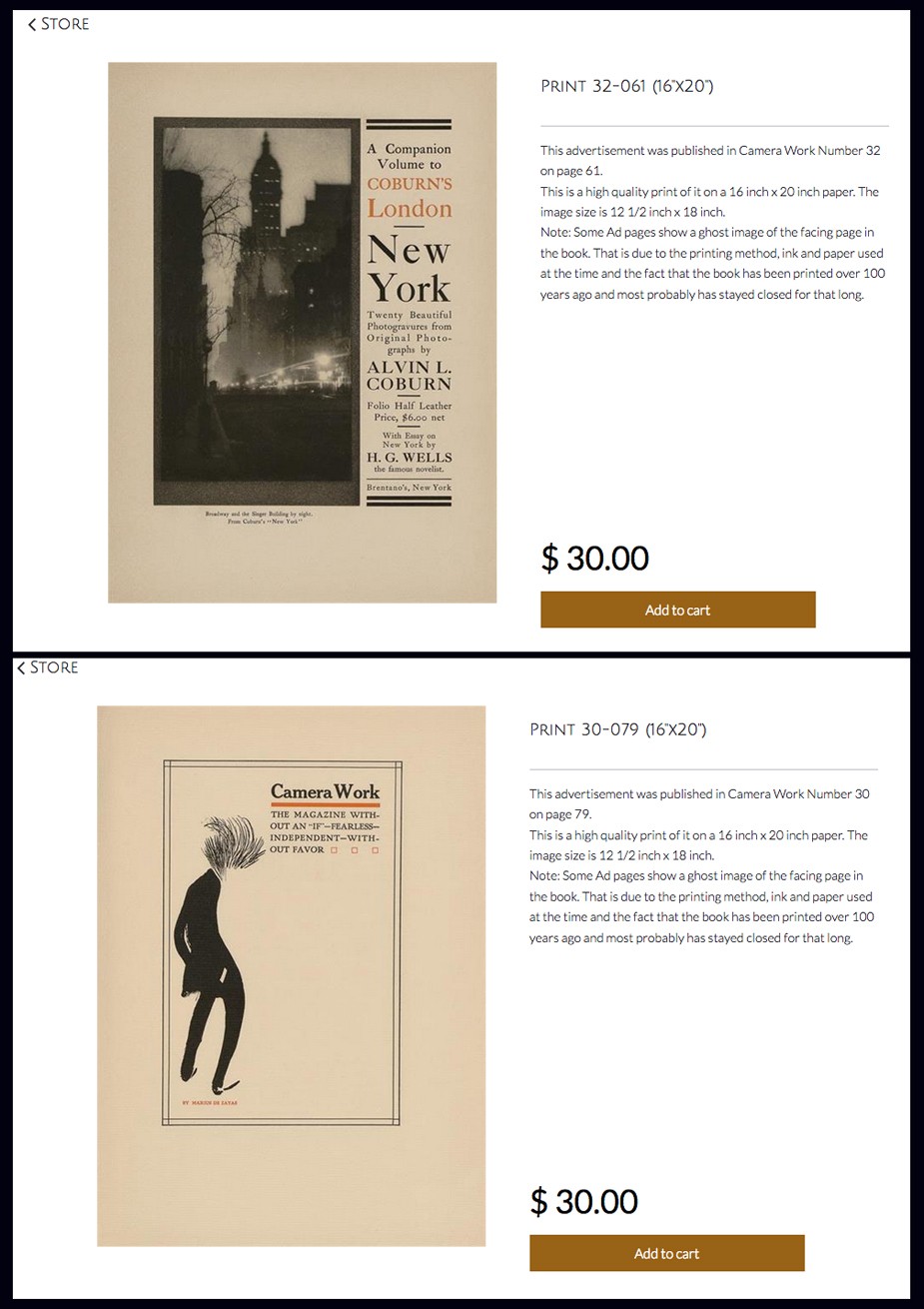 Ready for Framing: In addition to the full run of Camera Work along with a separate index issue, Pierre Vreyen's website cameraworkmagazine.com features approximately 180 individual advertising pages from the journal that can be ordered as 16 x 20" framable art prints for $30 each. At top, a vintage advertisement from Camera Work XXXII featured an actual photogravure from Alvin Langdon Coburn's volume New York. At bottom, an ad shows a full-length caricature of Alfred Stieglitz by the artist Marius De Zayas featured in Camera Work XXX. Courtesy: Pierre Vreyen
Ready for Framing: In addition to the full run of Camera Work along with a separate index issue, Pierre Vreyen's website cameraworkmagazine.com features approximately 180 individual advertising pages from the journal that can be ordered as 16 x 20" framable art prints for $30 each. At top, a vintage advertisement from Camera Work XXXII featured an actual photogravure from Alvin Langdon Coburn's volume New York. At bottom, an ad shows a full-length caricature of Alfred Stieglitz by the artist Marius De Zayas featured in Camera Work XXX. Courtesy: Pierre Vreyen
1973: Friedman continues with the journal’s literature survey:
“Jonathan Green’s Camera Work: A Critical Anthology (1973) is the first significant evaluation of Camera Work, particularly focusing on the articles and text rather than the reproductions. It describes the evolution of the photographic medium through the writing in Camera Work from issue to issue over the fifteen years of its publication. The volume is thoroughly organized with six indexes: biographical information each of the artists, photographers, and writers who contributed to Camera Work and that are featured in his text; a chronological bibliography of works relating to Camera Work and the Photo-Secession; an index of names and subjects appearing in Camera Work; a chronological list of articles published in Camera Work; an index of artists and the issues in which their works appear; and a chronological index of the plates, listing the process by which they were reproduced in Camera Work.”
1973: Scholar Christian Peterson notes the following title which featured a facsimile of the Camera Work cover logo and publishing attribution for Stieglitz in his online sales catalogue for the journal:
Camera Work: A Photographic Quarterly Edited and Published by Alfred Stieglitz, New York, Minneapolis Institute of Arts, 1973. Softcover, 11 x 8 ½ inches, 40 pages, 3 halftone illustrations. This uncommon publication accompanied the exhibition, “I Am an American,” that traveled to over a dozen Minnesota towns in 1973 on the Minneapolis Institute of Arts’ Artmobile. The show included photogravures from Camera Work, plus paintings, drawing, and watercolors by members of the Stieglitz circle. This item includes a facsimile cover of the magazine, brief text by curator Carroll T. Hartwell, and reprints of articles from Camera Work. Most importantly, it features images by James Craig Annan, Alvin Langdon Coburn, and Stieglitz, printed on translucent paper and tipped-in, in a modest effort to replicate the delicate nature of the original gravures. Fine condition. $25. (editor: note: the “gravures” are actually halftones)
1978: Friedman continues with her thesis survey:
“In 1978 Marianne Fulton Margolis published Camera Work: A Pictorial Guide, building upon the thorough indexing in Green’s publication, but instead focusing solely on the images in Camera Work. This was the first time all 559 images from Camera Work were published in a single-volume reference. The images leave much to be desired; all are printed the same size, four to a page, in black and white halftone. As a reference, though, the publication is invaluable. The main part of the book reproduces each image in Camera Work in their exact sequence as published. Like Green, Margolis lists the medium by which the image was reproduced in Camera Work, but she also provides the original medium of the work when known, and also indicates when the reproduction is known to have been created from the artist’s original negative. Further, Margolis provides the reproduction method for every illustration in each issue of Camera Work, whereas Green discussed the plates, and a number of graphics within the text (such as Steichen’s Photo-Secession poster in Camera Work Number 13) which Margolis has not included in her index. Much of this information comes directly from the text of Camera Work. Three additional indexes at the end of the book provide an alphabetical list of artists, titles and portrait sitters, each with corresponding number of the periodical.”
1985: Friedman survey continues:
“This same concern was raised again in 1985 in the exhibition Camera Work: Process and Image organized by the Minneapolis Institute of Arts and accompanied by a catalogue with an essay by Christian A. Peterson that chronicles the use of reproductions throughout the publication of Camera Work, and the response these images provoked in the photographers whose works were reproduced.”
1997: Camera Work- The Complete Illustrations 1903-1917 is published by Benedikt Taschen with an essay in English by Pam Roberts that was additionally translated into German and French for the volume. Along with a full index of all artists represented in the journal and selected texts printed in the rear of the volume, all of the plates are reproduced which were taken from a complete set of Camera Work owned by the Royal Photographic Society, Bath.
Roberts notes in her essay: “Camera Work fulfilled many functions. On one level, it began as the last outpost of the confluence of Symbolist art, photography and literature, and ended as a messenger of Modernism. On another level, it was a non-concurrent exhibition catalogue for 291 and the publicity machine for the Photo-Secession.”
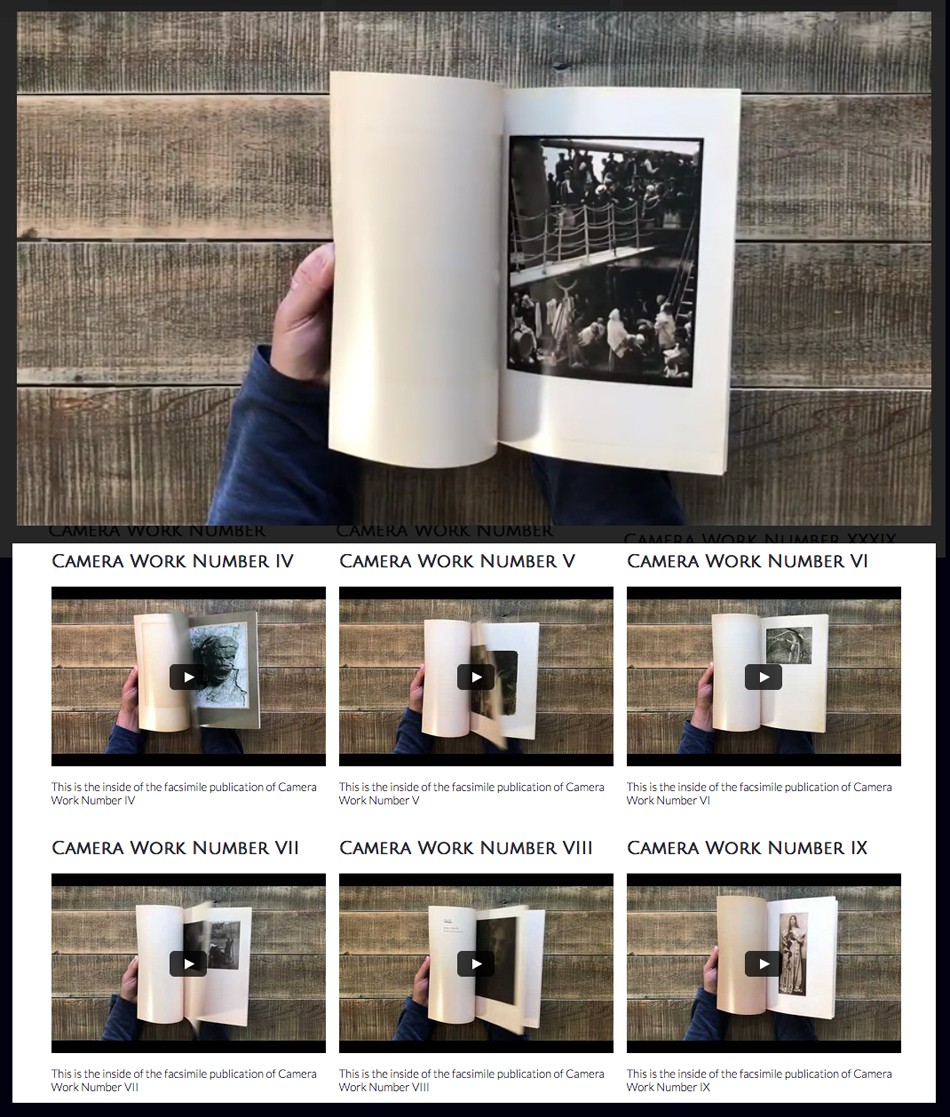 Pierre wears a Blue Shirt: Each issue of the full run of the newly re-issued Camera Work magazine plus a new separate index issue published in May, 2018 is featured in short video clips from back to front by Pierre Vreyen at his website cameraworkmagazine.com. At top, "The Steerage" by Alfred Stieglitz in Camera Work XXXVI. Courtesy Pierre Vreyen
Pierre wears a Blue Shirt: Each issue of the full run of the newly re-issued Camera Work magazine plus a new separate index issue published in May, 2018 is featured in short video clips from back to front by Pierre Vreyen at his website cameraworkmagazine.com. At top, "The Steerage" by Alfred Stieglitz in Camera Work XXXVI. Courtesy Pierre Vreyen
Friedman’s thesis also comments on the 15th anniversary edition of this work: “An alternate version of this book, Camera Work: The Complete Photographs, published in 2008 for the l5th anniversary of Taschen, features reproductions of every photograph in Camera Work, but not every illustration as its predecessor does.”
2003: “Camera Work: A Centennial Celebration” is published. Friedman comments:
”In celebration of the 100th anniversary of the publication of Camera Work, a traveling exhibition was organized by Stephen Perloff, editor of The Photo Review and The Photograph Collector. A double issue of The Photo Review was published as a catalogue and featured essays by Perloff along with Peter C. Bunnell, Lucy Bowdich, Barbara L. Michaels, and Luis Nadeau.” (33.)
33. Perloff, Stephen, ed. “Camera Work: A Centennial Celebration.” Exhibition catalogue. The Photo Review 26, no. 1-2, 2003.
Camera Work Resources & Scholarship on the Web
- Wikipedia: always a good resource if you are just getting your feet wet in first learning about Camera Work. Link
- Modernist Journal Project: originally founded at Brown University in 1995 to create an online periodicals database, the entire run of Camera Work, using vintage copies from Princeton University, has been digitized in the last five years and posted online. Brown teamed with The University of Tulsa for the effort, which lacks only six photographic plates-Gertrude Käsebier’s “Portrait (Miss N)” and “Red Man” (CW 1: 11, 13), A. Radclyffe Dugmore’s “Study in Natural History” (CW 1: 55), Eduard Steichen’s “Solitude” and “Poster Lady” (CW 14s: 33, 35), and Steichen’s “The Photographer’s Best Model: G. Bernard Shaw” (CW 42-43: 39). Link
- Photogravure.com: Site owner and collector Mark Katzman has made all of the gorgeous photogravure plates (as well as most of the halftone plates) throughout the entire run of Camera Work accessible from his personal collection in the newly relaunched version of his site. Link
- Heidelberg University Library in conjunction with The University of Zurich launches their digitization efforts to the web in March, 2018: “all fifty regular and three special issues of Camera Work are digitized to the highest standards”. Link
- Camera Work: Inside/Out: Under the guidance of Professor Dr. Bettina Gockel, the principal investigator for the project, the University of Zurich from 2015-18 launches this research project in conjunction with the Institute of Art History at the university. Link
- Video: Camera Work – Institute of Art History University of Zurich: With a running length of about 5.5 minutes, this video produced as part of “Camera Work: Inside/Out” is a wonderful tribute to the enduring legacy and importance of the journal, and a fitting end to our post. Link
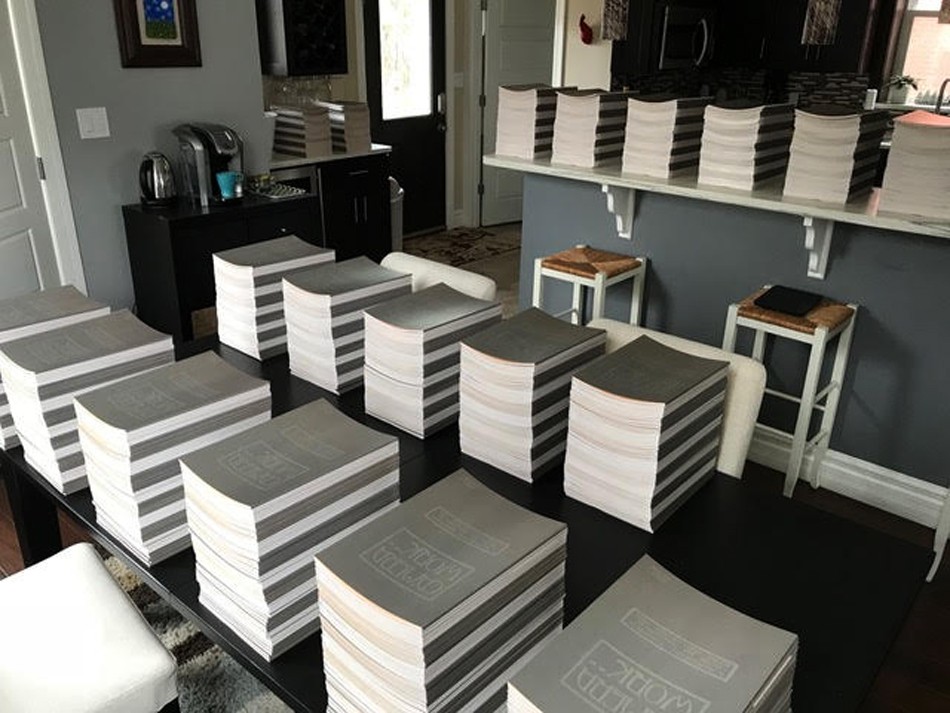 Editor, Publisher & Shipper: As seen here, St. Louis, MO resident Pierre Vreyen told PhotoSeed: "I picked up 25 sets of Camera Work from the printer yesterday. 1275 books!!! That’s a lot of books spread around my house. I am currently stacking them all in sets…" Well done, Pierre and good luck on your new endeavor I say! Courtesy Pierre Vreyen
Editor, Publisher & Shipper: As seen here, St. Louis, MO resident Pierre Vreyen told PhotoSeed: "I picked up 25 sets of Camera Work from the printer yesterday. 1275 books!!! That’s a lot of books spread around my house. I am currently stacking them all in sets…" Well done, Pierre and good luck on your new endeavor I say! Courtesy Pierre Vreyen
Notes:
1. Letter excerpt: in auction listing by RR Auction, Amherst, NH April, 2018-lot passed- #0537. Additionally, the first two sentences of this letter cited in footnote #15 by Lori Cole for her essay “Camera Work: Forming Avant-Garde New York” published in the 2013 volume The Aesthetics of Matter: Modernism, the Avant-Garde and Material Exchange with cited source being the Alfred Stieglitz/Georgia O’Keeffe Archive at Yale University’s Beinecke Rare Book Library. (p. 186) (Note: the 2008 volume edited by Robert Wojtowicz titled Mumford on Modern Art in the 1930s states carbon copies of letters, believed to include this one sent by Stieglitz to Mumford, are contained within the Alfred Stieglitz correspondence files at the Beinecke.) The actual bonfire set by Stieglitz is corroborated somewhat in a description by Sue Davidson Lowe, the grandniece of Stieglitz, who writes in her volume: Stieglitz-A Memoir/Biography (1983) that in 1929, when Stieglitz was at Lake George and experiencing an emotional helplessness because he had not heard from Georgia O’Keeffe for several weeks, took to the cathartic act of burning: “an accumulation of papers-books and pamphlets, magazines (including many issues of Camera Work), negatives, and prints.” p. 294
2. ALS signed “Stieglitz,” three pages on two sheets, October 15, 1935, in part. (Stieglitz to Lewis Mumford) From auction listing: RR Auction, Amherst, NH April, 2018-lot passed- #0537.
3. ‘CAMERA WORK: A PHOTOGRAPHIC QUARTERLY’ Alfred Stieglitz, Editor: Sotheby’s: 03 OCTOBER 2012: Lot 55
California Pipe Dreamer
Posted January 2016 in Alternate Processes, History of Photography, Journals, New Additions, Publishing, Texts
Sigismund Blumann, (1872-1956) an American who became an important editor and photographer after moving to San Francisco, California from New York City in the early 1880’s is our subject for this post, along with his involvement with and history of Camera Craft magazine. Never heard of him? A few relevant but by no means comprehensive list of details about this gentleman whose friends addressed him as “Sig” for short:
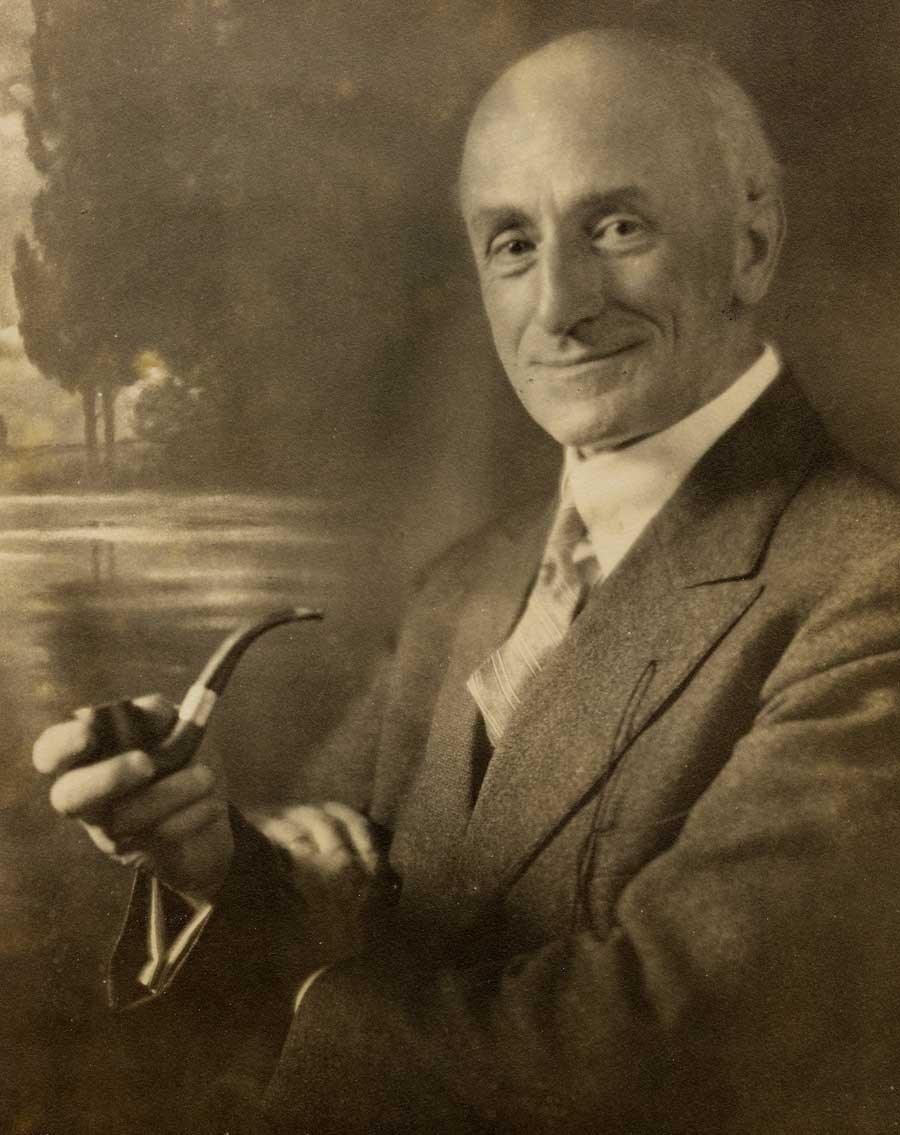 Detail: "Self-Portrait of Sigismund Blumann" (1872-1956) : American: gelatin silver print ca. 1930: Blumann was editor-in-chief of San Francisco-based Camera Craft magazine from 1924-1933: Photograph courtesy Thomas High
Detail: "Self-Portrait of Sigismund Blumann" (1872-1956) : American: gelatin silver print ca. 1930: Blumann was editor-in-chief of San Francisco-based Camera Craft magazine from 1924-1933: Photograph courtesy Thomas High
⌘ West Coast champion for photography in his role as Editor-in-Chief of Camera Craft magazine from 1924-1933. Prolific writer for said journal whose love of language sometimes lead to his mangling of it, but only with the best of intentions.
⌘ Significant pictorialist photographer from the same period and earlier whose darkroom work was equally inventive and important.
⌘ Poet.
⌘ So gregarious in affect, photographic historian Christian A. Peterson duly notes, (1.) that as editor, he personally answered all correspondence sent to him by his 8000 monthly Camera Craft readers in addition to his regular duties of penning multiple articles for each issue.
⌘ Possession of a sly sense of humor: look no further than a ca. 1930 self-portrait in which his suit lapel sprouts a long cable release rather than a floral boutonnière.
⌘ Conservative writer in print who often took a while to accept new ideas: as one example, Peterson notes his use of the made-up word “Sewereelism” included in a 1938 editorial written by him on his feelings towards the failings of the art movements Surrealism and Dada for the magazine Photo Art Monthly, a publication he owned himself. (2.)
⌘ Pipe smoker extraordinaire. Featured not only in the above referenced self-portrait but immortalized by artist W.R. Potter in print every month as artistic caricature shown smoking and reading a book used for his Under the Editor’s Lamp column in Camera Craft beginning in April 1926.
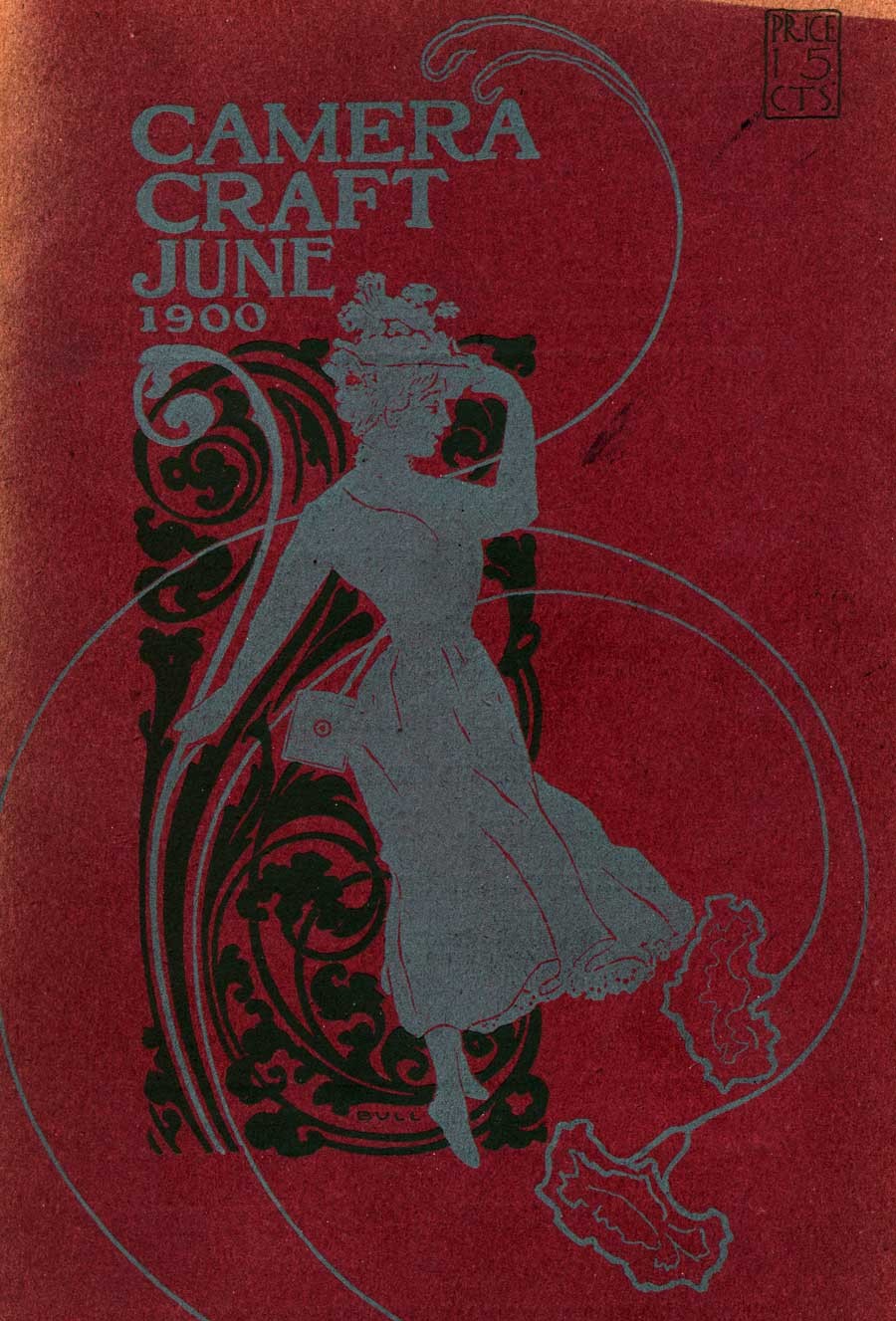 Detail: Cover Design: Camera Craft magazine: June, 1900: William Howell Bull: 1851-1940: American-California: 26.0 x 17.5 cm: two-color wood engraving : Sunset Press & Photo Engraving Company - San Francisco: cover price at upper right corner 15¢. Although this was the second issue of the magazine to appear, the first issue for May used the same cover design showing this stylish woman done in the Art-Nouveau style with small box camera slung on her side. From: PhotoSeed Archive
Detail: Cover Design: Camera Craft magazine: June, 1900: William Howell Bull: 1851-1940: American-California: 26.0 x 17.5 cm: two-color wood engraving : Sunset Press & Photo Engraving Company - San Francisco: cover price at upper right corner 15¢. Although this was the second issue of the magazine to appear, the first issue for May used the same cover design showing this stylish woman done in the Art-Nouveau style with small box camera slung on her side. From: PhotoSeed Archive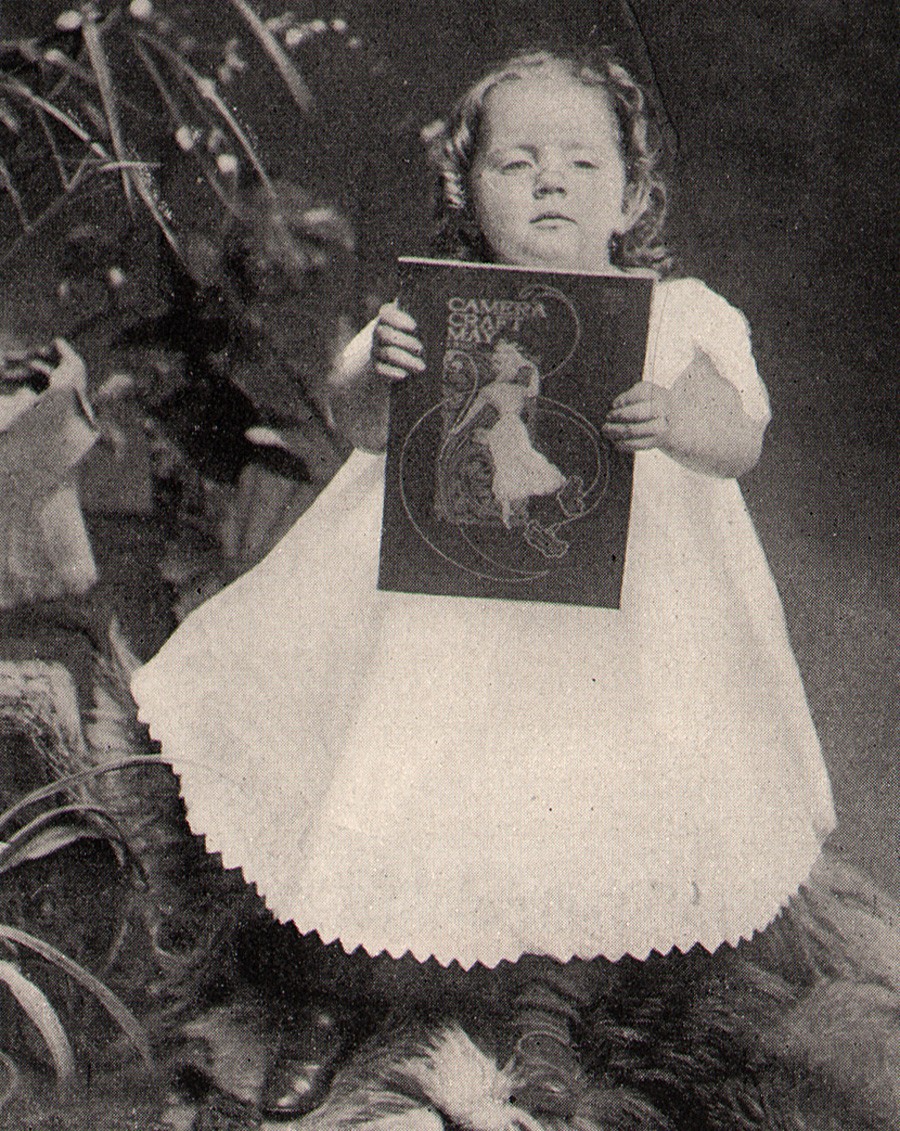 Detail: "Everyone Reads It": Mrs. C.S. Smith, American: Marysville (CA): halftone from June, 1900 Camera Craft magazine p. 57: 10.6 x 8.1 cm: A young girl holds up the very first issue of Camera Craft dated May, 1900. The design by California artist W.H. Bull was also used as the cover for June, 1900. From: PhotoSeed Archive
Detail: "Everyone Reads It": Mrs. C.S. Smith, American: Marysville (CA): halftone from June, 1900 Camera Craft magazine p. 57: 10.6 x 8.1 cm: A young girl holds up the very first issue of Camera Craft dated May, 1900. The design by California artist W.H. Bull was also used as the cover for June, 1900. From: PhotoSeed Archive
Sigismund Blumann: Short Biography
For the past three years, I’ve had the distinct pleasure of corresponding with Thomas High, Sigismund Blumann’s grandson, and been equally fortunate in acquiring a small archive of Sig’s vintage work for PhotoSeed previously kept in the family. Unlike Sig’s friends, Tom tells me, as a boy of perhaps five or six, he would of course address him as Grampa Blumann. Tom goes on to say:
”I only wish I had known him better – he died when I was a child, and my only real memories of him were playing rummy and whist with him.”
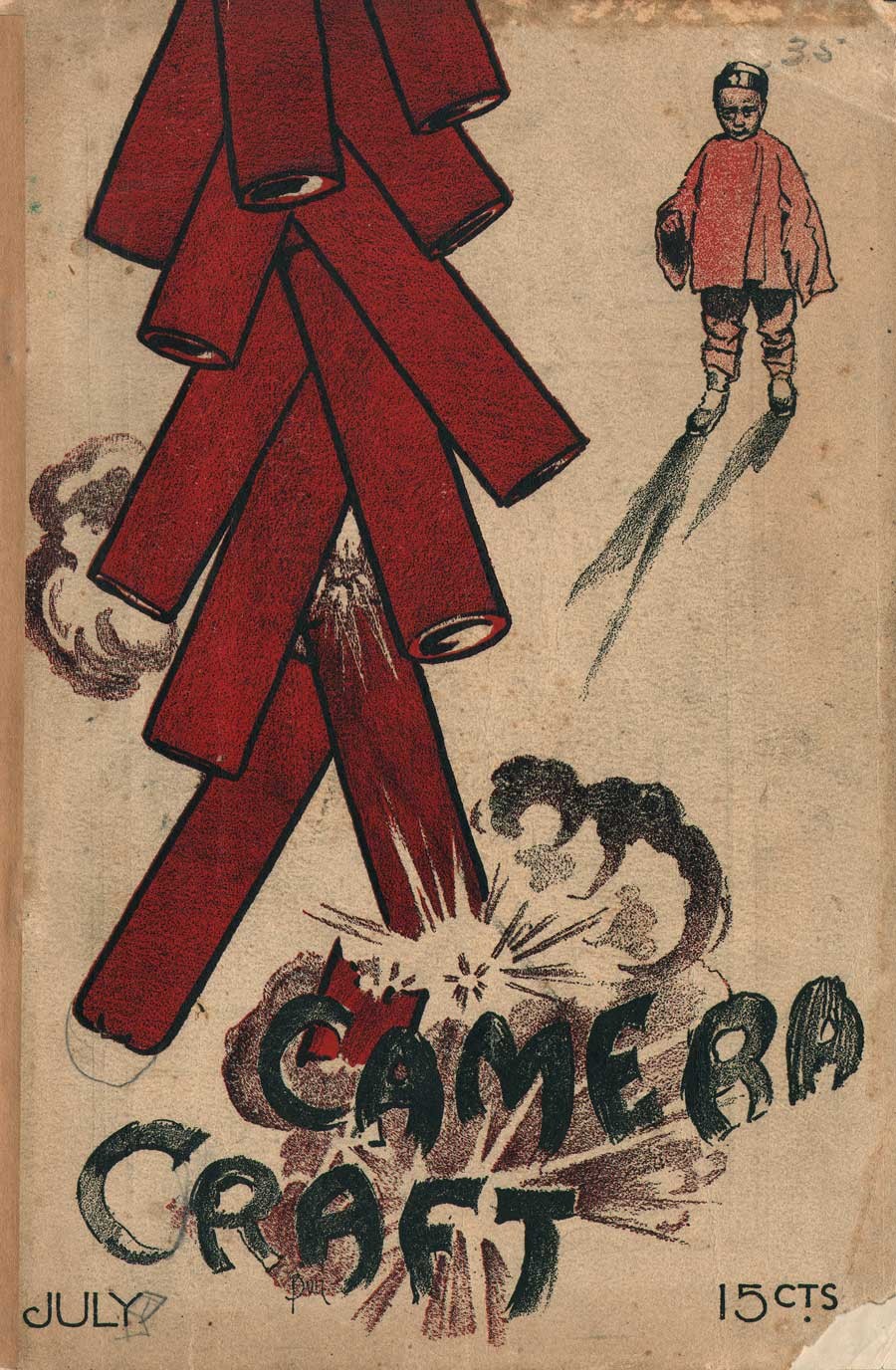 Cover Design: Chinese Firecrackers: Camera Craft magazine: July, 1900: William Howell Bull: 1851-1940: American-California: 26.0 x 17.5 cm: two-color wood engraving : Sunset Press & Photo Engraving Company - San Francisco: cover price at lower right corner 15¢. From: PhotoSeed Archive
Cover Design: Chinese Firecrackers: Camera Craft magazine: July, 1900: William Howell Bull: 1851-1940: American-California: 26.0 x 17.5 cm: two-color wood engraving : Sunset Press & Photo Engraving Company - San Francisco: cover price at lower right corner 15¢. From: PhotoSeed ArchiveTom has also agreed to let me reprint for purposes of introduction the following short biography of his grandfather written in October, 2009, for which I’m very grateful.
Sigismund Blumann (1872-1956) by Thomas High
Sigismund Blumann was born on September 13, 1872, in New York City, the son of Alexander Blumann and Rosalie (Price) Blumann. He came to San Francisco with his parents in late 1881 or 1882, and subsequently became a professional pianist and music teacher.
Sigismund Blumann married first on August 30, 1894, to Adele Morgenstern. They divorced in May of 1895. He married second on June 4, 1901, to Hilda Axelina Johansson and they subsequently had four daughters, Ethel, Amy, Lorna, and Vera.
In the 1890s, Sigismund Blumann became interested in photography and had begun taking photos seriously by 1900 while living in San Francisco. At the time of the San Francisco earthquake on April 9, 1906, he and his wife were still living with his parents on Army Street. He volunteered to help the recovery and, with his official permits, got through the lines and took a number of photographs.
Mr. Blumann was also a prolific writer and he authored numerous articles, commentaries, and poems.
After the 1906 earthquake, the Blumanns moved to Davis Street in Fruitvale (later part of Oakland). From that time, all of his photographic work was done in his darkroom at the Davis Street home.
Photography increased in importance in his life, and at the 1915 Panama-Pacific International Exposition he combined all of his talents: he played in an orchestra, photographed the Fair, and worked as a correspondent for the New York Tribune and other newspapers.
In the early 1920s, Sigismund retired from an active career in music and entered the profession of efficiency engineering, with offices in the Monadnock Building in San Francisco. His principal client was the Forster Music Publishing Company.
He continued his interest in photography and in 1924 he became editor of Camera Craft magazine. In addition to editing the publication and writing numerous articles for it, he also wrote the Photographic Workroom Handbook, published by Camera Craft in 1927.
Mr. Blumann’s last issue as editor of Camera Craft was in August of 1933. Several months later, he launched his own magazine, Photo Art Monthly, which he edited and published until 1940. During this period, he also produced several more manuals for amateur photographers, including the Photographic Handbook, Photographic Greetings - How to Make Them, Enlarging Manual, and Toning Processes.
In 1940, he sold the Photo Art Monthly to his assistant, Franke Unger (who married photographer Adolf Fassbender about the same time). She soon closed the magazine.
The Blumanns continued to live at their Davis Street home for the rest of their lives, joined by their unmarried daughters, Ethel and Lorna Blumann, both librarians. He produced little photographic work in the 1940s and 1950s, contenting himself to dabble in photography and discuss it with his new son-in-law, William A. High, who married his daughter, Vera, in February of 1943. Bill High was a commercial photographer before World War II, a combat photographer for the US Army during the war, and the founder of the photography department at Oakland’s Laney Trade School (later Peralta Junior College) thereafter.
Sigismund Blumann died in Oakland on July 9, 1956, and Hilda Blumann died on February 1, 1958, also in Oakland.
Sigismund Blumann’s photos are in the Oakland Museum, Minneapolis Institute of Art, High Museum in Atlanta, and elsewhere.
For further information, see “Sigismund Blumann, California Editor and Photographer,” by Christian A. Peterson, in History of Photography, vol. 26, no. 1. (Spring 2002).
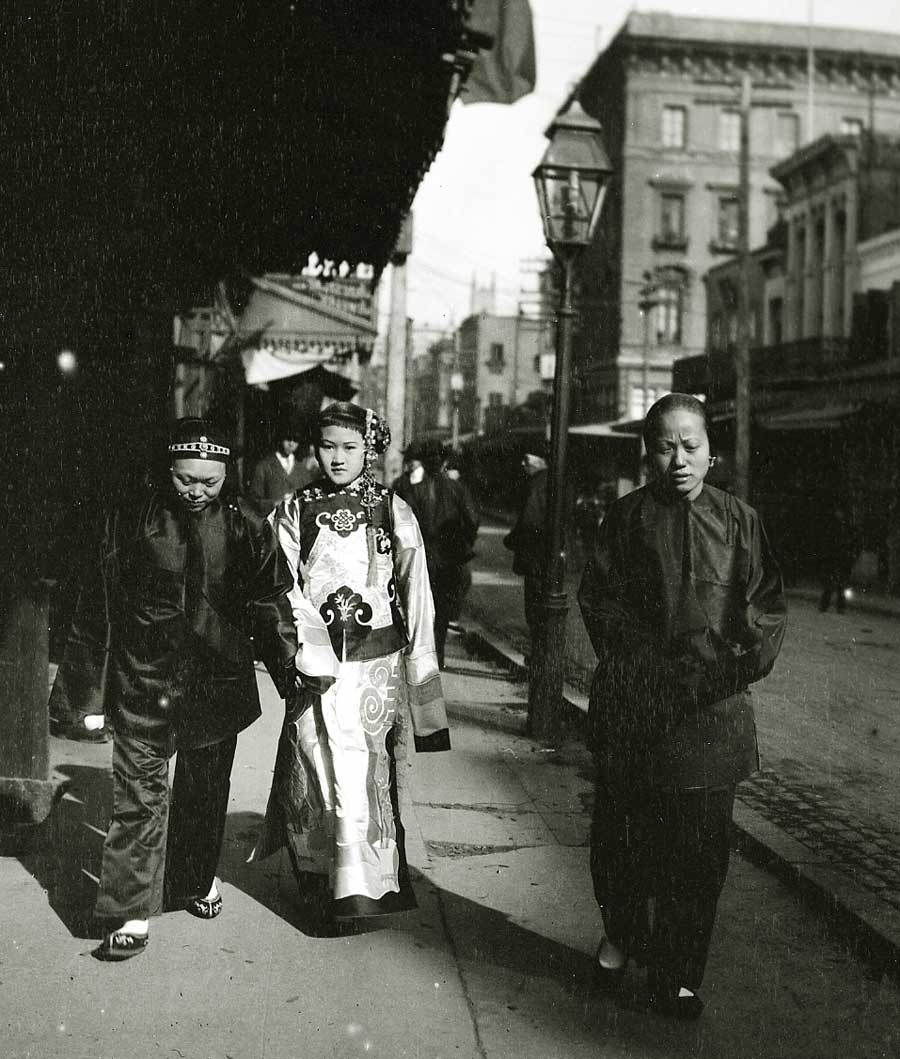 Detail: "Highborn Lady With Duenna": Sigismund Blumann: American: ca. 1901: This view is from a collection of at least 43 documentary photographs, with several corresponding paper negative envelopes dated 1901 by Blumann donated by his family to the California Historical Society. They can be viewed there as part of the collection “The Chinese in California: 1850-1925.” Photograph courtesy Thomas High
Detail: "Highborn Lady With Duenna": Sigismund Blumann: American: ca. 1901: This view is from a collection of at least 43 documentary photographs, with several corresponding paper negative envelopes dated 1901 by Blumann donated by his family to the California Historical Society. They can be viewed there as part of the collection “The Chinese in California: 1850-1925.” Photograph courtesy Thomas High
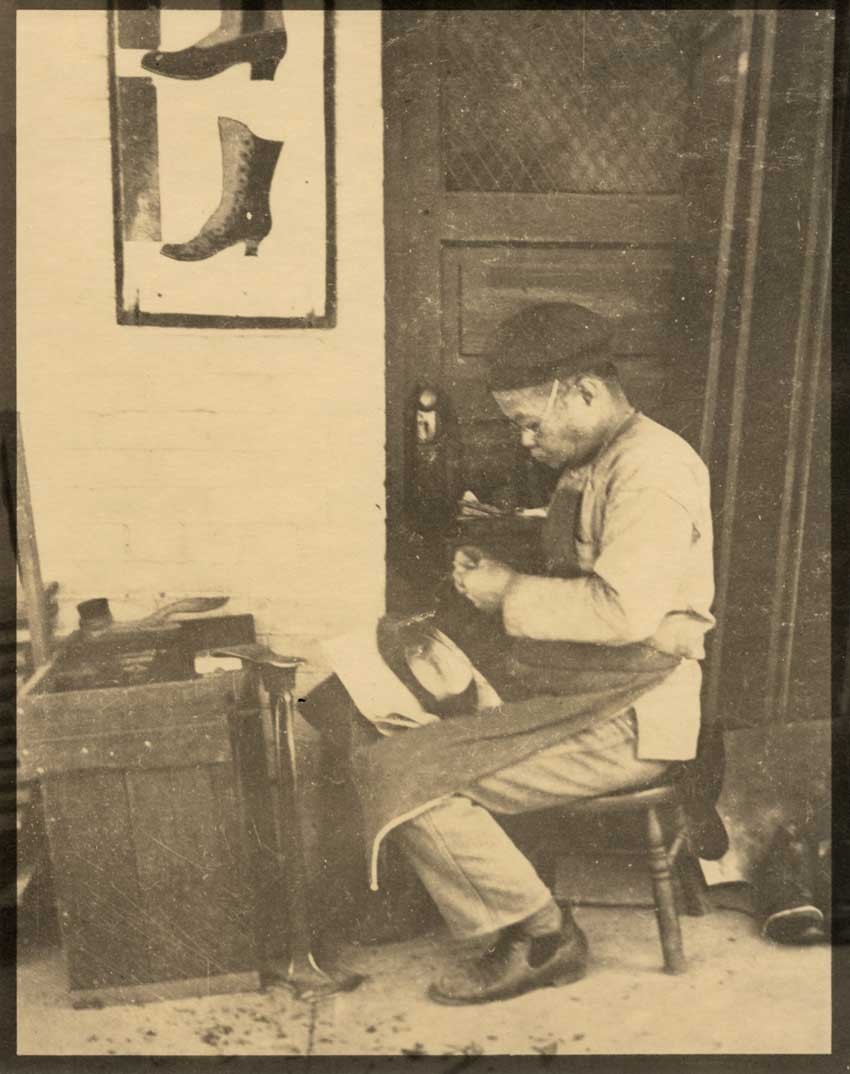 "Chinese Cobbler": San Francisco Chinatown: Sigismund Blumann: American: ca. 1901, printed early 1920s: gelatin silver print- app. 8 7/8 x 7.0": variant: "Shoe Mender": from California Historical Society collection: FN-34374: Photograph courtesy Thomas High
"Chinese Cobbler": San Francisco Chinatown: Sigismund Blumann: American: ca. 1901, printed early 1920s: gelatin silver print- app. 8 7/8 x 7.0": variant: "Shoe Mender": from California Historical Society collection: FN-34374: Photograph courtesy Thomas High
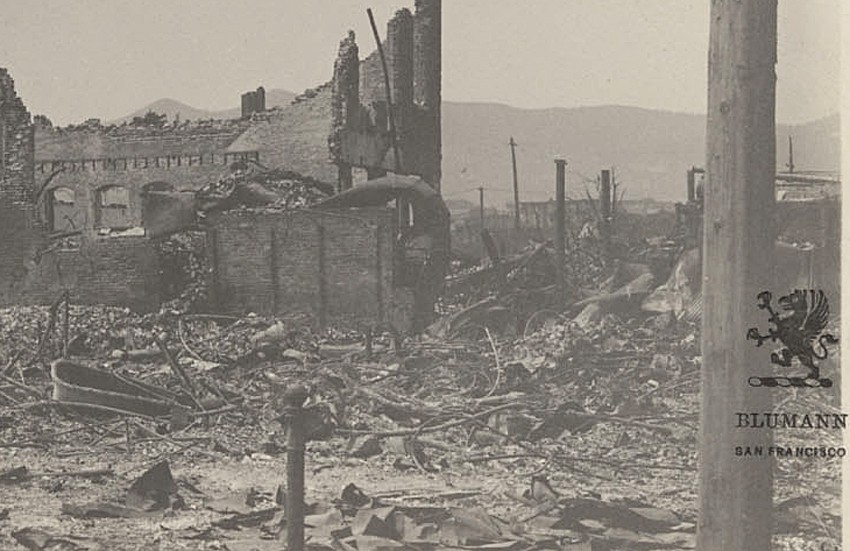 Detail: "Ruins" (San Francisco Earthquake): Sigismund Blumann: American: ca. 1906: gelatin silver print: 13.0 x 18.0 cm: overprinted with Blumann's winged griffin monogram at lower right: Photograph courtesy: California Historical Society: The 1906 San Francisco Earthquake and Fire Digital Collection: Local Call # FN-33293
Detail: "Ruins" (San Francisco Earthquake): Sigismund Blumann: American: ca. 1906: gelatin silver print: 13.0 x 18.0 cm: overprinted with Blumann's winged griffin monogram at lower right: Photograph courtesy: California Historical Society: The 1906 San Francisco Earthquake and Fire Digital Collection: Local Call # FN-33293
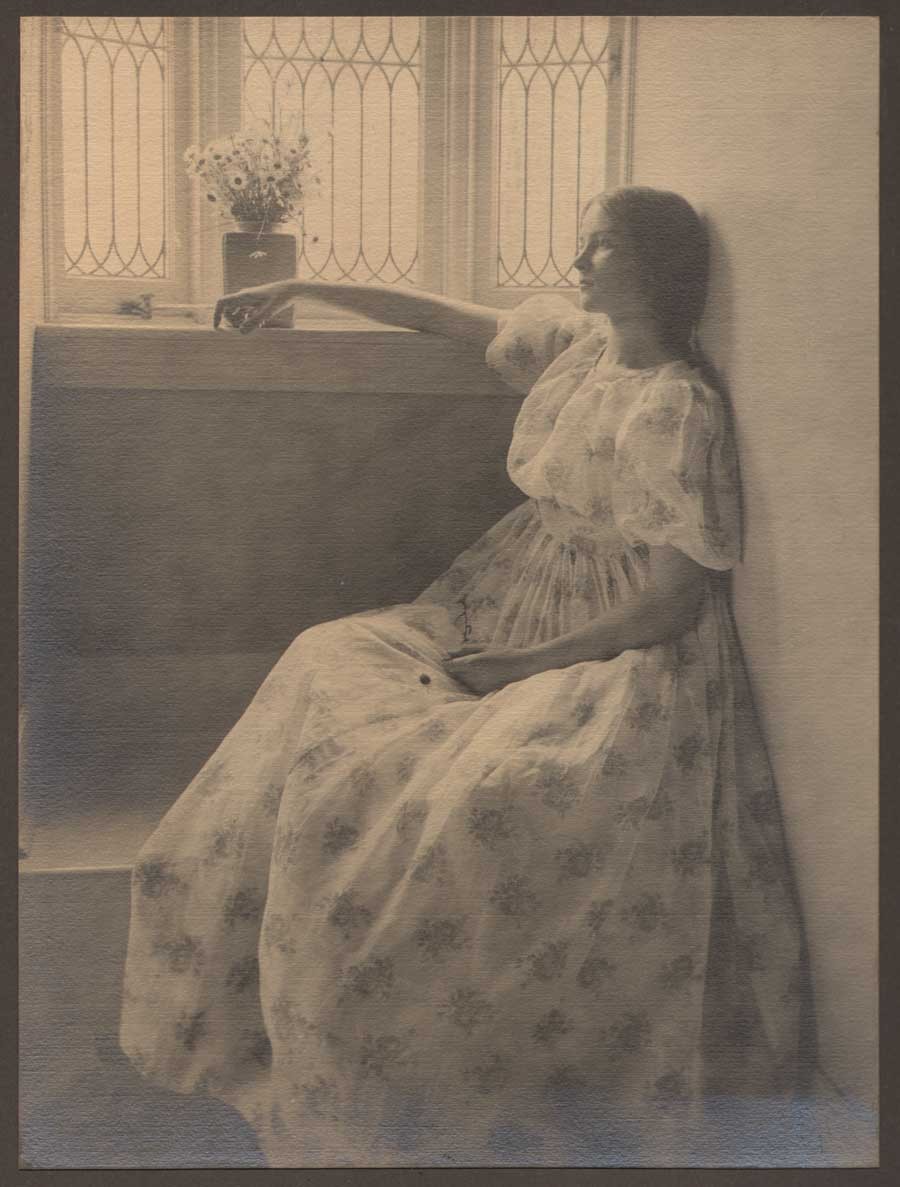 "Day Dreams" : Charles Rollins Tucker 1868-1956: American: gelatin silver print: June, 1906 printed 1915: 27.3 x 20.4 | 43.2 x 35.5 cm : First titled "Study in Home Portraiture" and published full page in the Oct. 1906 Photographic Times, this interior study later appeared as a full-page halftone in the July, 1907 Camera Craft magazine, and is a representative example of the pictorialist work that regularly appeared in its pages. Coincidentally, imagery like this was also gaining popularity during this time among amateur and professional photographers, and Sigismund Blumann was no exception, teaming up with fellow photographer Jacques Tillmany in 1907 on a part-time basis offering in-home photographic portraiture. From: PhotoSeed Archive
"Day Dreams" : Charles Rollins Tucker 1868-1956: American: gelatin silver print: June, 1906 printed 1915: 27.3 x 20.4 | 43.2 x 35.5 cm : First titled "Study in Home Portraiture" and published full page in the Oct. 1906 Photographic Times, this interior study later appeared as a full-page halftone in the July, 1907 Camera Craft magazine, and is a representative example of the pictorialist work that regularly appeared in its pages. Coincidentally, imagery like this was also gaining popularity during this time among amateur and professional photographers, and Sigismund Blumann was no exception, teaming up with fellow photographer Jacques Tillmany in 1907 on a part-time basis offering in-home photographic portraiture. From: PhotoSeed Archive
Beginnings in Word and Photography
Writing under his infrequent pen name Charles H. Fitzpatrick in Camera Craft in 1925, (3.) Sig most likely gives us a small hint of his own beginnings in photography, a passion that would soon evolve into his extensive documentation of life of San Francisco’s bustling Chinatown neighborhood in 1901. (4.) Later in this capacity as street shooter, he played the role of documentarian in the aftermath of the destruction of San Francisco in the 1906 earthquake and subsequent job as part-time portrait photographer after relocating to neighboring Oakland in 1907 due to the destruction. (5.) all while making his living as musical performer and teacher) :
Having become interested in Photography back in 1900 as an amateur with an old style Adlake plate camera, and two years later as a professional with a studio— and almost continuously since in Commercial Photography the author has had a wonderful opportunity to study composition both by experience and observation of the work of others. (6.)
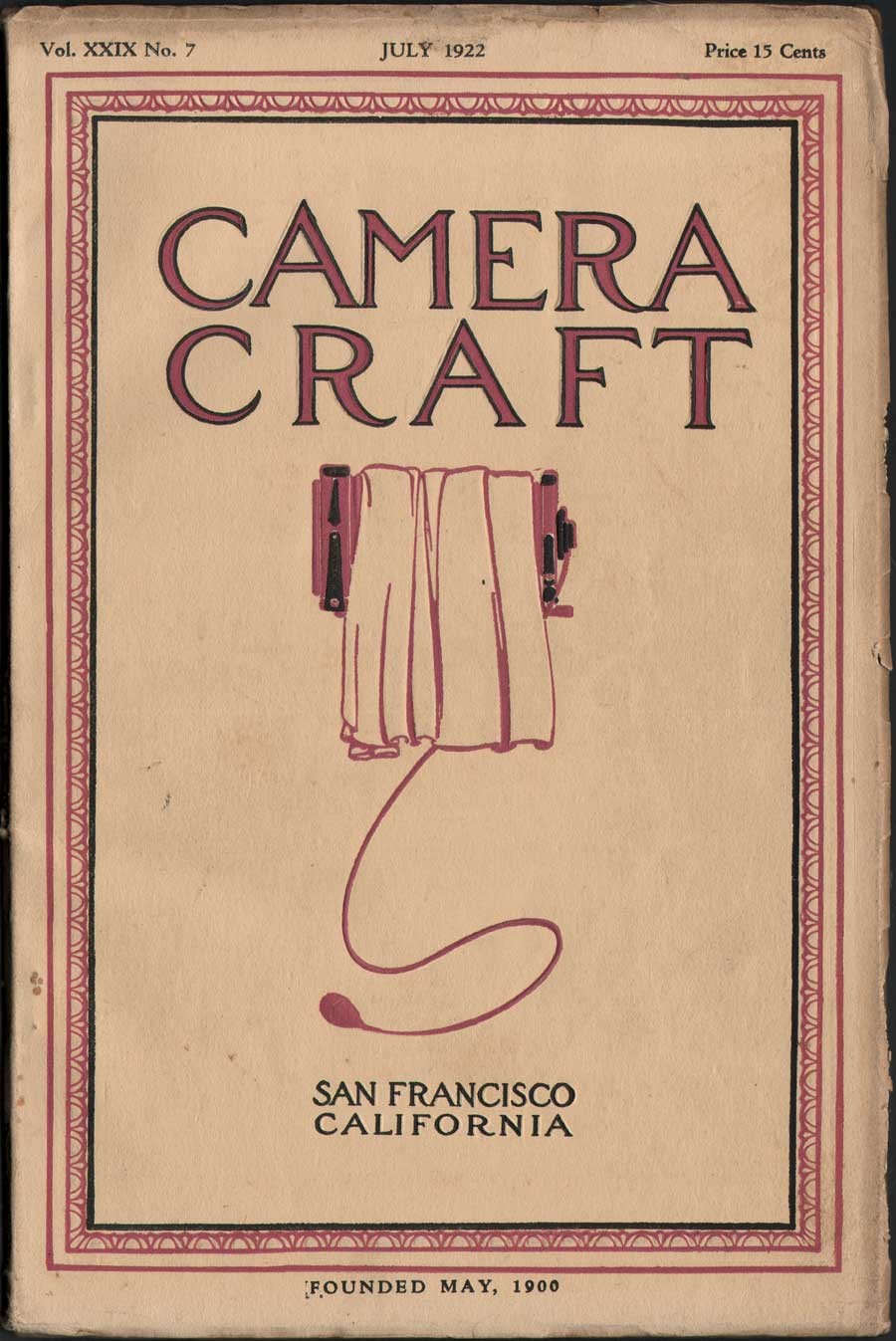 Cover Design: Camera Craft magazine: San Francisco, CA: July, 1922: 26.5 x 17.5 cm: two-color wood engraving : unknown artist and printer: cover price at upper right corner 15¢. This uncredited Camera Craft cover design first debuted with the January 1913 issue and featured a simple design of a plate camera shown in profile(lens board on right side) with dark cloth draped at center and bulb shutter release cable hanging down. This design lasted through the June, 1923 issue and was replaced with illustrations of architectural landmarks, notable western scenery and other thematic drawings done by San Francisco artist W.R. Potter through the September, 1924 issue. From: PhotoSeed Archive
Cover Design: Camera Craft magazine: San Francisco, CA: July, 1922: 26.5 x 17.5 cm: two-color wood engraving : unknown artist and printer: cover price at upper right corner 15¢. This uncredited Camera Craft cover design first debuted with the January 1913 issue and featured a simple design of a plate camera shown in profile(lens board on right side) with dark cloth draped at center and bulb shutter release cable hanging down. This design lasted through the June, 1923 issue and was replaced with illustrations of architectural landmarks, notable western scenery and other thematic drawings done by San Francisco artist W.R. Potter through the September, 1924 issue. From: PhotoSeed Archive
It was sometime in the 1890s, photographic historian Christian A. Peterson notes, that he “first used his wife’s Kodak camera to make snapshots and soon began searching the photographic periodicals for information and advice.” (7.) His editorship of Camera Craft as momentous professional occasion aside, Sig’s immersion in all things Photographic may very well have reached a high-point by 1933, the year he became a charter member of the Photographic Society of America as well as being honored a Fellow of the Royal Photographic Society.
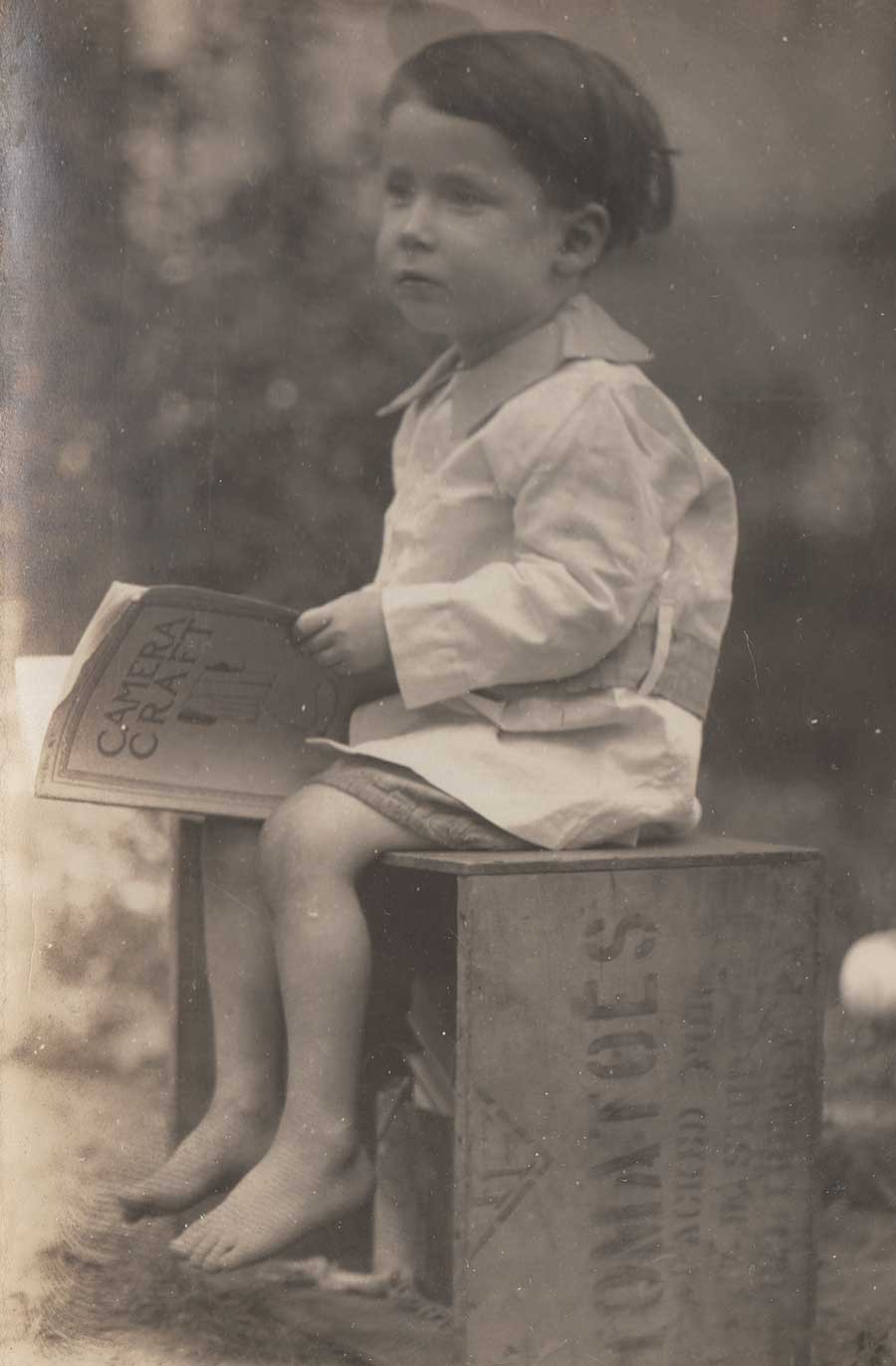 Detail: "Child Sitting on Tomato Crate Holding Camera Craft Magazine": by anonymous American photographer printed as unmailed postcard: gelatin silver print ca. 1920-25: 11.6 x 8.8 | 13.8 x 8.8 cm: written in graphite on verso: "with Love. Ellsworth" with the name "Walter" opposite address field. Child sits on crate stenciled on side as being from Pennsylvania-indicated "Packed For….PA " on side, with photo purchased from Parma, MI collector. From: PhotoSeed Archive
Detail: "Child Sitting on Tomato Crate Holding Camera Craft Magazine": by anonymous American photographer printed as unmailed postcard: gelatin silver print ca. 1920-25: 11.6 x 8.8 | 13.8 x 8.8 cm: written in graphite on verso: "with Love. Ellsworth" with the name "Walter" opposite address field. Child sits on crate stenciled on side as being from Pennsylvania-indicated "Packed For….PA " on side, with photo purchased from Parma, MI collector. From: PhotoSeed Archive
Photography in itself however was not his only reason for being during his professional career as editor, and even earlier as a musician. This was because Sig was a romantic at heart, a dreamer who had a great fondness for language, and the will to commit it to paper. Starting out for example, only in his early 20’s, he composed the following poem for the April, 1895 issue of the California-based magazine Overland Monthly:
PLEASURE.
PLEASURE is like perfect liquor,
Sweet to taste and after taste,
And like, too, in that when gotten
We imbibe too much, then waste,
And we find when pleasure passes
Life is empty as the glasses.
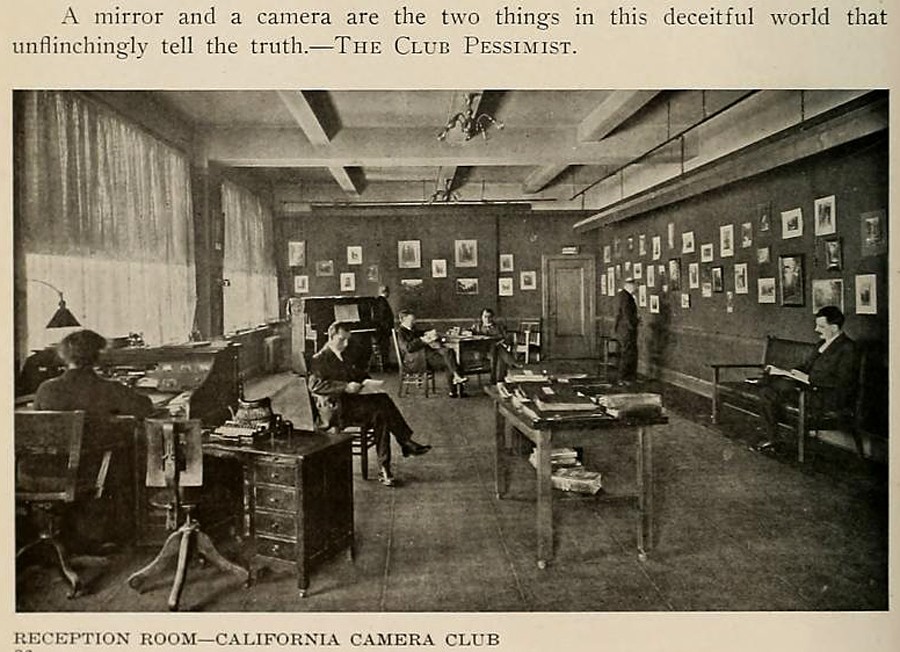 "Reception Room— California Camera Club": 1914: taken by an unknown photographer, this image appeared as a halftone illustration in the February, 1914 issue of Camera Craft for a story on the club, founded in 1890. At the time this appeared the club was located at 833 Market Street in San Francisco. The scene shows members seated with an exhibit of photographs on display at rear and on wall at right. Camera Craft regularly featured news of this important club, and future editor of the magazine Sigismund Blumann, although not a member, attended and was an occasional speaker. Photographic historian Christian A. Peterson notes Blumann spoke at this club in 1916 and much later, between 1934-40 attended gatherings here as well as at the Leica Club of Oakland, East Bay Camera Club, Golden Gate Miniature Camera Club, Photographic Society of San Francisco, San Jose Camera Club, and Western Amateur Camera Conclave. From: California State Library: Archive.org
"Reception Room— California Camera Club": 1914: taken by an unknown photographer, this image appeared as a halftone illustration in the February, 1914 issue of Camera Craft for a story on the club, founded in 1890. At the time this appeared the club was located at 833 Market Street in San Francisco. The scene shows members seated with an exhibit of photographs on display at rear and on wall at right. Camera Craft regularly featured news of this important club, and future editor of the magazine Sigismund Blumann, although not a member, attended and was an occasional speaker. Photographic historian Christian A. Peterson notes Blumann spoke at this club in 1916 and much later, between 1934-40 attended gatherings here as well as at the Leica Club of Oakland, East Bay Camera Club, Golden Gate Miniature Camera Club, Photographic Society of San Francisco, San Jose Camera Club, and Western Amateur Camera Conclave. From: California State Library: Archive.org
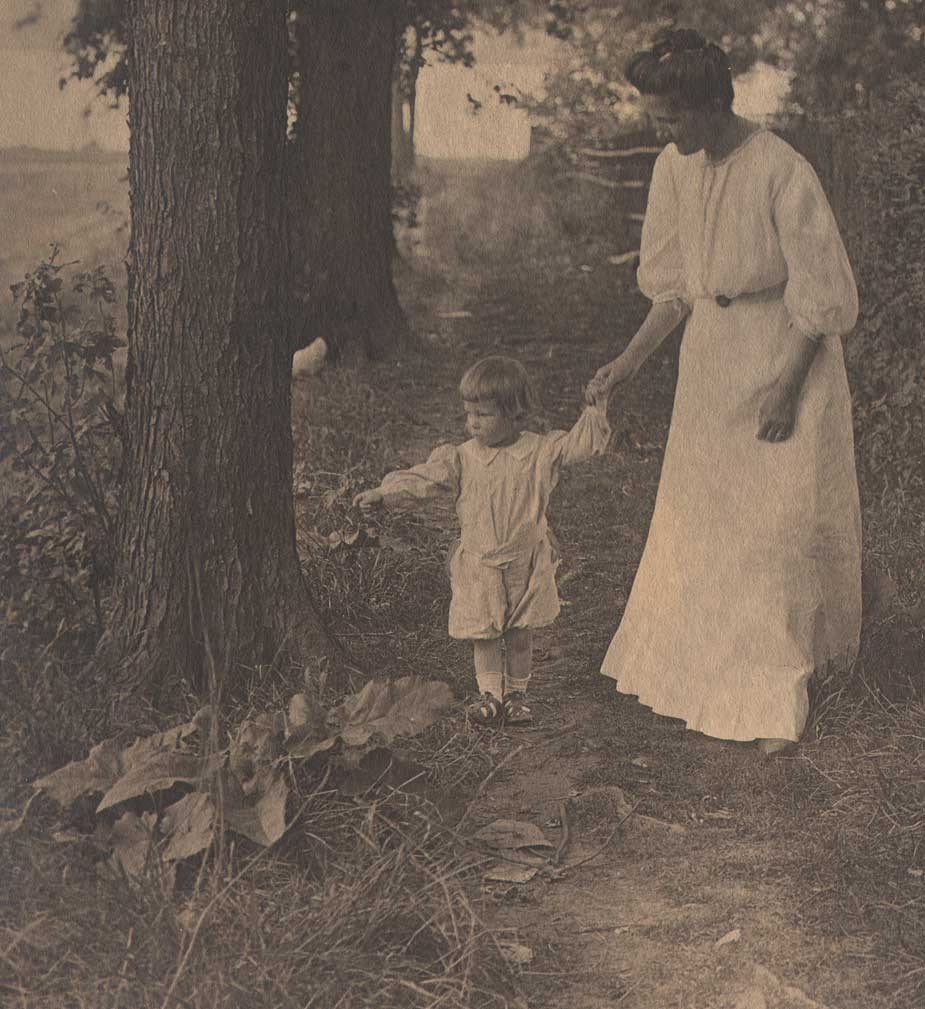 Detail: "Up the Path": Chester Moulton Whitney: American, b. 1873: 1914 or earlier: gelatin silver print: 24.8 x 19.3 cm: This photograph was illustrated as a full-page halftone with printed ornamental Art-Nouveau frame border in the August, 1914 Camera Craft, p. 422, and is a representative example of the pictorialist work that regularly appeared in its pages. From: PhotoSeed Archive
Detail: "Up the Path": Chester Moulton Whitney: American, b. 1873: 1914 or earlier: gelatin silver print: 24.8 x 19.3 cm: This photograph was illustrated as a full-page halftone with printed ornamental Art-Nouveau frame border in the August, 1914 Camera Craft, p. 422, and is a representative example of the pictorialist work that regularly appeared in its pages. From: PhotoSeed Archive
Wearing the hat of Poet-in-Residence at Camera Craft, Sig never neglected this early love of poetry for the publication, often combining his own photographic efforts alongside original compositions. One example, which he titled Lugubrio, though technically not even a real word, appeared in April, 1927, and was his way of simply assigning a mournful, or lugubrious meaning to his own photograph depicting jagged rocks and crashing waves-seen in his dramatic coastal landscape most likely taken on the Pacific coast:
LUGUBRIO
By Sigismund Blumann
The drowned and dead, now turned to stone,
Stand watching by the shore
And you may hear them through the night,
From set of sun to morning light,
As they shall do for evermore,
Weep as they watch, and moan. (p. 177)
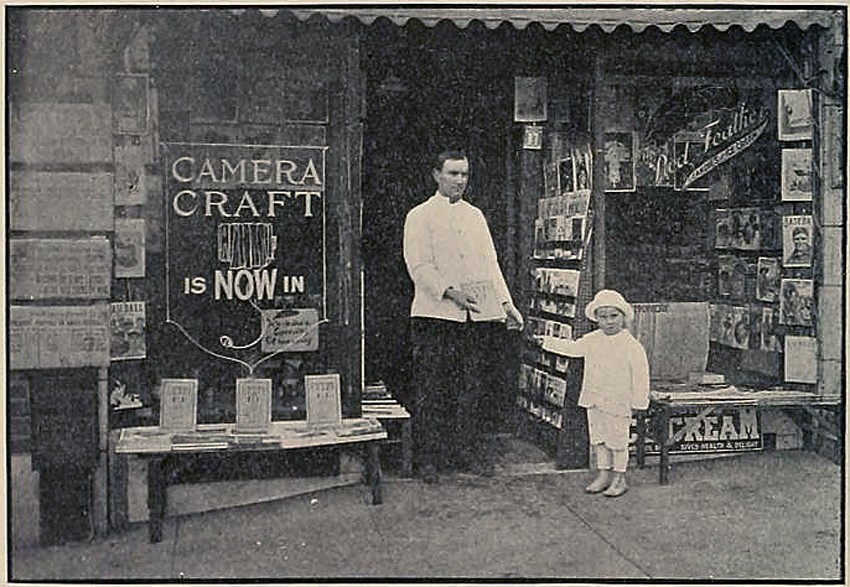 "Camera Craft is Now In": 1914: taken by an unknown photographer and used as a form of soft advertising, this image appeared as a halftone illustration in the June, 1917 issue of Camera Craft. It shows San Francisco business owner J.F. Brandert, owner of the Red Feather Store at 435 Jones Street, handing off a copy of the journal to a young visitor, with a display of three issues propped up on a bench at left in front of a window lettered with a graphic of the journal's cover: "CAMERA CRAFT IS NOW IN". From: California State Library: Archive.org
"Camera Craft is Now In": 1914: taken by an unknown photographer and used as a form of soft advertising, this image appeared as a halftone illustration in the June, 1917 issue of Camera Craft. It shows San Francisco business owner J.F. Brandert, owner of the Red Feather Store at 435 Jones Street, handing off a copy of the journal to a young visitor, with a display of three issues propped up on a bench at left in front of a window lettered with a graphic of the journal's cover: "CAMERA CRAFT IS NOW IN". From: California State Library: Archive.org
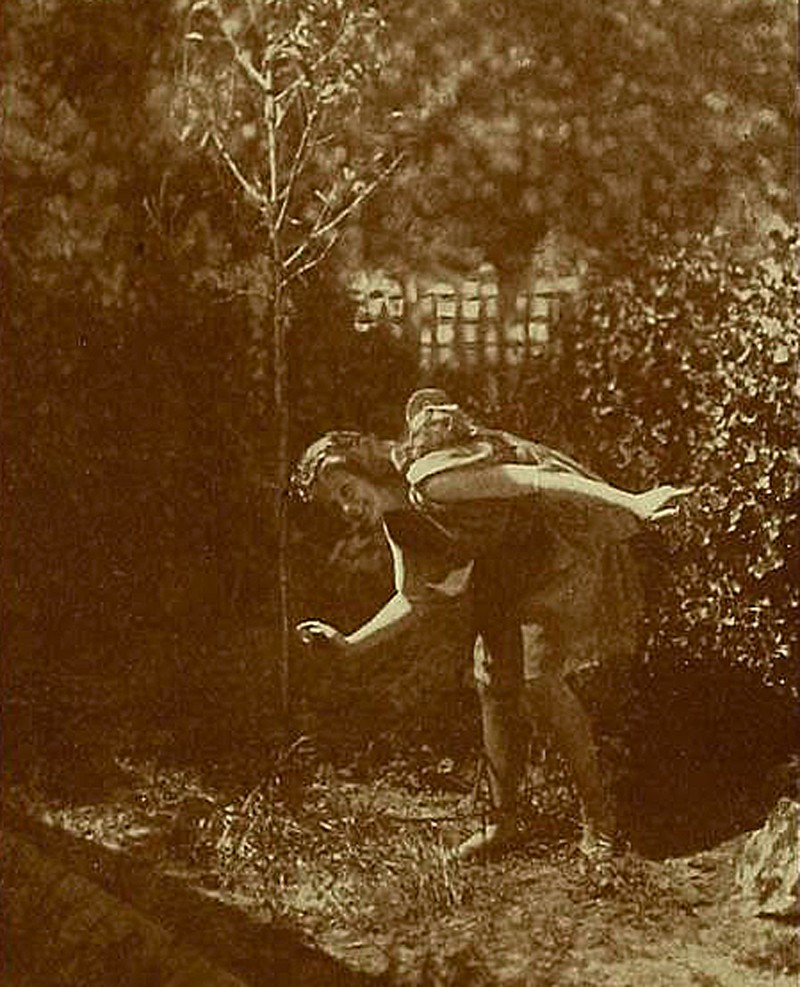 "When From Behind the Moondipt Bush Titania Floated in a Silver Haze": 1917 or before: Sigismund Blumann, American: This photograph was used as the frontis halftone for the July, 1917 issue of Camera Craft helping to illustrate the article "Poetry and Photography" written by Blumann. The photo shows Vera Hahn, a childhood friend of his eldest daughter Ethel Blumann. (b. 1902) He said of the photo: "She was costumed for a pageant and we all wanted a memento of the charming vision she made in our garden, among the green plants." This early example of Blumann's work also included one of his original poems titled "To Childhood": the first stanza: "Oh blessed youth! When from the enchanted page | Fancy stepped forth and made the unreal real, | When from behind the moondipt bush | Titania floated in a silver haze and greeted me! From: California State Library: Archive.org
"When From Behind the Moondipt Bush Titania Floated in a Silver Haze": 1917 or before: Sigismund Blumann, American: This photograph was used as the frontis halftone for the July, 1917 issue of Camera Craft helping to illustrate the article "Poetry and Photography" written by Blumann. The photo shows Vera Hahn, a childhood friend of his eldest daughter Ethel Blumann. (b. 1902) He said of the photo: "She was costumed for a pageant and we all wanted a memento of the charming vision she made in our garden, among the green plants." This early example of Blumann's work also included one of his original poems titled "To Childhood": the first stanza: "Oh blessed youth! When from the enchanted page | Fancy stepped forth and made the unreal real, | When from behind the moondipt bush | Titania floated in a silver haze and greeted me! From: California State Library: Archive.org
Camera Craft: Western Photographic Journal
Although he’d been a contributor to its’ pages in words and photos after the first decade of being founded, it would be 24 years from the journal’s 1900 founding until Sig would begin to establish an enduring legacy in the history of photography via his role as Editor-in-Chief of Camera Craft. Some historical background on the intents and purposes for this ground-breaking publication are in order.
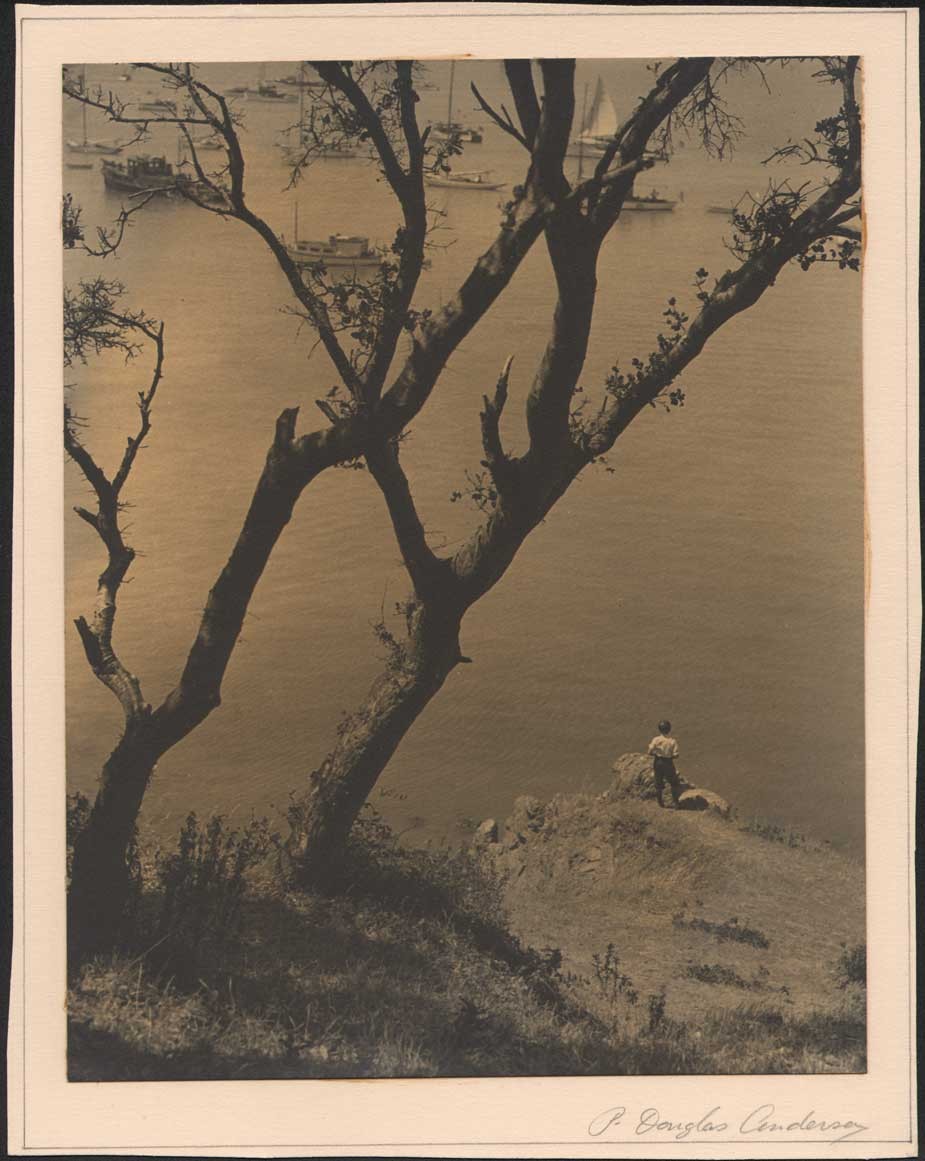 "Boy Looking out onto Bay" (San Francisco?-title supplied by this archive): ca. 1920-25: Paul Douglas Anderson, American 1887-1964: toned bromide or gelatin silver print: 24.2 x 19.0 | 27.5 x 21.6 cm: P. Douglas Anderson was an associate editor of Camera Craft beginning in May, 1923 & became editor-in-chief by January, 1924, continuing through the July issue. He was replaced by Sigismund Blumann the following month. Active in photography between 1910-1940's, Anderson was a member of the Camera Pictorialists of Los Angeles and Pictorial Photographers of America. From: PhotoSeed Archive
"Boy Looking out onto Bay" (San Francisco?-title supplied by this archive): ca. 1920-25: Paul Douglas Anderson, American 1887-1964: toned bromide or gelatin silver print: 24.2 x 19.0 | 27.5 x 21.6 cm: P. Douglas Anderson was an associate editor of Camera Craft beginning in May, 1923 & became editor-in-chief by January, 1924, continuing through the July issue. He was replaced by Sigismund Blumann the following month. Active in photography between 1910-1940's, Anderson was a member of the Camera Pictorialists of Los Angeles and Pictorial Photographers of America. From: PhotoSeed Archive
First based in San Francisco at 120 Sutter Street and issued monthly by the Camera Craft Publishing Company under the direction of editor W.G. Woods, the photographic journal Camera Craft was founded on the principles the West Coast of the United States should have an equal geographical mouthpiece of influence to counter that of the East Coast in promoting photography-for both professional and amateur workers. (to this end a separate page was devoted monthly to the happenings of many California amateur clubs) For the first issue of May, 1900, the following observations and arguments were made by the journal in support of these ideals:
The growth of photography, the introduction of simplifying methods in scientific picture-making, during the past twenty-five years is one of the wonders of the century. The phenomenal strides made by the photographic inventors of the world, resulting in the production of simple devices and convenient appliances, have made photography in all of its branches an almost universal fad. The Pacific Coast, ever ready to appreciate the merits of an innovation, has kept well abreast in the steady march of progress.
The wonderful climate of California lends itself enthusiastically to the wants of the photographer. The hand of Nature has reared, in eternal beauty, scenic effects unequaled elsewhere on earth. The very atmosphere of the Far West encourages the artistic impulse of its people. With such great natural advantages it is small wonder that when the western photographer has seen fit to cross the continent to compete with the eastern brotherhood he returns with laurels upon his brow. Not less wonderful is the existence of the largest Camera Club in the world in the city of the Golden Gate.
Yet, strange as it may seem, this great class of enthusiasts, this immense body of earnest workers has never been represented by a publication worthy of its trust. The photographers of the West have for years depended upon the journals of the East for enlightenment, but have looked in vain for recognition in their columns. It is to remedy this condition that Camera Craft now makes its bow to the public.
As to the scope of Camera Craft nothing can be said; it will have to speak for itself. The only promise made is the sincere intent on the part of the publishers to improve with each succeeding issue. The one hope of the magazine is that it may be so conducted as to meet the approbation of its readers and lend its aid to the material welfare of all interested in photography, whether for pleasure or for profit. (p. 26)
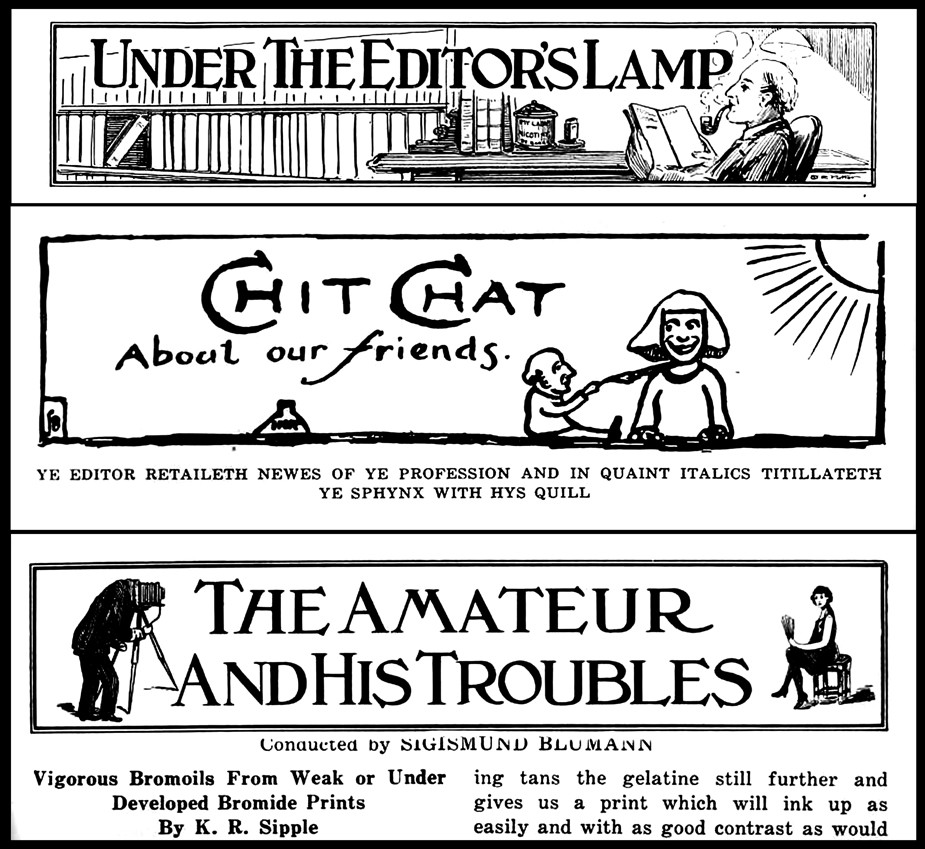 This triptych shows the three different Camera Craft magazine columns editor-in-chief Sigismund Blumann was involved with during his tenure at the journal from 1924-1933. "Under The Editor's Lamp" at top featured a caricature of the editor puffing a way on his trusty pipe while "Chit Chat About our Friends" at middle is comically subtitled "Ye Editor Retaileth Newes of Ye Profession And In Quaint Italics Titillateth Ye Sphynx With Hys Quill". "The Amateur And His Troubles", "conducted", appropriately enough by the man who had once made his living as a musician and orchestra leader, who already a feature of the publication when Blumann took over. From: PhotoSeed Archive
This triptych shows the three different Camera Craft magazine columns editor-in-chief Sigismund Blumann was involved with during his tenure at the journal from 1924-1933. "Under The Editor's Lamp" at top featured a caricature of the editor puffing a way on his trusty pipe while "Chit Chat About our Friends" at middle is comically subtitled "Ye Editor Retaileth Newes of Ye Profession And In Quaint Italics Titillateth Ye Sphynx With Hys Quill". "The Amateur And His Troubles", "conducted", appropriately enough by the man who had once made his living as a musician and orchestra leader, who already a feature of the publication when Blumann took over. From: PhotoSeed Archive
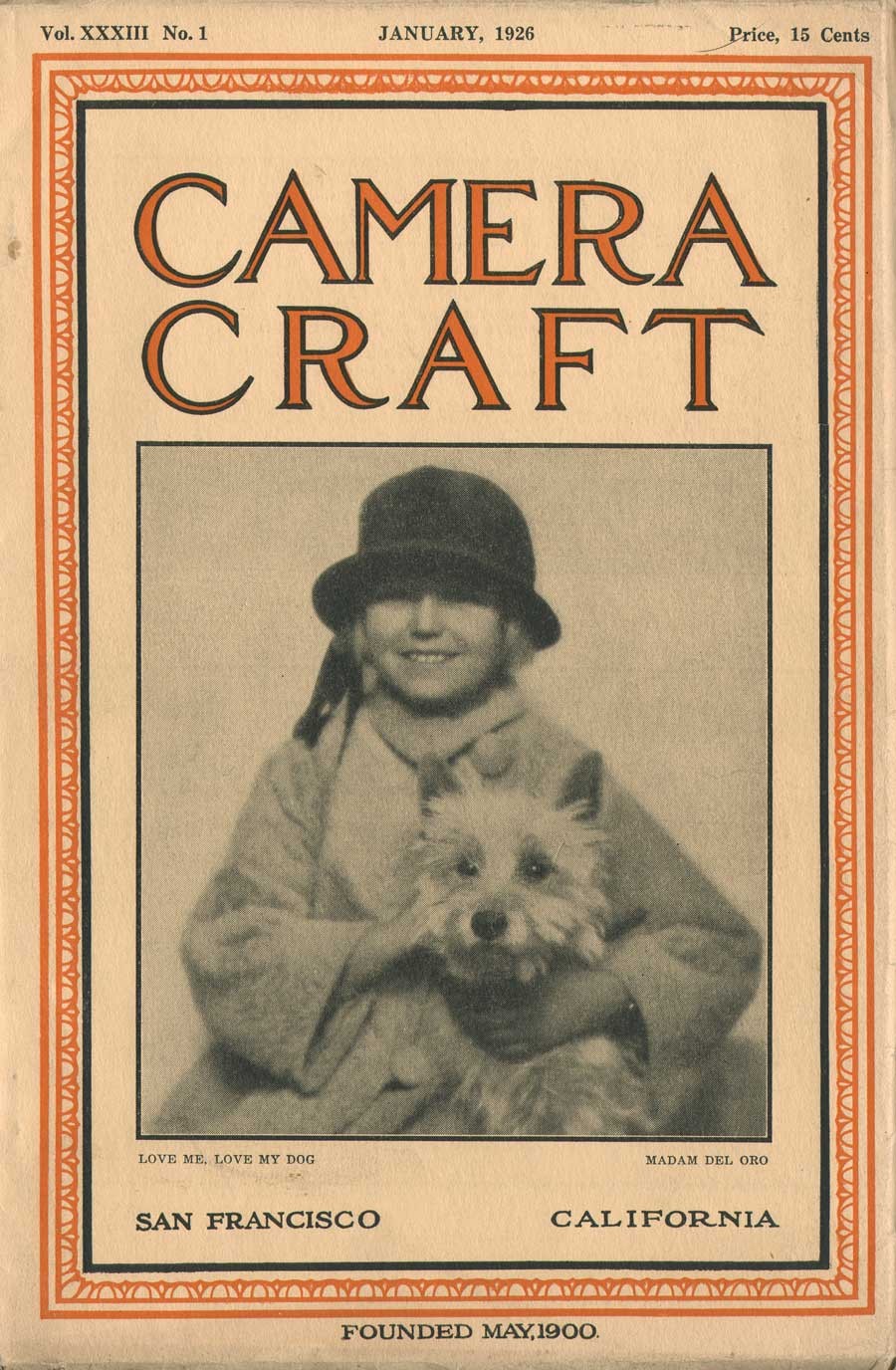 Cover Design: Camera Craft magazine: San Francisco, CA: January, 1926: Press of the Hansen Company, San Francisco: 26.5 x 17.5 cm: two-color wood engraved border design with inset halftone photograph: "Love Me, Love My Dog" by Madam Del Oro: American? 13.3 x 12.1 cm : cover price at upper right corner 15¢. One of the journal's seemingly obvious decisions, at least for the time, was to feature an actual photograph as a cover illustration for Camera Craft. Editor Blumann made this decision beginning with the October, 1924 issue. From: PhotoSeed Archive
Cover Design: Camera Craft magazine: San Francisco, CA: January, 1926: Press of the Hansen Company, San Francisco: 26.5 x 17.5 cm: two-color wood engraved border design with inset halftone photograph: "Love Me, Love My Dog" by Madam Del Oro: American? 13.3 x 12.1 cm : cover price at upper right corner 15¢. One of the journal's seemingly obvious decisions, at least for the time, was to feature an actual photograph as a cover illustration for Camera Craft. Editor Blumann made this decision beginning with the October, 1924 issue. From: PhotoSeed Archive
With its second issue for June, ambitions quickly shifted in support of the establishment of a West-Coast professional organization:
“Camera Craft intends to agitate the question of a Pacific Coast Convention of photographers. General inquiry throughout the state has led to the belief that such a convention is not only desirable but an actual need to those who make their living through the lens and shutter.” …We recall instances where photographers of this coast have attended conventions in the East and have returned with easy honors. Camera Craft would be pleased to learn of a serious consideration of the idea. A convention held in San Francisco with a first-class salon as an adjunct would undoubtedly lead to a permanent organization, and result in the advancement of the craft in a manner hitherto untried.” (p. 68)
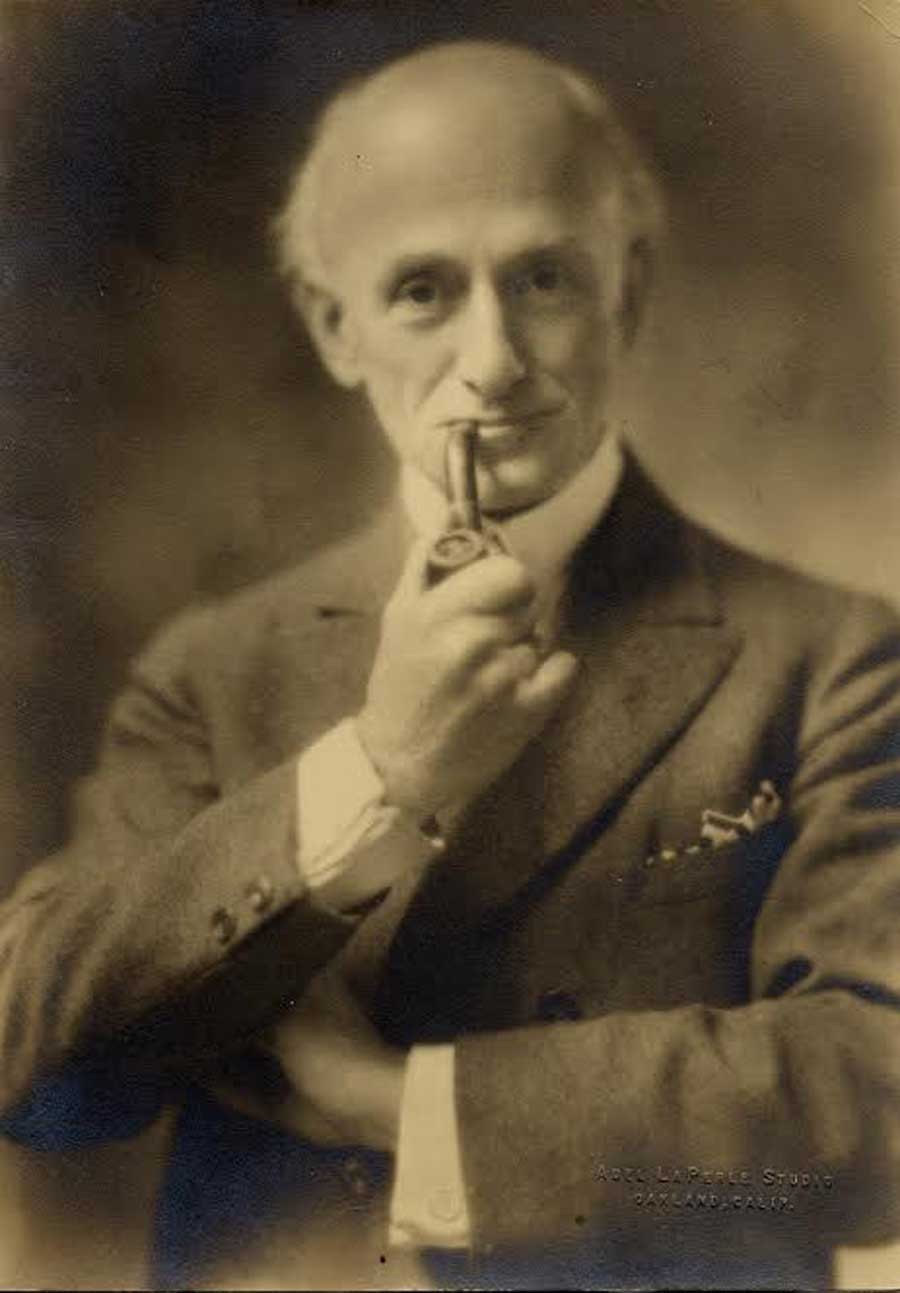 "Portrait of Sigismund Blumann": ca. 1928: Adel LaPerle Studio, Oakland, CA: gelatin silver print: Blumann was editor-in-chief of San Francisco-based Camera Craft magazine from 1924-1933: Photograph courtesy Thomas High
"Portrait of Sigismund Blumann": ca. 1928: Adel LaPerle Studio, Oakland, CA: gelatin silver print: Blumann was editor-in-chief of San Francisco-based Camera Craft magazine from 1924-1933: Photograph courtesy Thomas High
Although preceded geographically and in scope by the Pacific Coast Photographer, a short-lived monthly established in 1892 and believed to have ceased publication several years later, Camera Craft thrived as a robust Western photographic journal for the next 41 years. It first accomplished this under the capable tenure of editor Fayette J. Clute in the early decades of the publication before Sig took over in 1924, and was carried forward by him and others until the economic and human realities of World War II forced it’s hand. This occurred after the March, 1942 issue, when Camera Craft ironically headed back East so to speak, when it was absorbed by the Boston-based American Photography magazine. An editorial appearing in the final issue stated the decision to cease publishing was made because editor George Allen Young was taking his place in the armed services among other realities.
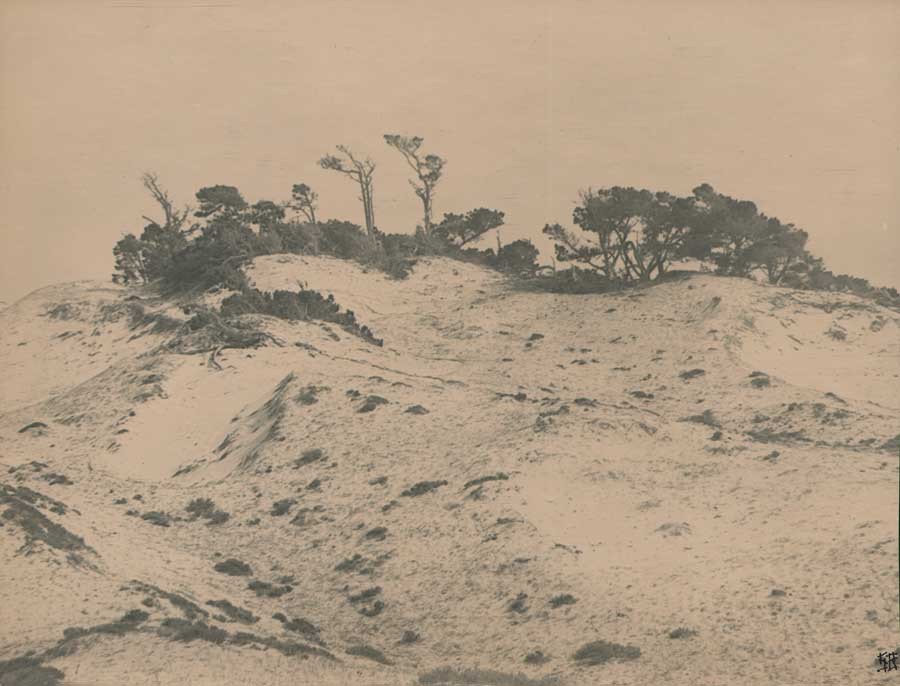 "Japonica" : Sigismund Blumann, American: ca 1920-40. gelatin silver print: 17.2 x 22.3 cm : This is a fine example of Blumann's pictorialist landscape work showing sand dunes and scrub trees, and was most likely taken on the West coast of the United States. Variants of this photograph have been similarly titled by the artist "Dune Pattern" and "Japanesque". This example signed in stylized Japanese initials at lower right corner: "SB". Three variants held by Minneapolis Institute of Arts: Accession #s: 99.230. (13-15) : From: PhotoSeed Archive
"Japonica" : Sigismund Blumann, American: ca 1920-40. gelatin silver print: 17.2 x 22.3 cm : This is a fine example of Blumann's pictorialist landscape work showing sand dunes and scrub trees, and was most likely taken on the West coast of the United States. Variants of this photograph have been similarly titled by the artist "Dune Pattern" and "Japanesque". This example signed in stylized Japanese initials at lower right corner: "SB". Three variants held by Minneapolis Institute of Arts: Accession #s: 99.230. (13-15) : From: PhotoSeed Archive
Sig As Camera Craft Editor: 1924-33
Photographic historian Christian A. Peterson, who called Camera Craft “the leading West Coast photographic monthly” and whose in-depth reassessment of Sigismund Blumann’s life and career was cited at the conclusion of Tom High’s short biography of his grandfather, called Sigismund Blumann:
”a prominent tastemaker in Californian photography during the 1920s and 1930s”. (8.)
Having an audience of 8000 monthly Camera Craft readers after coming aboard as chief editor in 1924 was surely a great start to becoming a tastemaker, but Sig proved his worth during the following nine years for his ability to impart to readers the essential knowledge of the ever-changing progress of photography. This took place in conjunction with his maintaining the vision of remaining true to himself-no matter how quirky some of his readers undoubtedly perceived him- while unashamedly promoting photographic talent in the pages of the magazine where he saw fit.
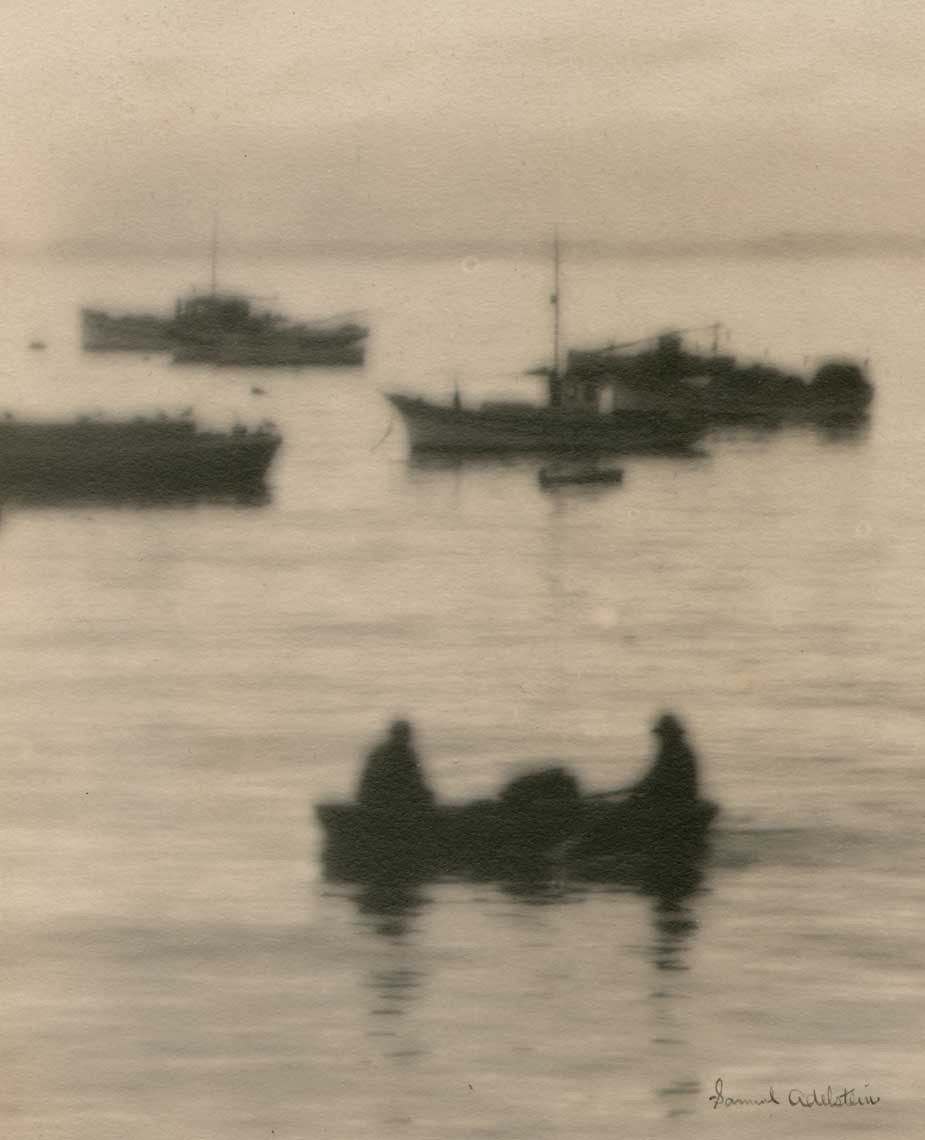 Detail: "Fishing Boats at Anchor" (probably Monterey Bay, CA) Samuel Adelstein, American, California: b. 1866?-d. 1934: silver bromide print ca. 1920-25: 18.5 x 13.6 | 40.6 x 25.4 cm: Adelstein was an active member of the California Camera Club whose pictorial works including a series of nude studies were published in Camera Craft in January, 1918 as part of the article: "An Enthusiast's Experience". The year before, the journal stated he was "an enthusiastic amateur photographer, a native son, a Director of the California Camera Club, and one of the Board of Governors of the Civic League of Improvement Clubs and Associations": Immersing himself in the art of photography around 1916, he specialized in making enlargements (from sharp negatives) with a soft-focus Verito lens. From: PhotoSeed Archive
Detail: "Fishing Boats at Anchor" (probably Monterey Bay, CA) Samuel Adelstein, American, California: b. 1866?-d. 1934: silver bromide print ca. 1920-25: 18.5 x 13.6 | 40.6 x 25.4 cm: Adelstein was an active member of the California Camera Club whose pictorial works including a series of nude studies were published in Camera Craft in January, 1918 as part of the article: "An Enthusiast's Experience". The year before, the journal stated he was "an enthusiastic amateur photographer, a native son, a Director of the California Camera Club, and one of the Board of Governors of the Civic League of Improvement Clubs and Associations": Immersing himself in the art of photography around 1916, he specialized in making enlargements (from sharp negatives) with a soft-focus Verito lens. From: PhotoSeed Archive
But some things remained the same after he took over. One, perhaps appropriate considering his musical background, was his retention of the subhead: “Conducted by Sigismund Blumann” for the journal’s long-established editorial column The Amateur And His Troubles previously edited by Paul Douglas Anderson. This time, an actual orchestra conductor was indeed stepping in to conduct editorial affairs! Keeping this personal touch intact-especially to those who knew him as someone passionate of music his entire life, was just one way of his remaining connected with readers as well as professional and social acquaintances in the Bay Area. Under Sig’s moderation, the column continued to offer advice dispensed by any number of well regarded authors who broke down and offered solutions to problems encountered by amateurs in the field relating to anything from photographic equipment to darkroom dilemmas.
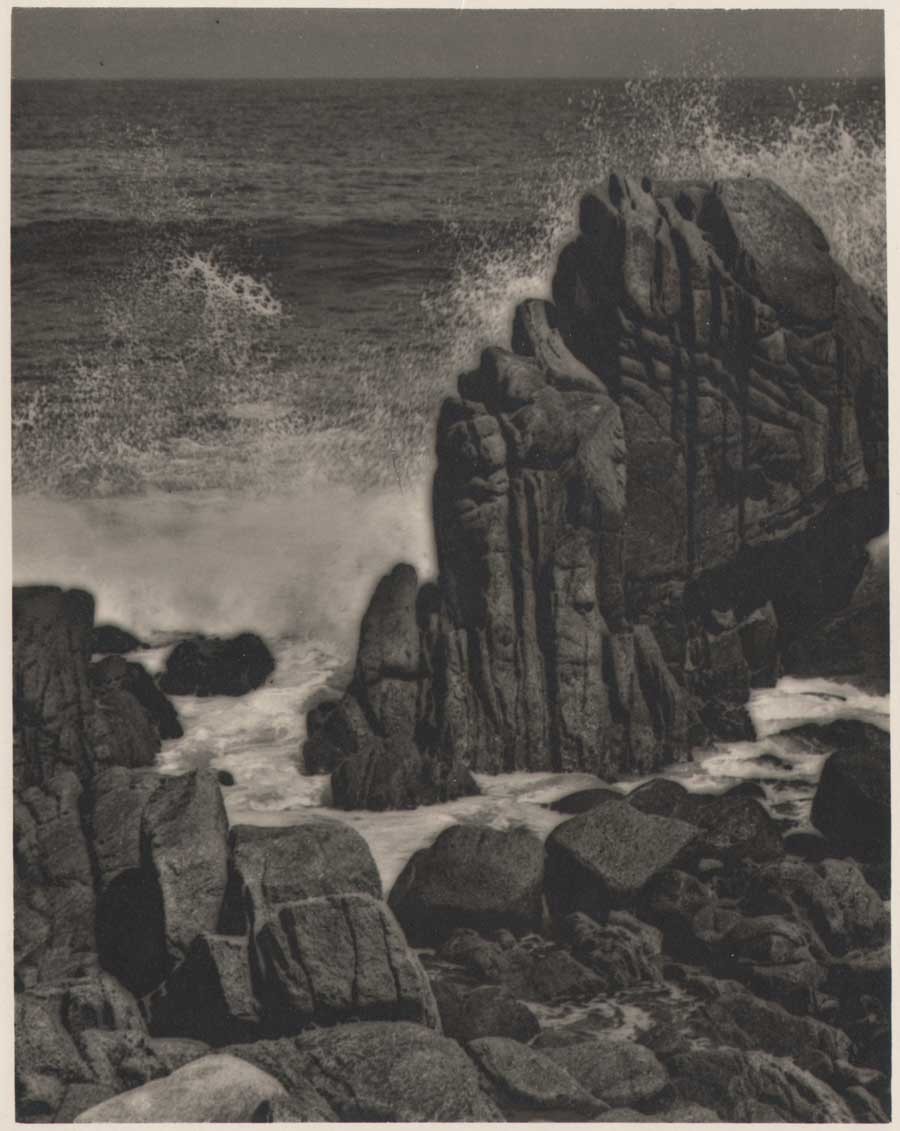 "Lugubrio": Sigismund Blumann, American: 1927 or before: gelatin silver print: 20.8 x 16.4 | 25.3 x 20.1 cm: This image, reproduced as a large halftone, was published on the same page as an accompanying poem of the same title for the April, 1927 issue of Camera Craft. The scene was most likely taken along the Pacific coastline. From: PhotoSeed Archive
"Lugubrio": Sigismund Blumann, American: 1927 or before: gelatin silver print: 20.8 x 16.4 | 25.3 x 20.1 cm: This image, reproduced as a large halftone, was published on the same page as an accompanying poem of the same title for the April, 1927 issue of Camera Craft. The scene was most likely taken along the Pacific coastline. From: PhotoSeed Archive
His second column, a new feature which debuted with the November, 1924 issue, was called CHIT CHAT About our friends. A vehicle for Sig’s effusive boosterism of photography in general, both professional and amateur, it was written in a style that might best be described, amusingly, as slightly syrupy in tone but delivered with erudition. Profiles on photographers he found interesting, and news of California camera clubs were a constant monthly feature of the column in addition to news of major upcoming exhibitions as well as critiques and results from those salons happening not only on the West Coast but throughout the United States and beyond. Comically subtitled: “Ye Editor Retaileth Newes of Ye Profession And In Quaint Italics Titillateth Ye Sphynx With Hys Quill”, the column’s “titillations” were often just longish aphorisms managing implied or direct associations to something photographic. Appearing rather infrequently at the column’s outset and disappearing altogether by August, 1931 when this inventive take on the English language was eliminated, they appeared from time to time, with several reprinted below for his January, 1926 column:
“Every time you get the best of a customer you have cheated yourself.”
“The most expensive lens may not be the best but the cheapest is pretty sure to be the worst.”
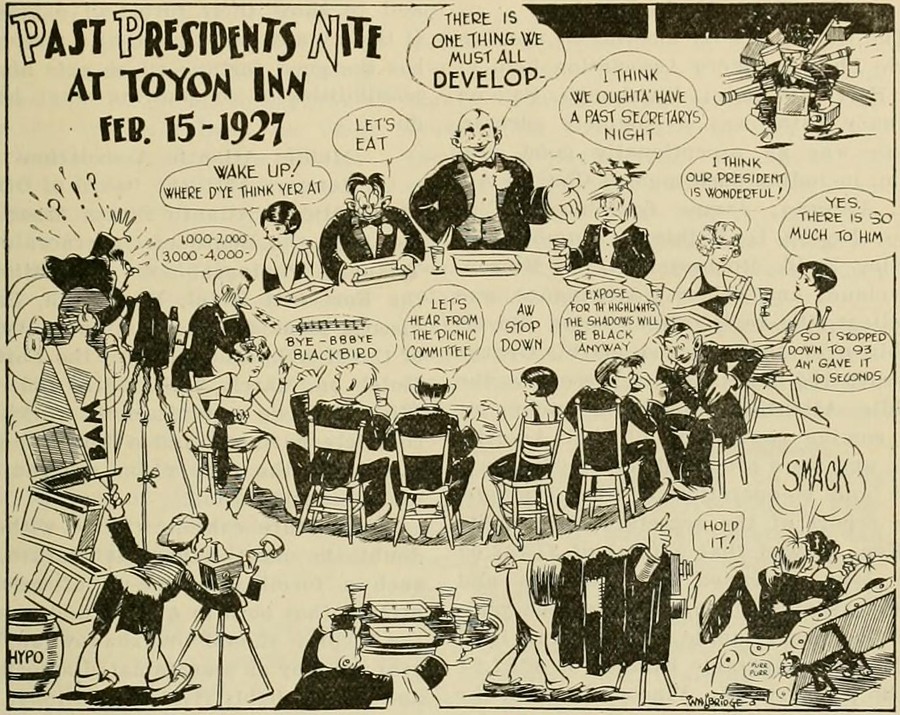 "Past Presidents Nite At Toyon Inn Feb. 15- 1927" : by artist W.A. Bridge, American -California? : Used as a halftone in the March, 1927 issue of Camera Craft, this humorous cartoon illustrated a dinner dance commemorating a gathering of past presidents of the Pacific International Photographers' Association which took place at San Leandro's Toyon Inn on Feb. 15, 1927. Sigismund Blumann, who served as host of the event, made sure to comment in the pages of Camera Craft magazine that "refreshments" of a most unusual kind: ie: inebriating, were served at the event during the era of American Prohibition. From: California State Library: Archive.org
"Past Presidents Nite At Toyon Inn Feb. 15- 1927" : by artist W.A. Bridge, American -California? : Used as a halftone in the March, 1927 issue of Camera Craft, this humorous cartoon illustrated a dinner dance commemorating a gathering of past presidents of the Pacific International Photographers' Association which took place at San Leandro's Toyon Inn on Feb. 15, 1927. Sigismund Blumann, who served as host of the event, made sure to comment in the pages of Camera Craft magazine that "refreshments" of a most unusual kind: ie: inebriating, were served at the event during the era of American Prohibition. From: California State Library: Archive.org
Lastly, and most importantly, one of the most personal reasons for Camera Craft’s success under Sig was his entirely self-written Under the Editor’s Lamp column, debuting with the April, 1926 issue. Already a fixture by means of the pen to his many readers-in prose as well as poetry- the column gave a final say so to speak to his personal views-conservative to be sure-on just about anything going on regarding photography and musings on current events. With accompanying column artwork by California artist W.R. Potter portraying Sig kicking back while puffing his pipe and seated at a library desk, the column became an effective way for this journal’s Editor-in-Chief to assume the role of oracle and brand ambassador. Sig’s short forward for his first Under the Editor’s Lamp :
When the desk is cleared of paste-pot and shears and the lamp is lit, it is good to put a match to the freshly loaded, old pipe and take a puff or two, letting the mind’s mind relax into mere dreams. The lamp is a sentimental fiction, of course, being a standardized glass bowl with a bulb glowing through, but the pipe is real, the mood is sincere, and we hope the mind exists, more or less.
Out go our thoughts to readers unseen, perhaps never to be met except as a large, critical, voracious body of men and women who consume the forty-eight pages of pictures and text and off-hand decide the fare has been very good, fair, or rotten. Little do they care what labor, what hopes, what ambitions went into every line and every illustration. Why should they. The best is no better than their due. (p.180)
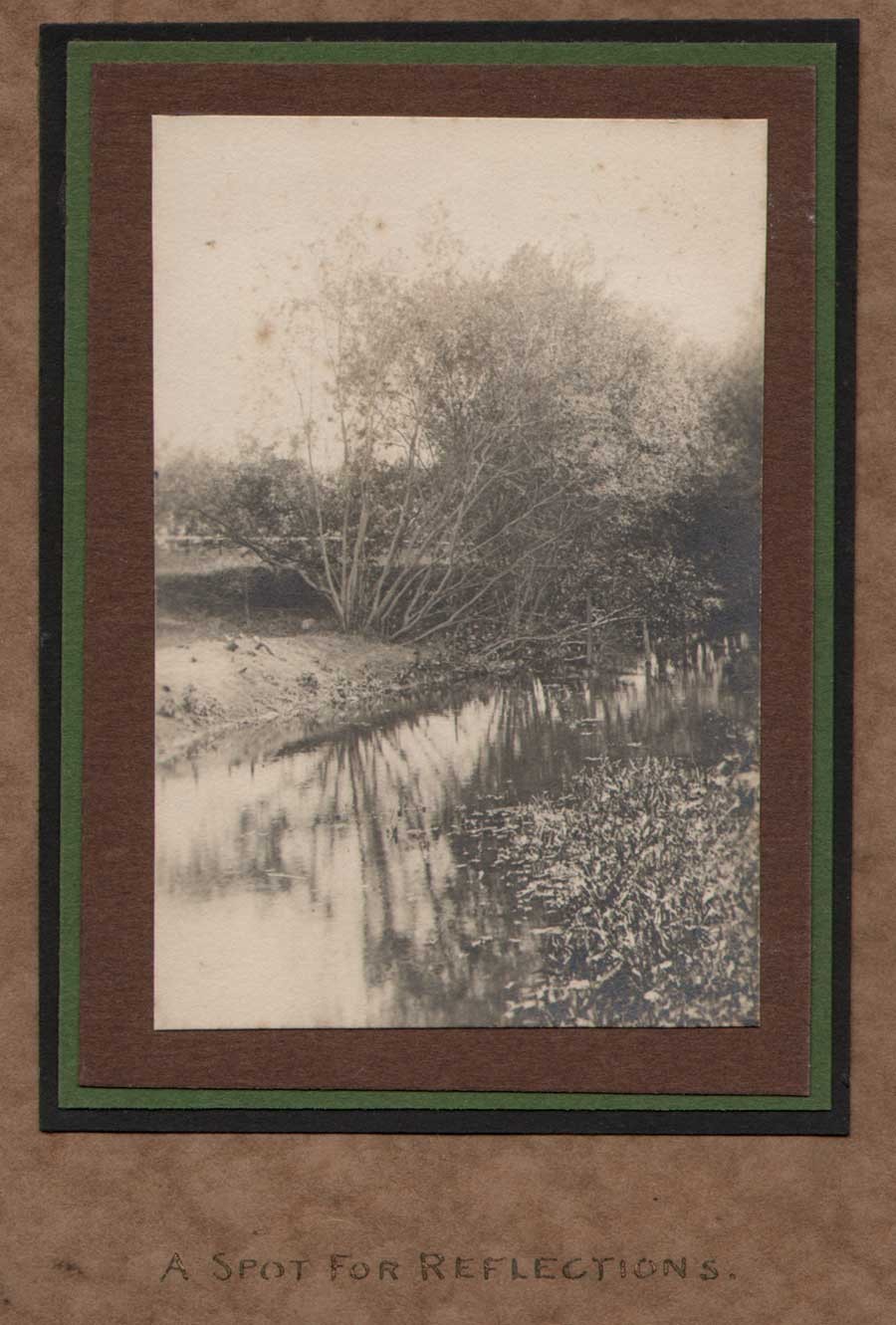 "A Spot for Reflections": Sigismund Blumann, American: ca. 1925-30: gelatin silver print : 9.8 x 6.5 | 18.2 x 14.5 cm : perhaps taken in Oakland or the Inverness area of Marin County, CA, this is a fine example of Blumann's pictorialist work in which he has titled the composition in gold lettering and triple-mounted the image onto fine art paper supports. From: PhotoSeed Archive
"A Spot for Reflections": Sigismund Blumann, American: ca. 1925-30: gelatin silver print : 9.8 x 6.5 | 18.2 x 14.5 cm : perhaps taken in Oakland or the Inverness area of Marin County, CA, this is a fine example of Blumann's pictorialist work in which he has titled the composition in gold lettering and triple-mounted the image onto fine art paper supports. From: PhotoSeed Archive
M.Q. Developer to Develop Good Feeling
Because Camera Craft billed itself the official organ of the Pacific International Photographers’ Association, (PIPA) with owner Ida M. Reed acting as Secretary and headquartered in the same San Francisco offices as the journal, (703 Market in Claus Spreckles Building) news of the Association-which covered a wide western geographic area including membership from Alaska, Alberta, Arizona, British Columbia, California, the Hawaiian Islands, Idaho, Montana, Nevada, Oregon, Utah and Washington states- became a regular monthly feature of the previously discussed Chit-Chat column. By 1927, Sig was hitting full-stride at Camera Craft, his writing skills undoubtedly honed through his reminisces featured in the Editor’s Lamp column.
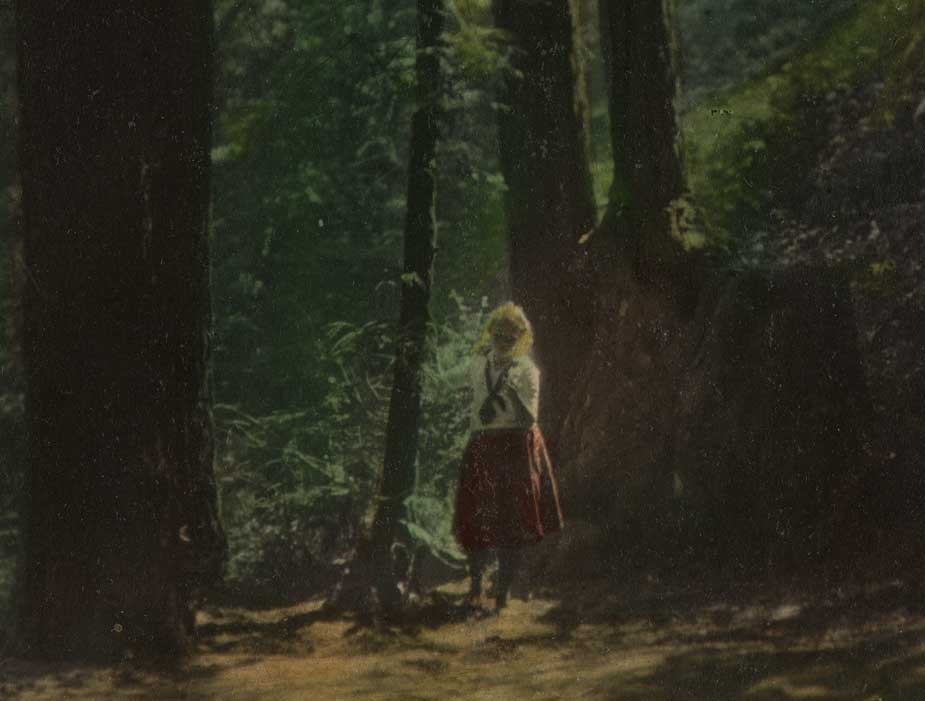 Detail: "Vera in the Woods": Sigismund Blumann, American: 1920-25: hand-colored gelatin silver print: 24.2 x 18.6 cm: Taken among a stand of Redwood trees, perhaps in the present-day Muir Woods National Monument in Marin County, CA, the subject of this photograph is believed to show the photographer's youngest daughter Vera Blumann, b. 1911. Blumann was in love with the outdoors, and frequently took part in extended camping trips with family members to hike and photograph areas of beauty in California and the Pacific Northwest-trips he wrote about in the pages of Camera Craft. See variant: Minneapolis Institute of Arts: Accession #99.231.15. From: PhotoSeed Archive
Detail: "Vera in the Woods": Sigismund Blumann, American: 1920-25: hand-colored gelatin silver print: 24.2 x 18.6 cm: Taken among a stand of Redwood trees, perhaps in the present-day Muir Woods National Monument in Marin County, CA, the subject of this photograph is believed to show the photographer's youngest daughter Vera Blumann, b. 1911. Blumann was in love with the outdoors, and frequently took part in extended camping trips with family members to hike and photograph areas of beauty in California and the Pacific Northwest-trips he wrote about in the pages of Camera Craft. See variant: Minneapolis Institute of Arts: Accession #99.231.15. From: PhotoSeed Archive
The following account is a result of this, of Sig’s prodigious social engagement with members active in the Bay-area camera club scene. In a humorous yet telling example of his own admission to preserve the rightful history of one particular PIPA (often referred to as a club) meeting for Chit-Chat, the March, 1927 issue duly reported on the Past Presidents Night dinner dance at San Leandro’s Toyon Inn on Feb. 15, 1927. Taking place when Prohibition was still the law of the land in America, (9.) Sig’s account made sure to include the lengths employed at the soirée in order for those attending to enjoy the social, and inebriating benefits of some “liquid cheer”:
But hold, before we close it must be chronicled as it shall be inscribed in the archives of the club that each guest found a developing tray and two glass graduates before him. It was a paper tray, so that when dropped the falling tray might not raise the deuce. In one of the two ounce graduates water was served and in the other M.Q. developer to develop good feeling. A bucket of Hypo was kept in the ante-room to fix the police, and everything was provided to make a perfect picture except bromide. If any was needed it was the next morning. (p. 145: M.Q. was an alkaline developer for gelatine emulsions combining Metol and hydroquinone)
 "Yosemite Falls | Yosemite Valley": Sigismund Blumann, American: dated 1926 & signed: "Dry Point Etching" ie: most likely a Kallitype or bleached and toned print on Vitava E (tching) chlorobromide paper: 13.1 x 9.0 | 23.7 x 16.5 cm: A specialist in alternative darkroom processes, particularly Kallitype, Blumann perfected his "Dry Point Etching" process and described it in lengthy articles in Camera Craft in 1925 and later in July, 1934 for his own Photo Art monthly using the pen name "Charles H. Fitzpatrick." This finished etching showing Yosemite Falls was originally taken as a photograph by Blumann in the Spring of 1925. Both photo and etching were illustrated side-by-side as halftones in the October, 1925 Camera Craft article titled "Making Photographs Into Dry Point Etchings". See the following citation at end of this caption in Notes field for a working description of the "Dry Point Etching" process. (11.) From: PhotoSeed Archive
"Yosemite Falls | Yosemite Valley": Sigismund Blumann, American: dated 1926 & signed: "Dry Point Etching" ie: most likely a Kallitype or bleached and toned print on Vitava E (tching) chlorobromide paper: 13.1 x 9.0 | 23.7 x 16.5 cm: A specialist in alternative darkroom processes, particularly Kallitype, Blumann perfected his "Dry Point Etching" process and described it in lengthy articles in Camera Craft in 1925 and later in July, 1934 for his own Photo Art monthly using the pen name "Charles H. Fitzpatrick." This finished etching showing Yosemite Falls was originally taken as a photograph by Blumann in the Spring of 1925. Both photo and etching were illustrated side-by-side as halftones in the October, 1925 Camera Craft article titled "Making Photographs Into Dry Point Etchings". See the following citation at end of this caption in Notes field for a working description of the "Dry Point Etching" process. (11.) From: PhotoSeed Archive
Camera Nut to the End
Considering he was having an awfully good time in his position as Editor-in Chief, an observation certainly not witnessed by this writer but most obvious by the written evidence left for posterity, Sig’s resignation at the end of July, 1933 does seem a bit abrupt. Historian Christian A. Peterson speculates he and owner Ida M. Reed “parted ways over deep differences.” (10.) But with the installation of Camera Craft veteran George Allen Young to replace him, Sig was none the less given deserved praise by owner Ida Reed the following month:
Since 1924 we, and the readers of this magazine, have enjoyed his contagious enthusiasm, and his wide technical knowledge of photography,. He leaves with our best wishes for success and happiness. (p. 387)
Earlier, for his final Under the Editor’s Lamp column written in July, 1933 and published the next month, his nine-year run at the journal concludes with a perhaps knowing, but certainly wistful remembrance of his good times spent there. Recounting adventures in photography that summer while traveling the California High Sierra, Sig first gives accolades to the efforts U.S. President Theodore Roosevelt was giving to get American industry moving again during the ongoing Great Depression before concluding by stating his own continued love affair with photography:
Does thinking of Yosemite and speaking of photography seem like reductum ad absurdum to you? It should not for I can allow myself so very short a time in that garden of The God and I can so effectively carry some of its glory and inspiration over the rest of the year with what my camera has enabled me to bring home, that it is natural to raise the picture, as near as imagination makes possible, to the original.
As I look at the screen and project the pictures, studying how to express my reactions when on the spot, I once again smell the pines and hear the rush of the Merced as it boils over the Happy Isles. In the quiet and the benignancy of the red light fancy builds Half Dome, El Capitan, and the Domes anew.
The old rags that made us free. The open spaces that made us immortal in spiritual disembodiment. The camera that vitalized every hour of the day with its assurance of creative picture making. Friends, I am glad, very glad, to be a camera Nut. (p. 343)
With that, a poem by Sig somehow seems a good fit in ending this remembrance about the young boy who moved to California and proceeded through hard work and perseverance to embrace the Golden State as his own. Along with possessing the gift of innumerable talents and more than a few dreams, he managed to share them with many others.
THE QUIET CORNER by Sigismund Blumann
A PIPE, some books, a flower or two,
The picture of one gone before
Who stands without the open door
And shall not die.
When work is through
Some day, some day, when rest is won
And the long, long duty-season done,
I’ll sit me down to taste the best
Of books, tobacco, men and things:
To listen when the spring-bird sings—
Looking in peace toward the West.
Against that day, and I am spared,
My quiet corner stands prepared.
To see all work by Sigismund Blumann in the PhotoSeed Archive please go here.
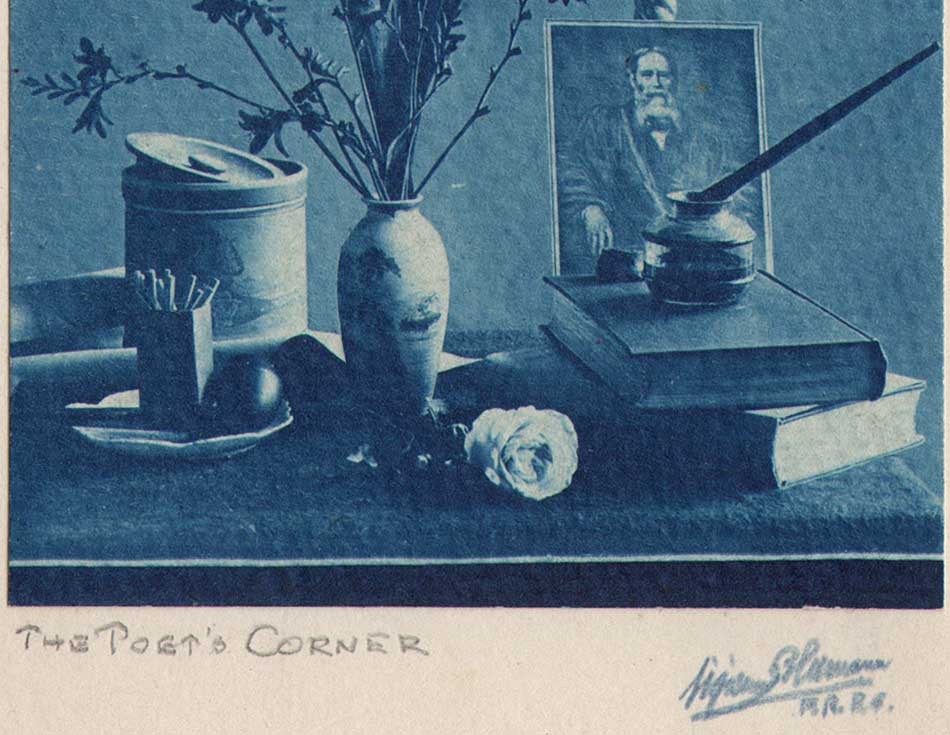 Detail: "The Poet's Corner" or "The Quiet Corner": Sigismund Blumann, American: 1933 or later: toned pigment print: 10.6 x 7.5 | 16.9 x 11.6 cm: The author's trusty pipe can be seen at left in this still-life table top study reproduced as the frontis halftone illustration for the August, 1927 issue of Camera Craft. From: PhotoSeed Archive
Detail: "The Poet's Corner" or "The Quiet Corner": Sigismund Blumann, American: 1933 or later: toned pigment print: 10.6 x 7.5 | 16.9 x 11.6 cm: The author's trusty pipe can be seen at left in this still-life table top study reproduced as the frontis halftone illustration for the August, 1927 issue of Camera Craft. From: PhotoSeed Archive
NOTES:
1. see: Early Years in Photography: “Sigismund Blumann, California Editor and Photographer”, by Christian A. Peterson in History of Photography, vol. 26, no. 1. (Spring 2002) p. 59.
2. Ibid: in: Photo Art Monthly, 1933-40: p. 73
3. It would not be until July, 1934, in an updated version of this 1925 Camera Craft article on describing the process of turning photographs into dry point etchings in Photo-Art Monthly, that evidence of Fitzpatrick and Blumann being the same person would seem to be confirmed. In it, the illustrated example of Blumann’s credited photograph titled “Land’s End” is also shown reproduced into the converted dry point etching with credit given to Fitzpatrick. Editorially, it might seem odd to continue this pen-name fiction with Blumann even going to lengths to construct a suspect history in 1925 of “Fitzpatrick’s” own beginnings although the reason was most likely intended as another way of imparting education on a topic deemed worthy and educational enough in the eyes and mind of the editor himself.
4. Copies of at least 43 documentary photographs, with several corresponding paper negative envelopes dated 1901 by Sigismund Bluman, were donated by his family to the California Historical Society where they can be viewed as part of the collection “The Chinese in California: 1850-1925.” The following link includes a smaller sampling of later printed examples, (some hand-colored) along with a rare surviving example titled “Ruin” (a detail included with this post) from 1906 of earthquake damage taken by the photographer as well as several portraits of Sig taken by others.
5. see: citation #1: p. 54.
6. excerpt: introduction: Making Photographs Into Dry Point Etchings: by Charles H. Fitzpatrick Illustrated by the Author: in: Camera Craft: October, 1925: San Francisco: p. 485.
7. see: citation #1 p. 54
8. Ibid: introduction: p. 53
9. American Prohibition was a nationwide constitutional ban on the sale, production, importation, and transportation of alcoholic beverages.
10. see: citation #1 p. 65
11. In order to make one of these etchings, the article instructs that after first selecting a printed photograph with little detail, the next step is to: “draw as much as he can on the photograph, using Higgins’ Water Proof India Ink. When this is absolutely dry the silver is completely bleached out with Bichloride of Mercury or Iodine-Iodide bleachers. The pen shading and finishing is then done with care, when the bleached and washed print has been dried.” From here, the article states a copy negative must then be made which is used to make the final second-generation finished (and reduced for effect) “etchings” using various grades of photographic paper: “The method of reproducing drawings is very simple. Place drawing on wall or easel and camera on firm support exactly centering lens on drawing, making exposure on a slow copy plate by diffused daylight or electric light, and develop for contrast. In copying it is advisable to reduce the image one-third smaller than the original as a finer line is thus secured which improves the finished print. The writer prefers a buff stock, matt paper of medium grade and heavy; and has found Vitava E just right: This is a matter of choice, however, as good prints may be secured on Azo, Velox, Cyco, Kruxo, Defender, Haloid, Barston, Charcoal Black or other matt papers. Proceed as in ordinary photographic printing then tone by re-development, using whatever process you prefer. I use Royal-Re-developer with pleasing results.” In the later 1934 article: “Etchings From and With Photographs”, “Fitzpatrick”goes further in depth on this etching process, adding that after the second-generation reduced copy print is made, the print could be “treated through all the usual solutions in the usual way and may be developed in any of the prescribed formulae for blue-black, jet-black, warm-black, or dark brown tones. Or it may be subsequently toned by the bleach and redevelop methods. The particular brown of an etching is easily gotten on Vitava Athena with a developer containing Athenon. Azo P-2 or 3, Vitava Athena E, Novira in the matt smooth or rough are all fine for the purpose. Gevalux gives a wonderful image in a true carbon black color and velvet crayon patine.” Continuing, the article offers a summary of the entire process: “That is all there is to the whole thing. You could not complicate it if you tried. Just make an enlargement, work on it with pen and ink, bleach out the silver leaving the ink image, photograph the line drawing, make as many etching-prints from the copy negative as you wish. Where can you go wrong? How can you fail?” He concludes by saying the maker of these etchings could also go “one step further by using hand-sensitized photographic papers for this final second-generation completed “etching”: “Furthermore, should you desire to print on colored papers or card- board of such surface as cannot be bought ready sensitized it will be a simple matter to sensitize any stock with the well known Blue Print solutions, or if the various shades of brown and black are wanted to resort to Kallitype. These processes are as cheap as they are easy to compound and use; they work on any paper not too saturated with chlorides or unfixed dyes. Kallitype is moreover a beautiful process in itself and prints endure according to the care in making them.”
March of Trade's Harmonious Shades
Posted November 2012 in Advertising, History of Photography, Journals, Publishing
The Photographic Times (1871-1915) was one of America’s earliest and most important photographic journals. By 1880, its publisher declared it the highest circulating magazine of its type in the country and by December of 1893, the first edition was stated to be 5,000 copies a week, an extraordinary number considering the inclusion by that time of a hand-pulled photogravure or collotype frontis plate. As a researcher, it would be presumptuous of me to think it possible in the modern day to present a fully-formed history of this publication without more direct corroboration from those who made that history. But since those folks are all dead, someone had to take a stab at it.
 1871-1873: The Photographic Times was first published by The Scovill Manufacturing Company, which maintained offices in this building at 36 Park Row and 4 Beekman streets in lower Manhattan. Completed in 1857 and known as the Potter or World Building, it was the home of the New York World newspaper offices and many other publications. (an adjoining building for The New York Times is at far left of frame) The sign for the Scovill Manufacturing Co. has been highlighted in red for clarity on the Park Row side. Since rebuilt, this building and block was destroyed by a massive fire on January 31, 1882 that claimed 12 lives. This detail from a circa 1870 stereoscopic view in the collection of the New York Public Library: Image ID: G91F211_034F
1871-1873: The Photographic Times was first published by The Scovill Manufacturing Company, which maintained offices in this building at 36 Park Row and 4 Beekman streets in lower Manhattan. Completed in 1857 and known as the Potter or World Building, it was the home of the New York World newspaper offices and many other publications. (an adjoining building for The New York Times is at far left of frame) The sign for the Scovill Manufacturing Co. has been highlighted in red for clarity on the Park Row side. Since rebuilt, this building and block was destroyed by a massive fire on January 31, 1882 that claimed 12 lives. This detail from a circa 1870 stereoscopic view in the collection of the New York Public Library: Image ID: G91F211_034F
Besides the written record, the important legacy left by the journal in my estimation are its hand-pulled photogravure plates which appeared regularly from 1889-1904, the latter being included in the combined but short-lived publication The Photographic Times-Bulletin. As a collector of this material for many years, it is surprising to me how little seems to have survived given the large circulation of the Times. My overview of the publication, which appears here in PhotoSeed Highlights, might very well put you to sleep due to length, or perhaps not. In tracing the history of this journal, my journey of discovery made me realize a fact of interest to all photographers, especially with respect to the United States: the first publisher of the Times, the Scovill Manufacturing Company of New York City, with a large factory complex in Waterbury, CT, was largely responsible for the birth and progress of photographic commerce in 19th century America.
 1871-1915 timeline: The Scovill company, publishers of The Photographic Times, did business at 9 different locations in New York City over 45 years. This Google street map with inset address key covers a walking distance today of approximately 4.6 miles. Arranged chronologically from A-I, the dates and addresses for the company are as follows: 1871-1873: 4 Beekman Street 1874-1884: 419-421 Broome Street 1884-1895: 423 Broome Street 1896-1900: 60-62 East 11th Street 1900 (Fall)-1902: 3-5 West 19th Street April 1902-1903: 122-124 Fifth Ave. 1904: 75-77 Eighth Ave. December, 1904-1908: 39 Union Square West 1909-1915: 135 West 14th Street
1871-1915 timeline: The Scovill company, publishers of The Photographic Times, did business at 9 different locations in New York City over 45 years. This Google street map with inset address key covers a walking distance today of approximately 4.6 miles. Arranged chronologically from A-I, the dates and addresses for the company are as follows: 1871-1873: 4 Beekman Street 1874-1884: 419-421 Broome Street 1884-1895: 423 Broome Street 1896-1900: 60-62 East 11th Street 1900 (Fall)-1902: 3-5 West 19th Street April 1902-1903: 122-124 Fifth Ave. 1904: 75-77 Eighth Ave. December, 1904-1908: 39 Union Square West 1909-1915: 135 West 14th Street
The following visual timeline is my attempt to show off the look of the publication over the 45 years it existed under its own imprint along with the principal men involved in editing it- part of the Photographic Times Publishing Association, one of the many business interests of the parent company. During this time, Scovill’s march of trade on the island of Manhattan involved eight separate business moves over a walkable distance today of roughly 4.6 miles. To this end, part of the mission statement issued by the Time’s editors to its many readers- from post American Civil War beginnings in January, 1871 to its 1915 demise remained true over the life of the journal:
we shall intersperse here and there delicate half-tones and harmonious shades from sources of information which shall do you good service in your manipulations, and add to your store of useful knowledge. We have engaged talent for this end, which is competent and able to instruct.
-David Spencer November, 2012
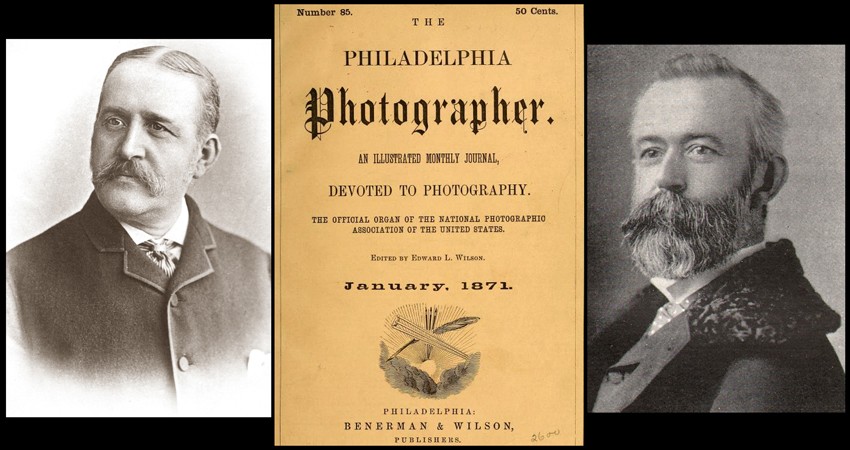 1870: The Times first appeared as a supplement incorporated within the pages of the monthly Philadelphia Photographer, center, one of the first journals devoted to photography published in America beginning in 1864. Washington Irving Adams, left, (1832-1896) came up with the idea for the Times during a working lunch attended in 1869 by men associated with the Scovill Manufacturing Company. Edward Wilson, right, (1838-1903) was the founder, editor and publisher of the Philadelphia Photographer, as well as good friend to Adams. Photo credits: portraits: PhotoSeed Archive; magazine cover: HathiTrust
1870: The Times first appeared as a supplement incorporated within the pages of the monthly Philadelphia Photographer, center, one of the first journals devoted to photography published in America beginning in 1864. Washington Irving Adams, left, (1832-1896) came up with the idea for the Times during a working lunch attended in 1869 by men associated with the Scovill Manufacturing Company. Edward Wilson, right, (1838-1903) was the founder, editor and publisher of the Philadelphia Photographer, as well as good friend to Adams. Photo credits: portraits: PhotoSeed Archive; magazine cover: HathiTrust
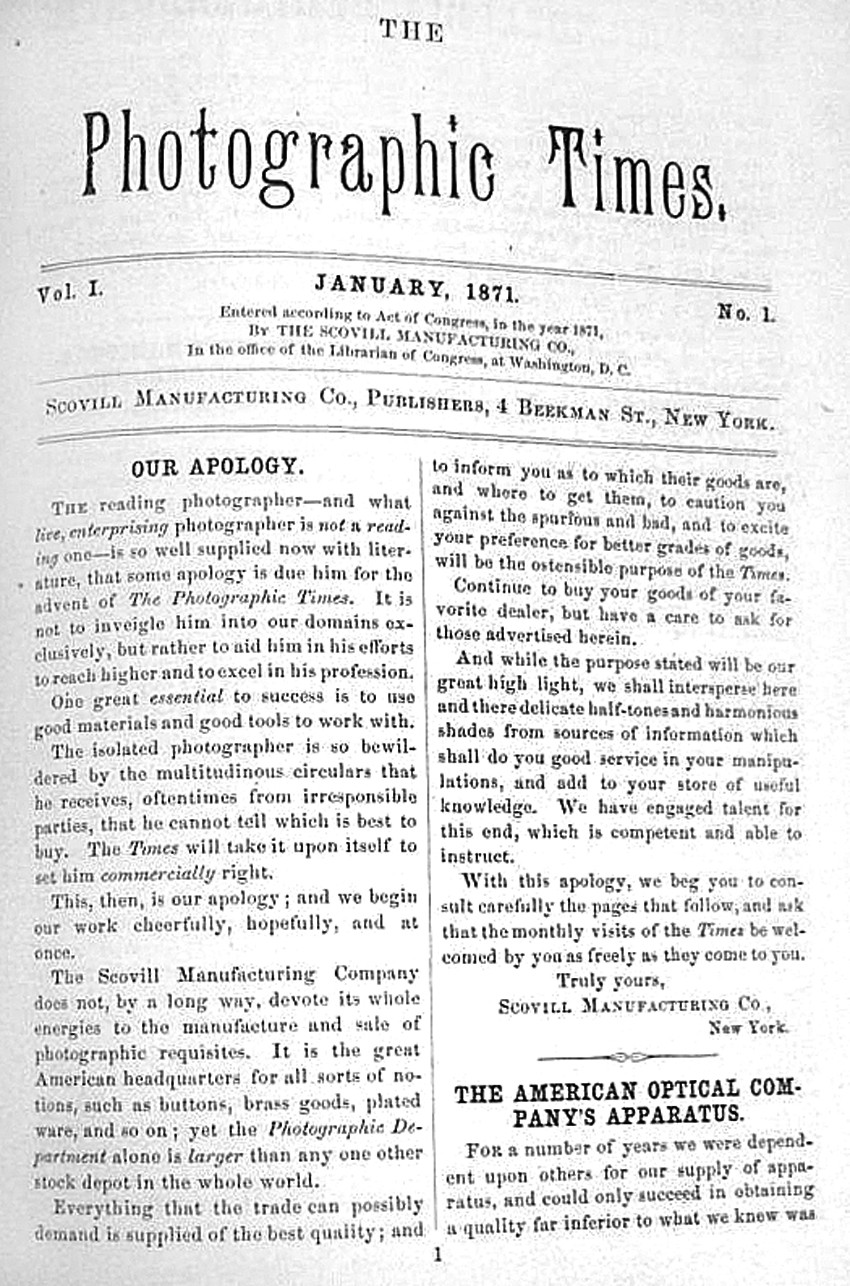 1871: The Photographic Times appeared for the first time under the imprint of the Scovill Manufacturing Company of 4 Beekman street in New York City beginning with the January, 1871 issue. The first page of the eight-page trade monthly included an "Apology", intended to "set the photographer commercially right.” It was sent out free of charge with Wilson's Philadelphia Photographer, The Photographic World, and Walzl’s Photographic Magazine, along with an additional 500 copies mailed each month from Scovill's New York offices. Photo credit: D. Richards, Bookman: Pittsburgh, PA
1871: The Photographic Times appeared for the first time under the imprint of the Scovill Manufacturing Company of 4 Beekman street in New York City beginning with the January, 1871 issue. The first page of the eight-page trade monthly included an "Apology", intended to "set the photographer commercially right.” It was sent out free of charge with Wilson's Philadelphia Photographer, The Photographic World, and Walzl’s Photographic Magazine, along with an additional 500 copies mailed each month from Scovill's New York offices. Photo credit: D. Richards, Bookman: Pittsburgh, PA
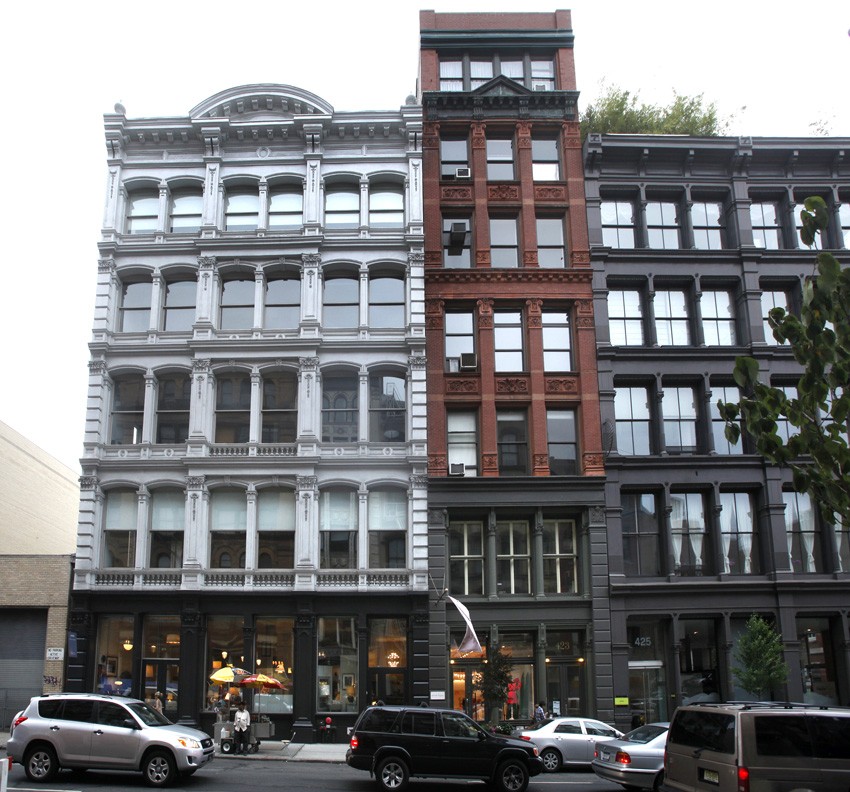 1874 | 1884: Because of "want of room and the march of trade", the Scovill company had moved to new quarters at 419-421 Broome street by January, 1874. Located in SoHo, the building as it stands today can be seen at left in a photograph taken in June, 2012. By May of 1884, another move for the Times and the Scovill company took place right next door: the building at center with the address of 423 Broome Street, built for the company by architectural firm D. & J. Jardine. Described as a warehouse building at the time, Times editor Washington Irving Adams commented on its many benefits: "This well appointed structure, embracing seven floors and a double basement, we have erected to meet the special requirements of our business. The building, with its improved interior arrangements, will greatly enlarge our facilities and enable us to respond to the wants of our patrons in a more expeditious and satisfactory manner than heretofore. For the accommodation of our friends, a well-constructed dark-room and sky-light have been added to the many other conveniences introduced, all of which will subserve in various ways the interests of our customers." PhotoSeed Archive photograph by David Spencer
1874 | 1884: Because of "want of room and the march of trade", the Scovill company had moved to new quarters at 419-421 Broome street by January, 1874. Located in SoHo, the building as it stands today can be seen at left in a photograph taken in June, 2012. By May of 1884, another move for the Times and the Scovill company took place right next door: the building at center with the address of 423 Broome Street, built for the company by architectural firm D. & J. Jardine. Described as a warehouse building at the time, Times editor Washington Irving Adams commented on its many benefits: "This well appointed structure, embracing seven floors and a double basement, we have erected to meet the special requirements of our business. The building, with its improved interior arrangements, will greatly enlarge our facilities and enable us to respond to the wants of our patrons in a more expeditious and satisfactory manner than heretofore. For the accommodation of our friends, a well-constructed dark-room and sky-light have been added to the many other conveniences introduced, all of which will subserve in various ways the interests of our customers." PhotoSeed Archive photograph by David Spencer
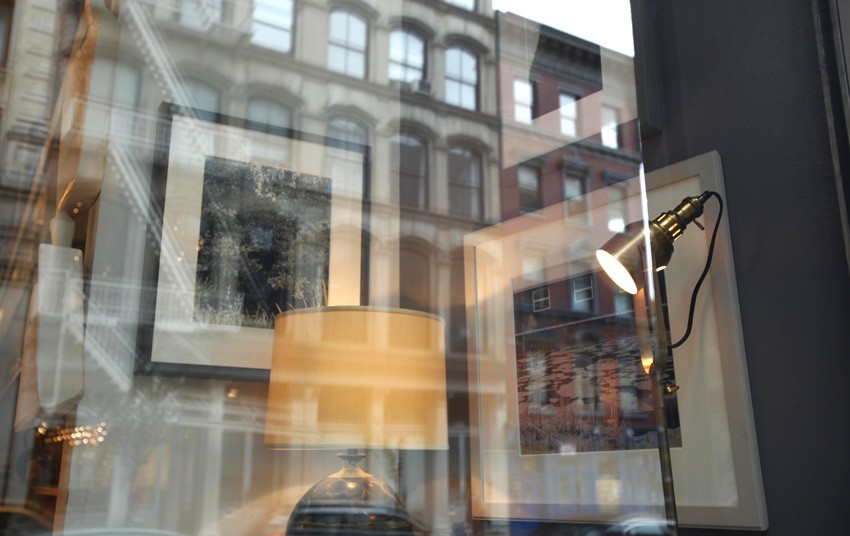 2012: Serendipity, coincidence or both? A modern day investigator peering through the front window of 419 Broome street is startled to learn the fine art of photography is alive and well nearly 140 years after this space occupied one of the leading mouthpieces of the photographic press. In the business space Aero LTD, a home furnishing store, professional photographer Michelle Arcila's work is framed and ready for sale. Her photographs "Present Tense" at left and "Olympia" share the reflected outside world of Broome street. PhotoSeed Archive photograph by David Spencer
2012: Serendipity, coincidence or both? A modern day investigator peering through the front window of 419 Broome street is startled to learn the fine art of photography is alive and well nearly 140 years after this space occupied one of the leading mouthpieces of the photographic press. In the business space Aero LTD, a home furnishing store, professional photographer Michelle Arcila's work is framed and ready for sale. Her photographs "Present Tense" at left and "Olympia" share the reflected outside world of Broome street. PhotoSeed Archive photograph by David Spencer
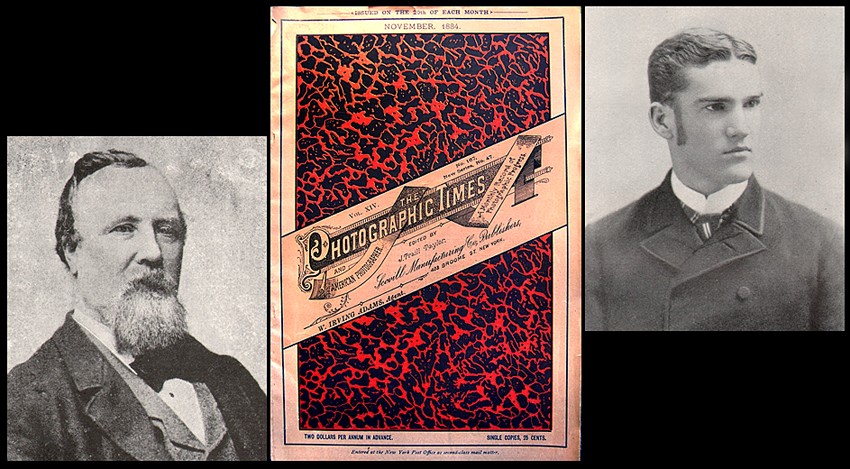 1881 | 1884 | 1885: Beginning in 1881, a new editorial direction was brought to the Times, renamed The Photographic Times and American Photographer, by Englishman John Traill Taylor, (1827-1895) left. A veteran of the British Journal of Photography, he was eventually succeeded as editor by Washington Irving Lincoln Adams, (1865-1946) right, son of the journal's founder, joining the editorial staff in 1885. At center is a rare surviving example of a Times cover from November, 1884. Photo credits: portraits: PhotoSeed Archive; magazine cover: Ebay
1881 | 1884 | 1885: Beginning in 1881, a new editorial direction was brought to the Times, renamed The Photographic Times and American Photographer, by Englishman John Traill Taylor, (1827-1895) left. A veteran of the British Journal of Photography, he was eventually succeeded as editor by Washington Irving Lincoln Adams, (1865-1946) right, son of the journal's founder, joining the editorial staff in 1885. At center is a rare surviving example of a Times cover from November, 1884. Photo credits: portraits: PhotoSeed Archive; magazine cover: Ebay
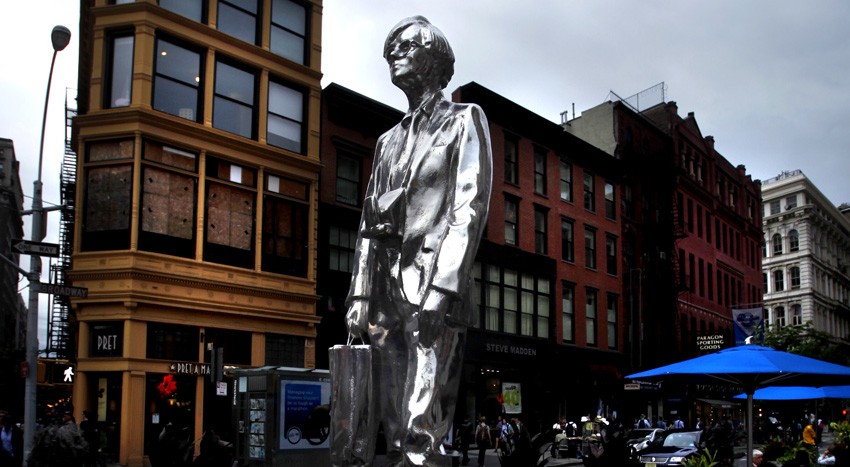 2012: Besides being the king of Pop art, Andy Warhol (1928-1987) was also a passionate photographer, going everywhere with his Polaroid camera-seen here around his neck in the famous (since removed) chrome-plated "Andy Monument" by sculptor Rob Pruitt in Union Square. A parallel or association with the Photographic Times? You bet. Albeit sixty years later, Warhol’s second "Silver Factory" was established in 1968 and located around the corner from the statue at 33 Union Square West, just three doors down from 39 Union Square, one of the last home offices for the Times from 1904-1908. PhotoSeed Archive photograph (June) by David Spencer
2012: Besides being the king of Pop art, Andy Warhol (1928-1987) was also a passionate photographer, going everywhere with his Polaroid camera-seen here around his neck in the famous (since removed) chrome-plated "Andy Monument" by sculptor Rob Pruitt in Union Square. A parallel or association with the Photographic Times? You bet. Albeit sixty years later, Warhol’s second "Silver Factory" was established in 1968 and located around the corner from the statue at 33 Union Square West, just three doors down from 39 Union Square, one of the last home offices for the Times from 1904-1908. PhotoSeed Archive photograph (June) by David Spencer
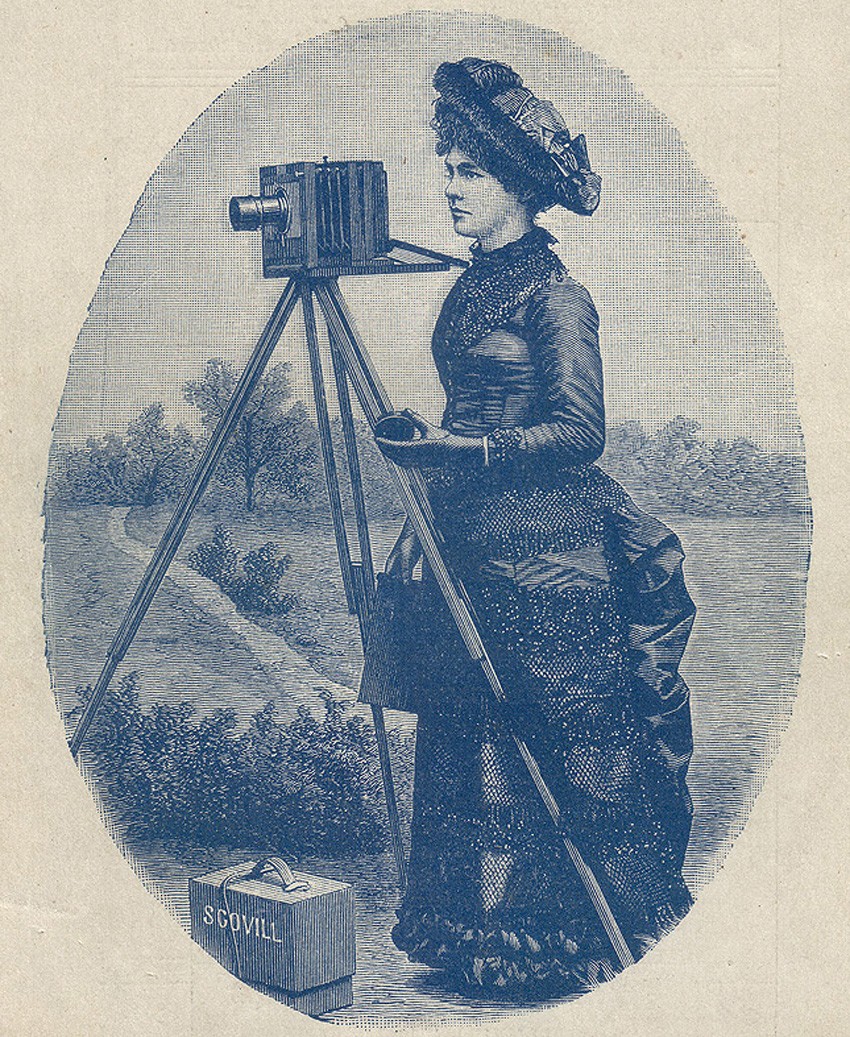 1883: With modern dry gelatin photographic plates replacing the cumbersome wet plate (collodion) process around 1881, the Scovill company through their publications including the Photographic Times began marketing in earnest complete and affordable amateur outfits to the masses. This fashionably dressed lady amateur, appearing as early as 1883 as a wood engraving in Scovill's catalogue: "How to Make Photographs", advertised their "Amateur Photographic Requisites". For the grand sum of $10.00, a photographer could obtain "Favorite Outfit A": an adjustable 4 x 5 Scovill plate camera, "Waterbury" achromatic nickel plated lens, a Taylor folding tripod, a double dry plate holder for the camera and carrying case. After becoming the Scovill & Adams company in 1889, the firm developed other popular mass market cameras including the Henry Clay and Solograph models as well as many others. 1889 engraving from Scovill catalogue courtesy of Larry Pierce.
1883: With modern dry gelatin photographic plates replacing the cumbersome wet plate (collodion) process around 1881, the Scovill company through their publications including the Photographic Times began marketing in earnest complete and affordable amateur outfits to the masses. This fashionably dressed lady amateur, appearing as early as 1883 as a wood engraving in Scovill's catalogue: "How to Make Photographs", advertised their "Amateur Photographic Requisites". For the grand sum of $10.00, a photographer could obtain "Favorite Outfit A": an adjustable 4 x 5 Scovill plate camera, "Waterbury" achromatic nickel plated lens, a Taylor folding tripod, a double dry plate holder for the camera and carrying case. After becoming the Scovill & Adams company in 1889, the firm developed other popular mass market cameras including the Henry Clay and Solograph models as well as many others. 1889 engraving from Scovill catalogue courtesy of Larry Pierce.
 1886: Dr. Charles Ehrmann, (1822-1894) a pharmaceutical chemist by training at the University of Berlin, joined the Photographic Times as an assistant editor under John Traill Taylor beginning in 1881. His obituary penned by Frederick Beach in the American Amateur Photographer said he became the "guiding editorial spirit" for the Times after Taylor's retirement in 1886, even under Lincoln Adams, and was the journal's "chief experimentalist- investigating and writing in the pages of the Times the myriad processes then used in traditional wet darkroom photography. In the Fall of 1886, Ehrmann was named instructor in the newly established Chautauqua University School of Photography, chiefly a correspondence school, but also one where he gave hands-on instruction in photography with diplomas awarded from the summer home in upstate New York as well as the Broome street offices of the Times. This photograph of Ehrmann appeared as a full-page plate in the May 25, 1888 issue of the Times. Photo credit: HathiTrust
1886: Dr. Charles Ehrmann, (1822-1894) a pharmaceutical chemist by training at the University of Berlin, joined the Photographic Times as an assistant editor under John Traill Taylor beginning in 1881. His obituary penned by Frederick Beach in the American Amateur Photographer said he became the "guiding editorial spirit" for the Times after Taylor's retirement in 1886, even under Lincoln Adams, and was the journal's "chief experimentalist- investigating and writing in the pages of the Times the myriad processes then used in traditional wet darkroom photography. In the Fall of 1886, Ehrmann was named instructor in the newly established Chautauqua University School of Photography, chiefly a correspondence school, but also one where he gave hands-on instruction in photography with diplomas awarded from the summer home in upstate New York as well as the Broome street offices of the Times. This photograph of Ehrmann appeared as a full-page plate in the May 25, 1888 issue of the Times. Photo credit: HathiTrust
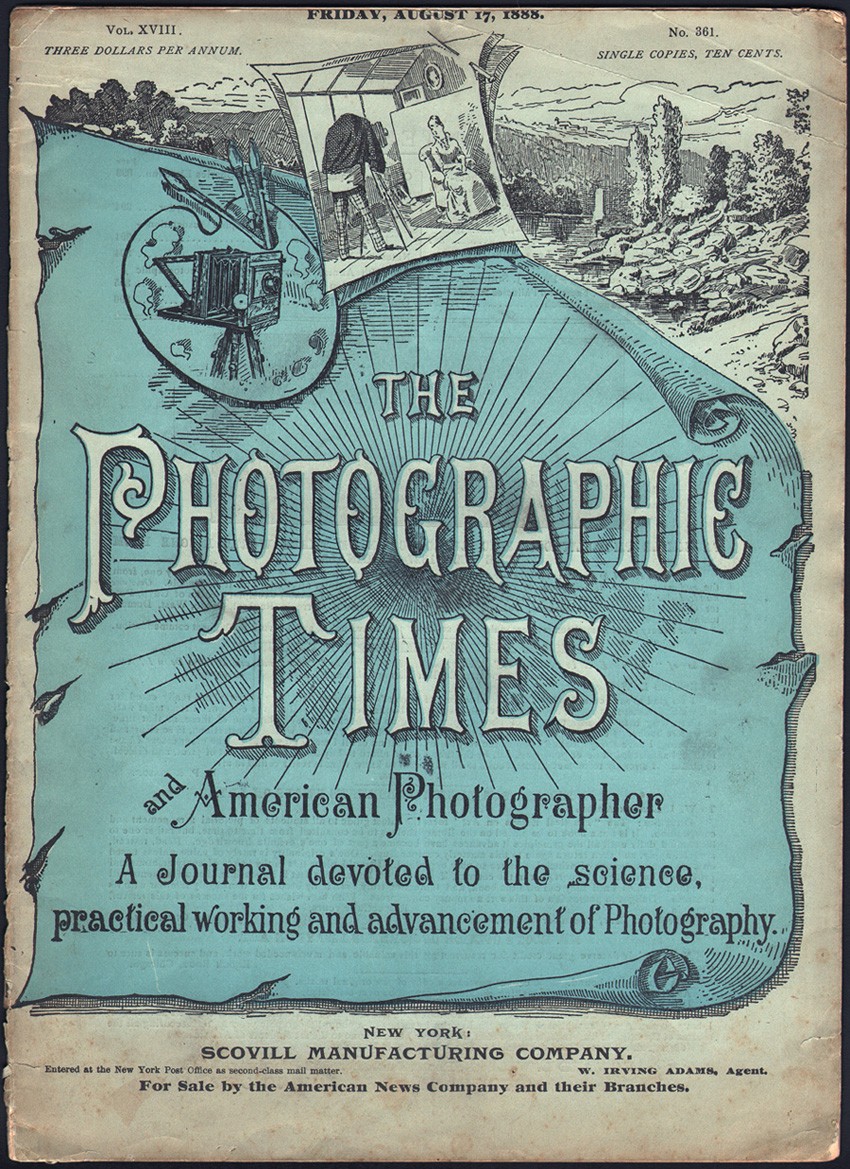 1887-1888: This is an example of a cover from The Photographic Times and American Photographer dated Friday, August 17, 1888. This was the same design used for the journal in 1887. (unknown if it was used before 1887) The quarto format journal was printed in blue and black with the artwork possibly being by the hand of Brooklyn artist William Mozart. From: PhotoSeed Archive
1887-1888: This is an example of a cover from The Photographic Times and American Photographer dated Friday, August 17, 1888. This was the same design used for the journal in 1887. (unknown if it was used before 1887) The quarto format journal was printed in blue and black with the artwork possibly being by the hand of Brooklyn artist William Mozart. From: PhotoSeed Archive
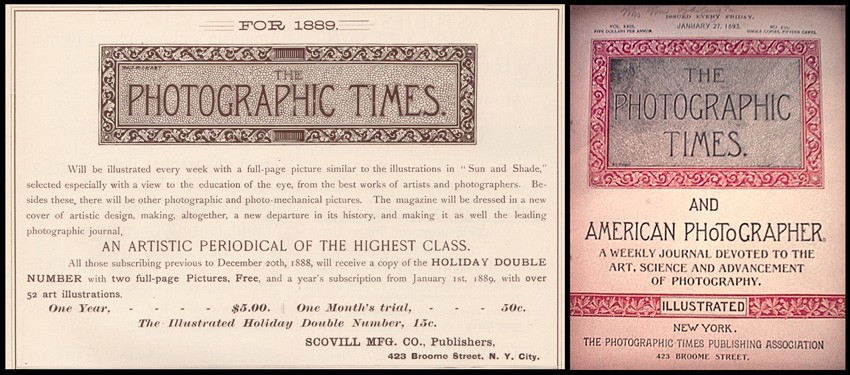 1889: This year brought a complete redesign to the look of the Times. Brooklyn artist and photographer William J. Mozart, (b. 1855) who had honed his skill first as a scene painter at a Boston museum beginning in 1878 came up with the logo seen here at left, incorporated within a January, 1889 advertisement for the Times in the periodical Sun and Shade. "The magazine will be dressed in a new cover of artistic design, making, altogether, a new departure in its history, and making it as well the leading photographic journal." The weekly would also for the first time feature in every issue a full-page illustration, typically a photogravure or fine process collotype. At right is an example of the new cover by Mozart. (this issue from January, 1893). Advertisement from PhotoSeed Archive; cover: Crown Antiques & Collectible
1889: This year brought a complete redesign to the look of the Times. Brooklyn artist and photographer William J. Mozart, (b. 1855) who had honed his skill first as a scene painter at a Boston museum beginning in 1878 came up with the logo seen here at left, incorporated within a January, 1889 advertisement for the Times in the periodical Sun and Shade. "The magazine will be dressed in a new cover of artistic design, making, altogether, a new departure in its history, and making it as well the leading photographic journal." The weekly would also for the first time feature in every issue a full-page illustration, typically a photogravure or fine process collotype. At right is an example of the new cover by Mozart. (this issue from January, 1893). Advertisement from PhotoSeed Archive; cover: Crown Antiques & Collectible
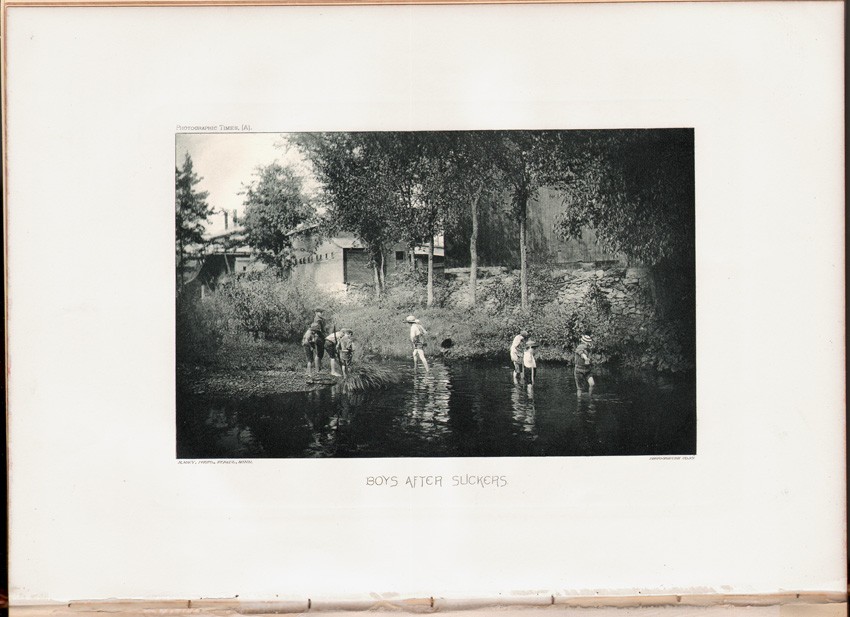 1889: "Boys after Suckers" by Minnesota photographer Rev. Herbert Macy, was the photogravure frontis plate for the April 18, 1890 weekly issue of the Times. Image: 11.2 x 17.9 cm | Support: 20.5 x 28.7 cm Photogravures such as these were a major selling point for potential subscribers, with the cost of a yearly subscription being $5.00. In 1893, the editors wrote: "The PHOTOGRAPHIC TIMES had frequently brought out full-page pictorial illustrations, in addition to the cuts and diagrams which always brightened its reading columns; but beginning with 1889, it presented its readers regularly, each week, with a full-page pictorial frontispiece, reproduced by photogravure or other high grade process, and including an occasional photographic print on albumen or other sensitive paper. It thus became the first and continues to be the only photographic weekly publication in the world, containing a full-page picture with every issue." Photo: PhotoSeed Archive
1889: "Boys after Suckers" by Minnesota photographer Rev. Herbert Macy, was the photogravure frontis plate for the April 18, 1890 weekly issue of the Times. Image: 11.2 x 17.9 cm | Support: 20.5 x 28.7 cm Photogravures such as these were a major selling point for potential subscribers, with the cost of a yearly subscription being $5.00. In 1893, the editors wrote: "The PHOTOGRAPHIC TIMES had frequently brought out full-page pictorial illustrations, in addition to the cuts and diagrams which always brightened its reading columns; but beginning with 1889, it presented its readers regularly, each week, with a full-page pictorial frontispiece, reproduced by photogravure or other high grade process, and including an occasional photographic print on albumen or other sensitive paper. It thus became the first and continues to be the only photographic weekly publication in the world, containing a full-page picture with every issue." Photo: PhotoSeed Archive
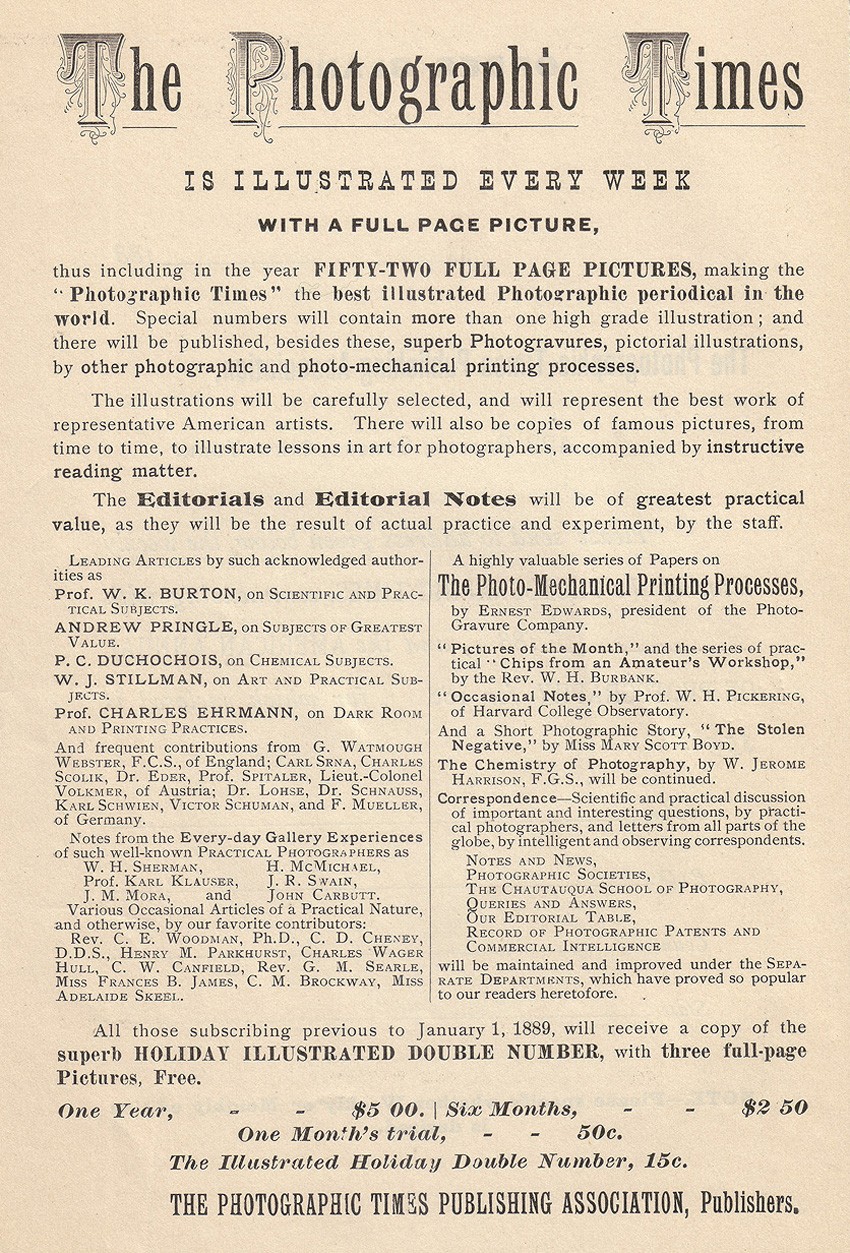 1889: With its new emphasis on high-grade illustrations that would be reproduced each week, other particulars and selling points, including the following quote, appeared in the 1889 Scovill & Adams company trade brochure "How to Make Photographs" : "The Editorials and Editorial Notes will be of greatest practical value, as they will be the result of actual practice and experiment, by the staff." Advertisement courtesy of Larry Pierce.
1889: With its new emphasis on high-grade illustrations that would be reproduced each week, other particulars and selling points, including the following quote, appeared in the 1889 Scovill & Adams company trade brochure "How to Make Photographs" : "The Editorials and Editorial Notes will be of greatest practical value, as they will be the result of actual practice and experiment, by the staff." Advertisement courtesy of Larry Pierce.
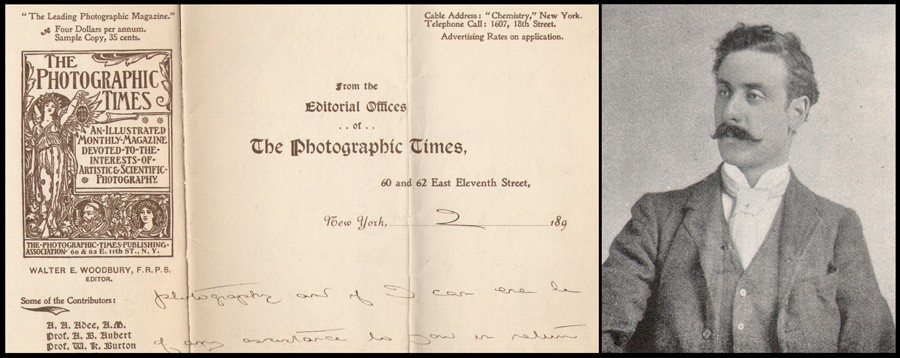 1893: In the Spring of this year, Walter Edward Woodbury, (1865-1905) seen at right around this time, joined the editorial staff of the Times, and before the end of 1894 was appointed editor by Lincoln Adams. A Fellow of the Royal Photographic Society and son of Englishman Walter Bentley Woodbury, (1834-1885) he oversaw major changes to the Times, including its transformation to a monthly and into a “high-class art magazine”. Perhaps the most noticeable change of this last aspect for a subscriber was the dramatic new cover design featuring Roman goddess Veritas holding out her lamp symbolically lighting the way for truth, designed by English bookplate artist George Richard Quested. The design was even incorporated into Woodbury's personalized Times letterhead, a detail of which can be seen here. Letterhead and portrait: PhotoSeed Archive
1893: In the Spring of this year, Walter Edward Woodbury, (1865-1905) seen at right around this time, joined the editorial staff of the Times, and before the end of 1894 was appointed editor by Lincoln Adams. A Fellow of the Royal Photographic Society and son of Englishman Walter Bentley Woodbury, (1834-1885) he oversaw major changes to the Times, including its transformation to a monthly and into a “high-class art magazine”. Perhaps the most noticeable change of this last aspect for a subscriber was the dramatic new cover design featuring Roman goddess Veritas holding out her lamp symbolically lighting the way for truth, designed by English bookplate artist George Richard Quested. The design was even incorporated into Woodbury's personalized Times letterhead, a detail of which can be seen here. Letterhead and portrait: PhotoSeed Archive
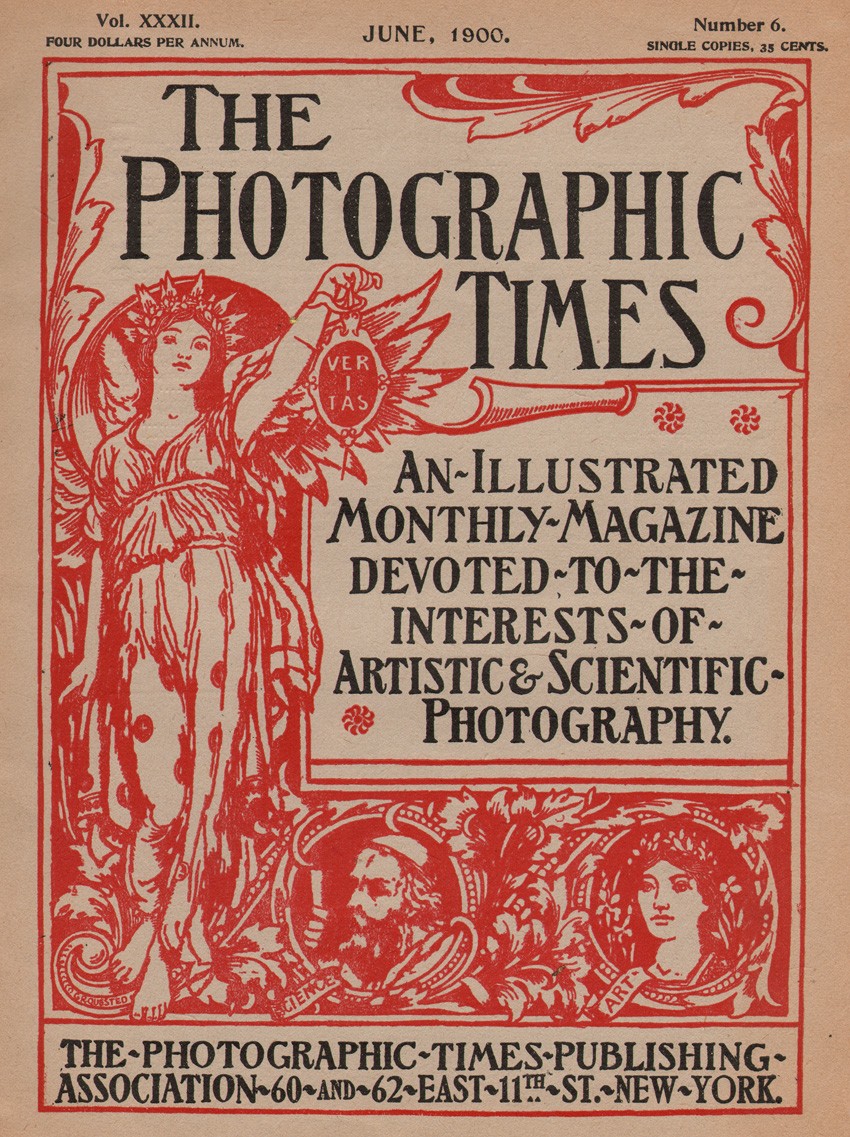 1895: The Veritas cover by Quested first used beginning in 1895 lasted through 1901, albeit in a smaller format that year. Printed in bold red ink, his design additionally featured inset portrait medallions of Science, represented by a bearded gentleman, and Art, by a fair maiden crowned by laurels. The previous weekly cover had stated: "A weekly journal devoted to the art, science and advancement of Photography" and the new monthly stated: "An illustrated monthly magazine devoted to the interests of Artistic & Scientific Photography." Sizes for cover- 1895-1900: (detail here eliminating part of borders) 29.3 x 22.5 cm; 1901: 25.0 x 17.5 cm. Cover, June, 1900: PhotoSeed Archive
1895: The Veritas cover by Quested first used beginning in 1895 lasted through 1901, albeit in a smaller format that year. Printed in bold red ink, his design additionally featured inset portrait medallions of Science, represented by a bearded gentleman, and Art, by a fair maiden crowned by laurels. The previous weekly cover had stated: "A weekly journal devoted to the art, science and advancement of Photography" and the new monthly stated: "An illustrated monthly magazine devoted to the interests of Artistic & Scientific Photography." Sizes for cover- 1895-1900: (detail here eliminating part of borders) 29.3 x 22.5 cm; 1901: 25.0 x 17.5 cm. Cover, June, 1900: PhotoSeed Archive
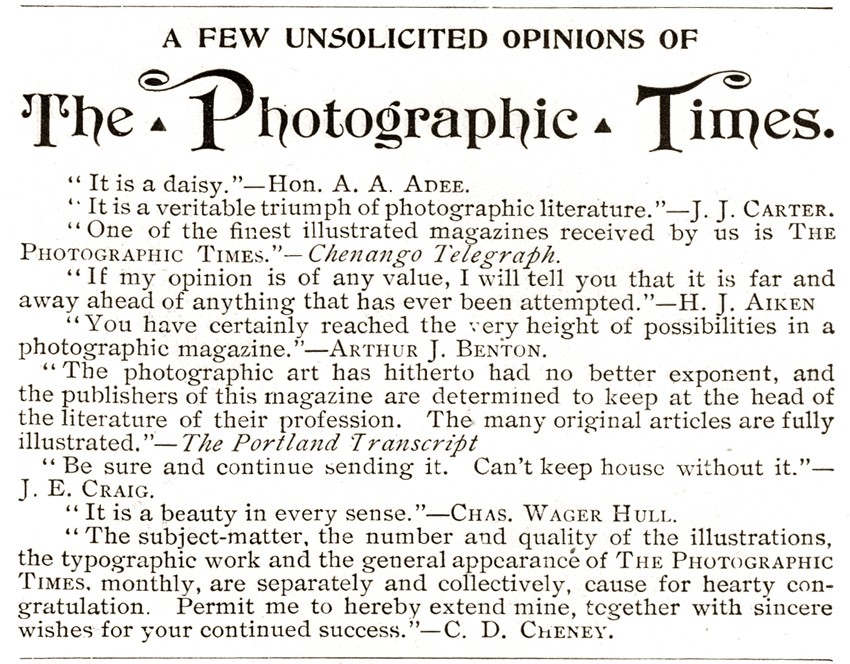 1896: Over-the-top reviews appeared frequently in various publications published by the Scovill & Adams firm in praise of the Times. One very widely-circulated volume for these praises was their annual published since 1887 titled “The American Annual of Photography and Photographic Times Almanac”, a compendium that had attained a circulation of over 20,000 copies by 1894. This advertisement of "unsolicited opinions" appeared in the advertising section of the 1896 annual. From: PhotoSeed Archive
1896: Over-the-top reviews appeared frequently in various publications published by the Scovill & Adams firm in praise of the Times. One very widely-circulated volume for these praises was their annual published since 1887 titled “The American Annual of Photography and Photographic Times Almanac”, a compendium that had attained a circulation of over 20,000 copies by 1894. This advertisement of "unsolicited opinions" appeared in the advertising section of the 1896 annual. From: PhotoSeed Archive
 1896 | 2012: As stated early in this post, the Scovill company, known since 1889 as Scovill & Adams, moved many times on the island of Manhattan. In 1896, they vacated their headquarters at 423 Broome street and took occupancy of a brand new, seven-story building specifically built for the company off of Broadway at 60 and 62 East Eleventh Street. Seen in this artist's drawing at left published in the January, 1896 issue of the Times, the editors said: "Our New Offices will be in the same building. The editorial rooms and offices will be situated on the main floor of the building. A very complete photographic and reference library will be conveniently arranged in the editorial rooms, and on the roof will be erected a finely fitted up dark-room and skylight gallery. These will be at the disposal of all our subscribers and friends." Scovill would stay in the building until the Fall of 1900. The building, housing the company Bijan Royal Inc. on the ground floor, can be seen today at right photographed in June, 2012. PhotoSeed Archive, left; right: photograph by David Spencer
1896 | 2012: As stated early in this post, the Scovill company, known since 1889 as Scovill & Adams, moved many times on the island of Manhattan. In 1896, they vacated their headquarters at 423 Broome street and took occupancy of a brand new, seven-story building specifically built for the company off of Broadway at 60 and 62 East Eleventh Street. Seen in this artist's drawing at left published in the January, 1896 issue of the Times, the editors said: "Our New Offices will be in the same building. The editorial rooms and offices will be situated on the main floor of the building. A very complete photographic and reference library will be conveniently arranged in the editorial rooms, and on the roof will be erected a finely fitted up dark-room and skylight gallery. These will be at the disposal of all our subscribers and friends." Scovill would stay in the building until the Fall of 1900. The building, housing the company Bijan Royal Inc. on the ground floor, can be seen today at right photographed in June, 2012. PhotoSeed Archive, left; right: photograph by David Spencer
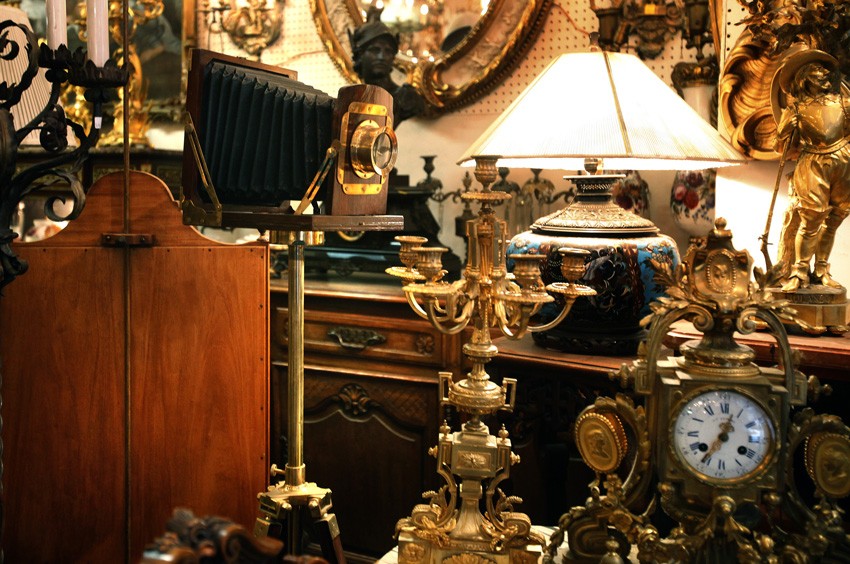 2012: More serendipity in the modern day or crazy fluke? A visit to the current first floor showroom space of antique dealer Bijan Royal at 60 East 11th street in June miraculously revealed on display this impressive looking, tripod-mounted plate camera. Quizzing a salesman produced no more details of its history however. Instead, he was keen on photo-copying the 1896 artist drawing of the building I showed him earlier while explaining my mission. Scovill & Adams in their day here made millions of dollars selling cameras like this one (even though it suspiciously appeared more ornamental than functional) as well as every conceivable photographic accessory known to man. For this space in its day formerly held one of the greatest photographic stock houses on the planet-with the Photographic Times offices in this space producing monthly the physical embodiment of the day's most important social media. PhotoSeed Archive photo by David Spencer
2012: More serendipity in the modern day or crazy fluke? A visit to the current first floor showroom space of antique dealer Bijan Royal at 60 East 11th street in June miraculously revealed on display this impressive looking, tripod-mounted plate camera. Quizzing a salesman produced no more details of its history however. Instead, he was keen on photo-copying the 1896 artist drawing of the building I showed him earlier while explaining my mission. Scovill & Adams in their day here made millions of dollars selling cameras like this one (even though it suspiciously appeared more ornamental than functional) as well as every conceivable photographic accessory known to man. For this space in its day formerly held one of the greatest photographic stock houses on the planet-with the Photographic Times offices in this space producing monthly the physical embodiment of the day's most important social media. PhotoSeed Archive photo by David Spencer
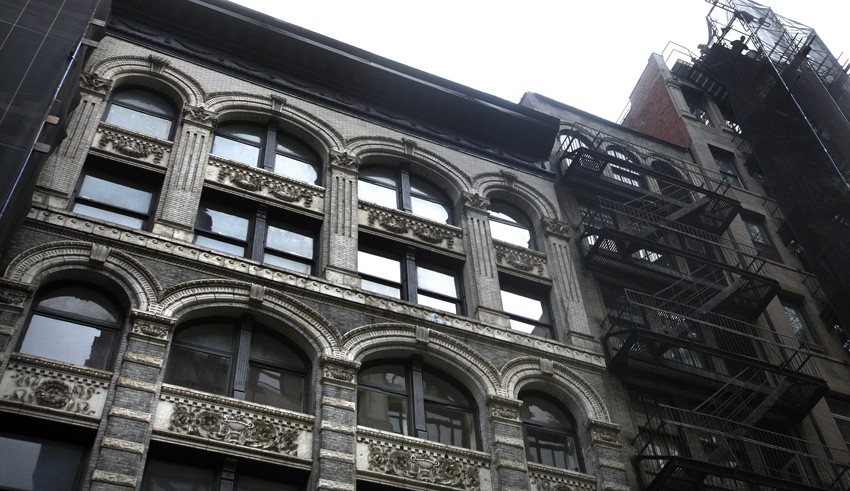 2012: A view of the facade showing the top floors of 60-62 East 11th. "The lofts will be reserved for the storage of original cases and other unpacked goods. A specially constructed dark-room for the use of their patrons and friends will be conveniently situated, and on the roof of the building there will be a commodious skylight, with light facing north, for experimental and testing purposes." During my visit, I tried my best to talk my way up to the top floor of the building to see if the skylight still existed, but to no avail. A quick search on the web indicates creative folks inhabit the seventh floor: music agency Crush Talent Management- so hooray for that. PhotoSeed Archive photo by David Spencer
2012: A view of the facade showing the top floors of 60-62 East 11th. "The lofts will be reserved for the storage of original cases and other unpacked goods. A specially constructed dark-room for the use of their patrons and friends will be conveniently situated, and on the roof of the building there will be a commodious skylight, with light facing north, for experimental and testing purposes." During my visit, I tried my best to talk my way up to the top floor of the building to see if the skylight still existed, but to no avail. A quick search on the web indicates creative folks inhabit the seventh floor: music agency Crush Talent Management- so hooray for that. PhotoSeed Archive photo by David Spencer
 1897: This extremely rare lithographic Photographic Times poster held and conserved by the Library of Congress in Washington D.C. was described in the April issue of the journal as follows: "We have had prepared for us a very attractive poster in seven colors. We give a half-tone reproduction of it herewith. Photographic dealers and newsagents will find this a valuable aid in obtaining subscriptions for this magazine. We will send one free on application and a promise that the same will be prominently displayed. The size of the poster is about 2x3 feet." Poster: Library of Congress
1897: This extremely rare lithographic Photographic Times poster held and conserved by the Library of Congress in Washington D.C. was described in the April issue of the journal as follows: "We have had prepared for us a very attractive poster in seven colors. We give a half-tone reproduction of it herewith. Photographic dealers and newsagents will find this a valuable aid in obtaining subscriptions for this magazine. We will send one free on application and a promise that the same will be prominently displayed. The size of the poster is about 2x3 feet." Poster: Library of Congress
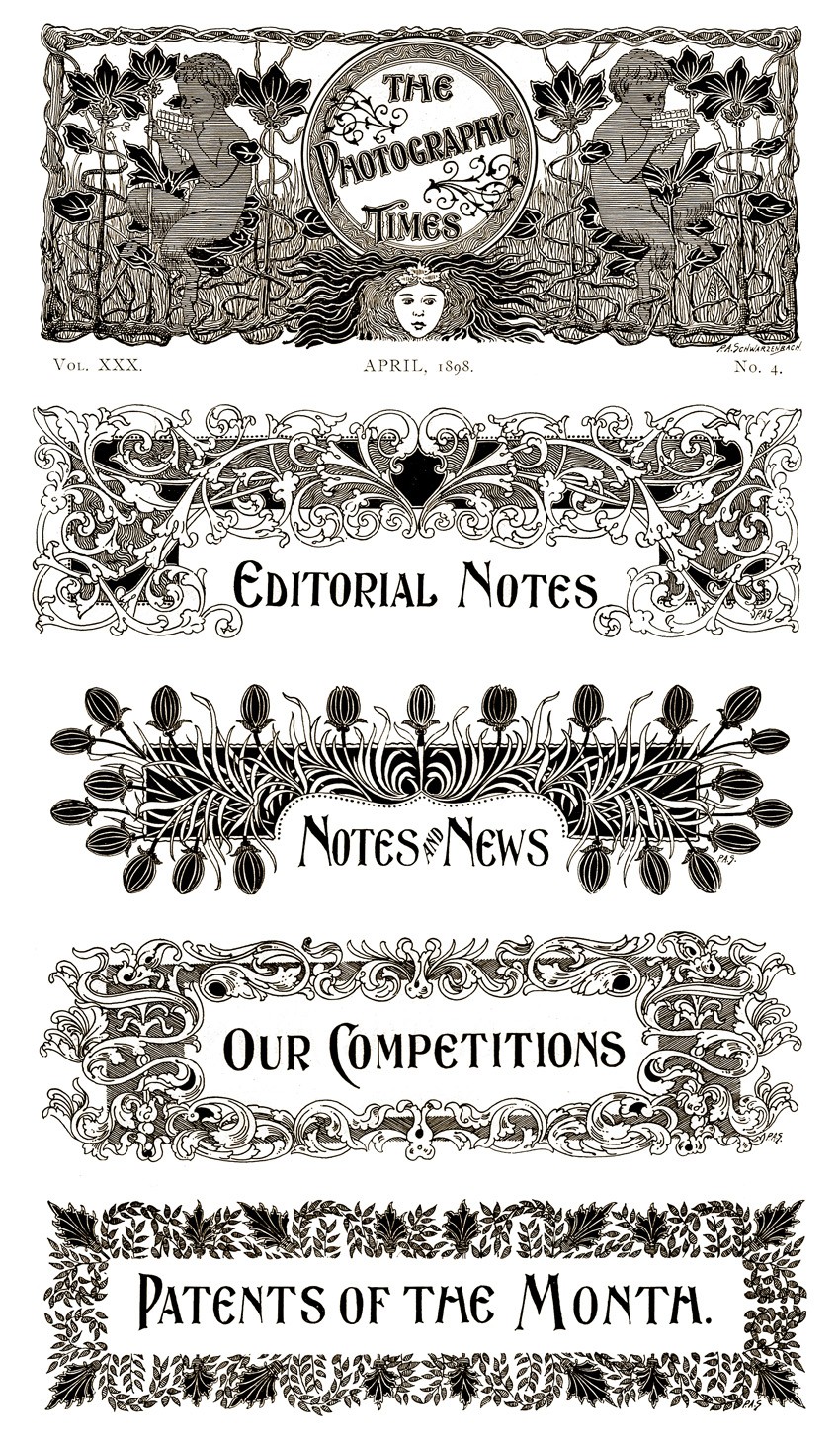 1898: In keeping with the spirit of the re-designed monthly after 1895- a "64-page artistic and scientific magazine of the very highest order" in the words of Times advertising copy from the period- illustrator P.A. Schwarzenbach supplied these decorative, Art-Nouveau inspired woodcut designs used to delineate the various departments within the editorial copy section of the journal. These specific floral designs were used during 1898 (and some before) and later into the new century. Additional Schwarzenbach designs appearing later included "Our Monthly Digest" and "The Editor's Table". Various designs, enhanced for clarity, with each approximately 6.5 x 15.5 cm ( +/-) from: PhotoSeed Archive
1898: In keeping with the spirit of the re-designed monthly after 1895- a "64-page artistic and scientific magazine of the very highest order" in the words of Times advertising copy from the period- illustrator P.A. Schwarzenbach supplied these decorative, Art-Nouveau inspired woodcut designs used to delineate the various departments within the editorial copy section of the journal. These specific floral designs were used during 1898 (and some before) and later into the new century. Additional Schwarzenbach designs appearing later included "Our Monthly Digest" and "The Editor's Table". Various designs, enhanced for clarity, with each approximately 6.5 x 15.5 cm ( +/-) from: PhotoSeed Archive
 1900: A few thoughts on Times editorial and advertising matter having to do with race. Going through old issues from the late 19th and early 20th century, I've run into that proverbial "elephant in the room" on more than one occasion: unflattering depictions of African-Americans, typically children. Through word and image, there is plenty of reason to believe this usage was not limited to mass-market American photographic journals but extended to many imprints of the era. One case in point seen here. Through modern eyes, a Times page designer going for the cheap laugh in representing monetary decision making and its potential outcomes for the amateur photographer for an article on the conundrum of photography being an affordable hobby used a series of vignettes of children stripped along the top and bottom of a page. These expressive "studies in black… and white" conveniently featured skin colors of the opposite hue for the January, 1896 article "It Costs Too Much". A mild example perhaps but one that made me wince when I first came across it. On the other hand, photographic depictions of African-Americans showing merit and historical importance do show up in the pages of the Times-even when done in the period genre style favored by American Rudolph Eickemeyer, Jr. At right, a fine example: a full-page halftone study of an elderly former slave titled "Thoughts of Other Days" from the October, 1900 issue- itself an advertisement for his book "Down South" published that year. Dimensions for "Thoughts": 22.5 x 17.7 cm. Both images: PhotoSeed Archive
1900: A few thoughts on Times editorial and advertising matter having to do with race. Going through old issues from the late 19th and early 20th century, I've run into that proverbial "elephant in the room" on more than one occasion: unflattering depictions of African-Americans, typically children. Through word and image, there is plenty of reason to believe this usage was not limited to mass-market American photographic journals but extended to many imprints of the era. One case in point seen here. Through modern eyes, a Times page designer going for the cheap laugh in representing monetary decision making and its potential outcomes for the amateur photographer for an article on the conundrum of photography being an affordable hobby used a series of vignettes of children stripped along the top and bottom of a page. These expressive "studies in black… and white" conveniently featured skin colors of the opposite hue for the January, 1896 article "It Costs Too Much". A mild example perhaps but one that made me wince when I first came across it. On the other hand, photographic depictions of African-Americans showing merit and historical importance do show up in the pages of the Times-even when done in the period genre style favored by American Rudolph Eickemeyer, Jr. At right, a fine example: a full-page halftone study of an elderly former slave titled "Thoughts of Other Days" from the October, 1900 issue- itself an advertisement for his book "Down South" published that year. Dimensions for "Thoughts": 22.5 x 17.7 cm. Both images: PhotoSeed Archive
 1900-1902 | 2012: From the Fall of 1900 to May, 1902, some of the executive offices of the Scovill & Adams Company were behind this now unused door at 3 West 19th street, just around the corner from Fifth Avenue. A September, 1900 account in the Times said: "The Fifth Avenue number of the building is 142, and the entrance to the executive offices of the Scovill & Adams Co. of New York, is No. 3 and 5 West 19th Street. The business will be divided in Sectional Department, Wholesale Department, Publication Department, and Sample Room. The last will be a feature that will appeal to out-of-town buyers, who have a limited time to spend in New York and must necessarily inspect, in a short time, everything that is new in the photographic line." PhotoSeed Archive photo by David Spencer
1900-1902 | 2012: From the Fall of 1900 to May, 1902, some of the executive offices of the Scovill & Adams Company were behind this now unused door at 3 West 19th street, just around the corner from Fifth Avenue. A September, 1900 account in the Times said: "The Fifth Avenue number of the building is 142, and the entrance to the executive offices of the Scovill & Adams Co. of New York, is No. 3 and 5 West 19th Street. The business will be divided in Sectional Department, Wholesale Department, Publication Department, and Sample Room. The last will be a feature that will appeal to out-of-town buyers, who have a limited time to spend in New York and must necessarily inspect, in a short time, everything that is new in the photographic line." PhotoSeed Archive photo by David Spencer
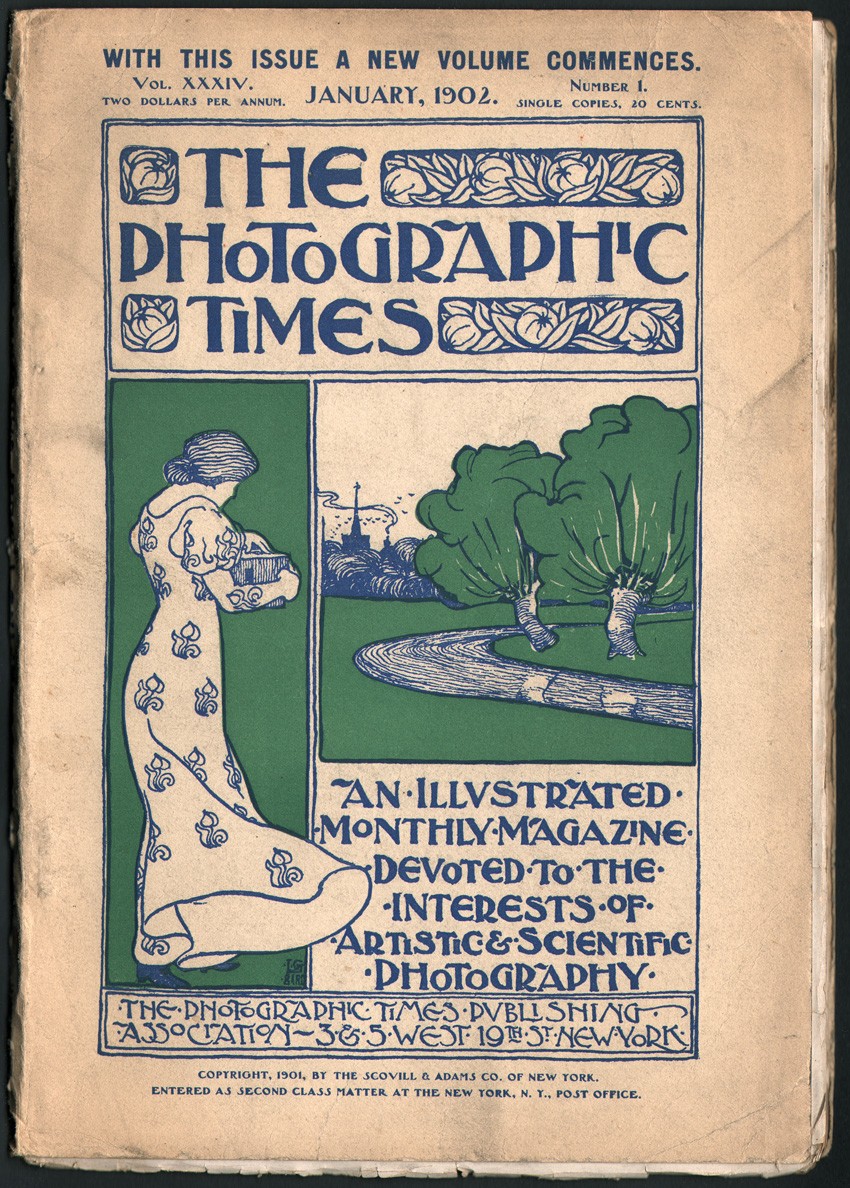 1902: A new cover design was introduced for The Photographic Times beginning with this issue in January, 1902. English artist Lennox G. Bird, who went by the professional moniker Curlew, (a playful association with his last name) had entered and won the Photographic Times silver medal competition the previous year. This design was used through at least January, 1903. Cover dimensions: 25.2 x 17.5 cm Cover: PhotoSeed Archive
1902: A new cover design was introduced for The Photographic Times beginning with this issue in January, 1902. English artist Lennox G. Bird, who went by the professional moniker Curlew, (a playful association with his last name) had entered and won the Photographic Times silver medal competition the previous year. This design was used through at least January, 1903. Cover dimensions: 25.2 x 17.5 cm Cover: PhotoSeed Archive
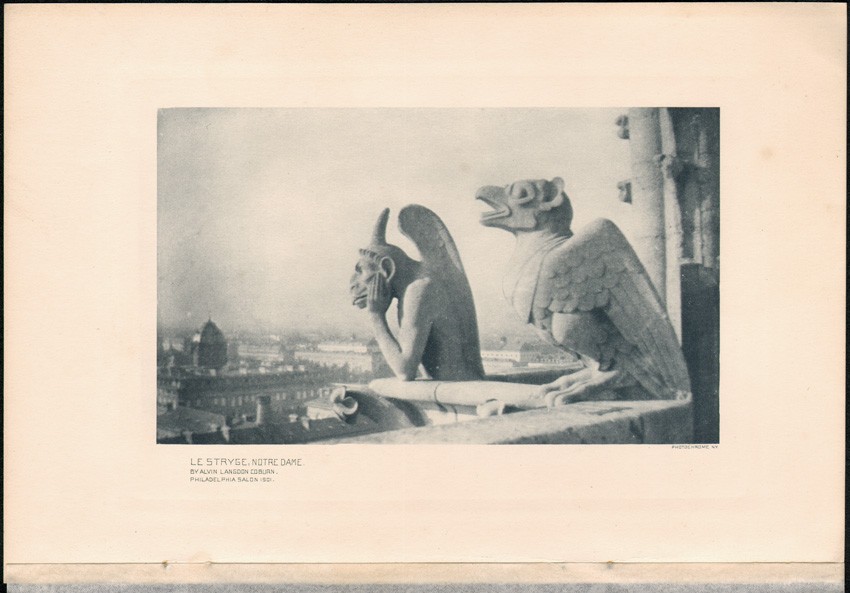 1902: Tissue-protected, hand-pulled photogravures like this example by American and later Welsh photographer Alvin Langdon Coburn (1882-1966) titled "Le Stryge; Notre Dame", continued to be featured in the Photographic Times, albeit in the smaller format beginning with the January, 1901 issue. Printed by the Photochrome Engraving Company of New York City, Coburn's photograph features two gargoyles watching over the city of Paris from a tower parapet of the Cathedral of Notre Dame. The image was inspired by French artist Charles Méryon's (1821-1868) 1853 etching of the gargoyle at center titled Le Stryge. (The Vampire) Plate dimensions: image: 10.0 x 16.4 cm | support:17.1 x 24.9 cm from: PhotoSeed Archive
1902: Tissue-protected, hand-pulled photogravures like this example by American and later Welsh photographer Alvin Langdon Coburn (1882-1966) titled "Le Stryge; Notre Dame", continued to be featured in the Photographic Times, albeit in the smaller format beginning with the January, 1901 issue. Printed by the Photochrome Engraving Company of New York City, Coburn's photograph features two gargoyles watching over the city of Paris from a tower parapet of the Cathedral of Notre Dame. The image was inspired by French artist Charles Méryon's (1821-1868) 1853 etching of the gargoyle at center titled Le Stryge. (The Vampire) Plate dimensions: image: 10.0 x 16.4 cm | support:17.1 x 24.9 cm from: PhotoSeed Archive
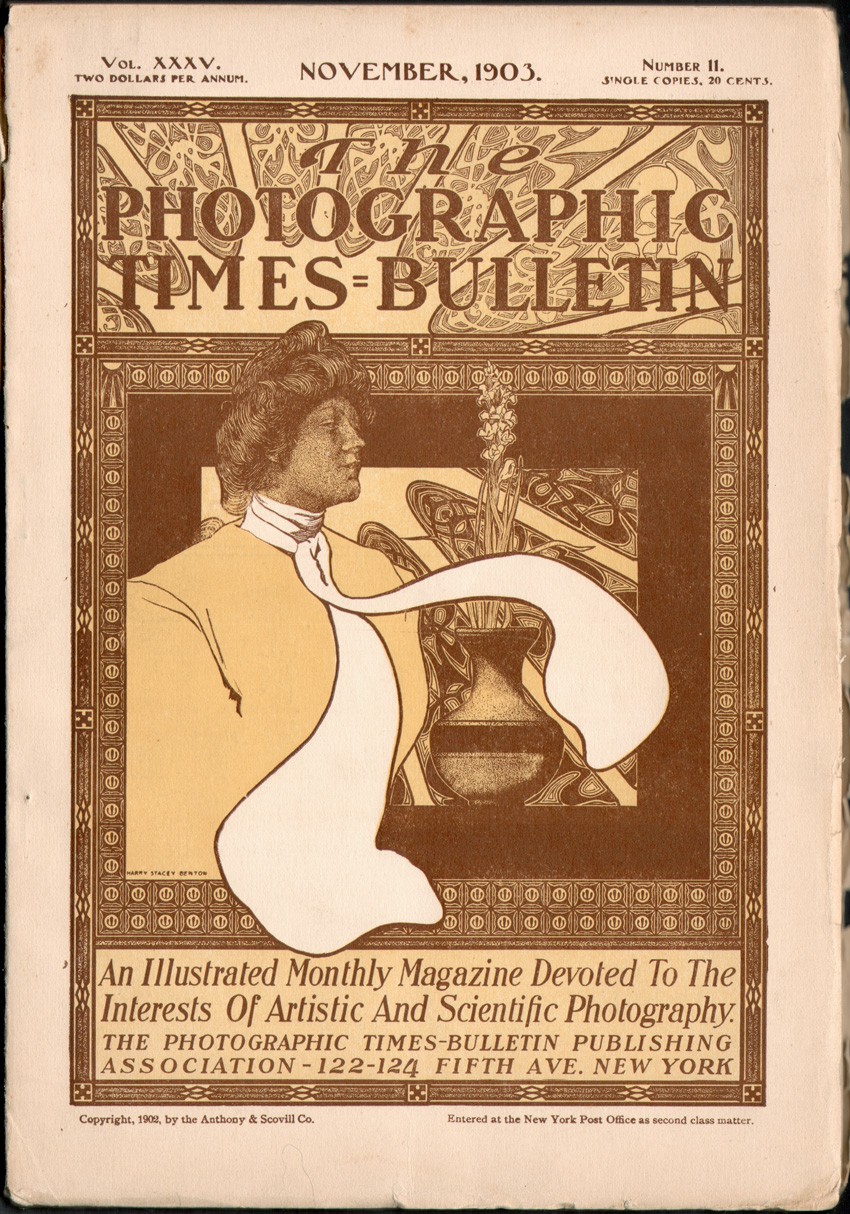 1902-1904: Beginning with the April, 1902 issue, the Photographic Times was renamed The Photographic Times-Bulletin, a combining of the Photographic Times and Anthony’s Photographic Bulletin, itself a result of the blockbuster December, 1901 business deal in which Scovill & Adams joined forces with the E. & H. T. Anthony & Company in order to fight off the mighty Kodak. Lennox G. Bird's cover design from 1902 carried over to the new publication until at least January, 1903, when this design by Chicago illustrator Harry Stacey Benton (b. 1876 or 1878) was used, most likely with the February issue. This was the final cover design for the Times-Bulletin which ceased publication under this name after the December, 1904 issue-reverting back to The Photographic Times in 1905. The wood-engraved, Art-Nouveau portrait of a woman with vase of flowers is set within an elaborate ornamental frame and printed in two colors. Cover dimensions: 25.2 x 17.5 cm. From: PhotoSeed Archive
1902-1904: Beginning with the April, 1902 issue, the Photographic Times was renamed The Photographic Times-Bulletin, a combining of the Photographic Times and Anthony’s Photographic Bulletin, itself a result of the blockbuster December, 1901 business deal in which Scovill & Adams joined forces with the E. & H. T. Anthony & Company in order to fight off the mighty Kodak. Lennox G. Bird's cover design from 1902 carried over to the new publication until at least January, 1903, when this design by Chicago illustrator Harry Stacey Benton (b. 1876 or 1878) was used, most likely with the February issue. This was the final cover design for the Times-Bulletin which ceased publication under this name after the December, 1904 issue-reverting back to The Photographic Times in 1905. The wood-engraved, Art-Nouveau portrait of a woman with vase of flowers is set within an elaborate ornamental frame and printed in two colors. Cover dimensions: 25.2 x 17.5 cm. From: PhotoSeed Archive
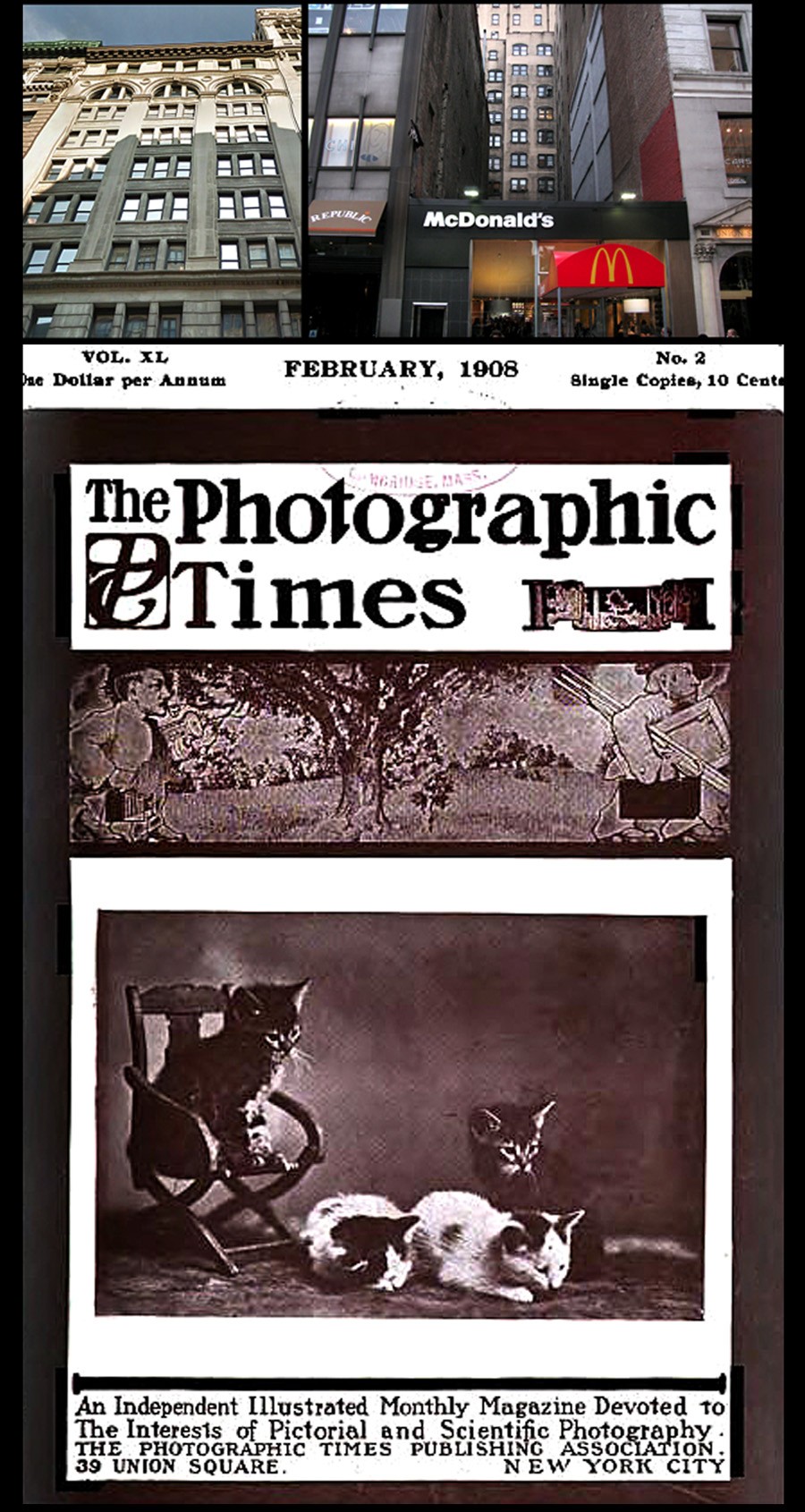 1902-1903 | 1904 | 1904-1908: Three address and two ownership changes took place for the Times-Bulletin and Photographic Times between 1902-1908. Upper left photo: from 1902-1903, the Times-Bulletin was published from this ornate building at 122-124 Fifth Ave.; the home of the combined firm of the Anthony & Scovill Company. By April of 1904, Lincoln Adams had bought out Anthony & Scovill's controlling interest in the journal, retaining the journal's name through the end of the year and moving the offices to Styles & Cash Printers at 75-77 Eighth Ave., a company he was president of. (this building no longer stands and is now occupied by an ornate bank building now turned into luxury condos) Upper right photo: from December, 1904 through 1908, the renamed Photographic Times (January, 1905) was published in a building that also no longer stands at 39 Union Square West, now the location of a McDonald's restaurant. Bottom cover: This is a representative cover of the Times from the Union Square years. Now priced at 10 cents, or a dollar a year, it featured a whimsical caricature of a photographer with camera in hand following an artist who holds his canvas and easel in pursuit of the next great vista anchored below the journal masthead. The February, 1908 cover art featured a large halftone photograph of decidedly "light" subject matter: a grouping of kittens. Reflecting this decidedly saccharine mass-market appeal, the Times guiding principal at bottom of cover also had changed to: "An Independent Illustrated Monthly Magazine Devoted to The Interests of Pictorial and Scientific Photography." Photo credits: Anthony & Scovill: Google Street View; Union Square: David Spencer/PhotoSeed Archive, cover: HathiTrust
1902-1903 | 1904 | 1904-1908: Three address and two ownership changes took place for the Times-Bulletin and Photographic Times between 1902-1908. Upper left photo: from 1902-1903, the Times-Bulletin was published from this ornate building at 122-124 Fifth Ave.; the home of the combined firm of the Anthony & Scovill Company. By April of 1904, Lincoln Adams had bought out Anthony & Scovill's controlling interest in the journal, retaining the journal's name through the end of the year and moving the offices to Styles & Cash Printers at 75-77 Eighth Ave., a company he was president of. (this building no longer stands and is now occupied by an ornate bank building now turned into luxury condos) Upper right photo: from December, 1904 through 1908, the renamed Photographic Times (January, 1905) was published in a building that also no longer stands at 39 Union Square West, now the location of a McDonald's restaurant. Bottom cover: This is a representative cover of the Times from the Union Square years. Now priced at 10 cents, or a dollar a year, it featured a whimsical caricature of a photographer with camera in hand following an artist who holds his canvas and easel in pursuit of the next great vista anchored below the journal masthead. The February, 1908 cover art featured a large halftone photograph of decidedly "light" subject matter: a grouping of kittens. Reflecting this decidedly saccharine mass-market appeal, the Times guiding principal at bottom of cover also had changed to: "An Independent Illustrated Monthly Magazine Devoted to The Interests of Pictorial and Scientific Photography." Photo credits: Anthony & Scovill: Google Street View; Union Square: David Spencer/PhotoSeed Archive, cover: HathiTrust
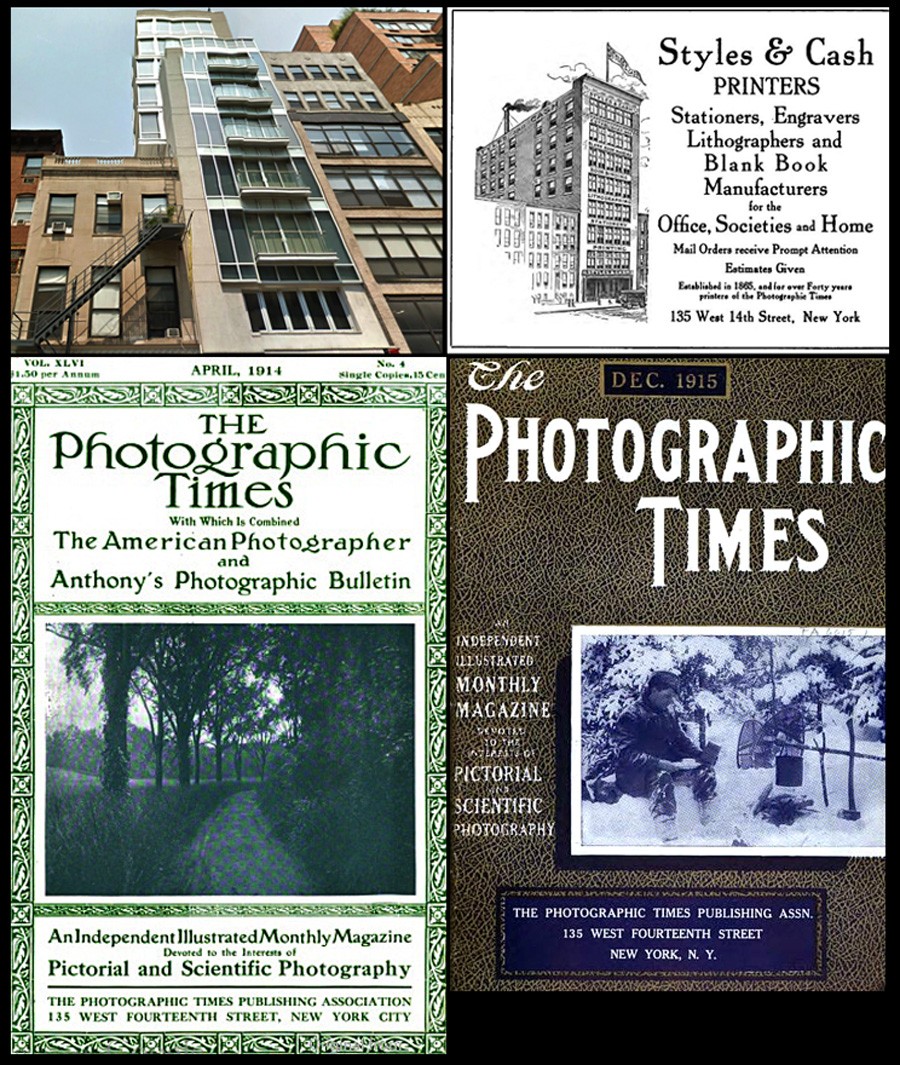 1909-1915: Under The Photographic Times Publishing Association, the Times was edited and published the final six years from this building at 135 West 14th street at top left: a ten-story building erected in 1906 by architect Charles Birge for the printing firm Styles & Cash. Since remade (2004) into condos on the upper floors with a hair salon at street level, a December, 1915 advertisement in the Times for the company is at top right. Two other cover design changes for the journal took place during this period. At lower left is the issue from April, 1914 and at lower right, the final cover for the December, 1915 issue. The Styles & Cash firm was in operation in New York from 1865-1920. Photo credits: Styles & Cash: Google Street View; ad & covers: HathiTrust
1909-1915: Under The Photographic Times Publishing Association, the Times was edited and published the final six years from this building at 135 West 14th street at top left: a ten-story building erected in 1906 by architect Charles Birge for the printing firm Styles & Cash. Since remade (2004) into condos on the upper floors with a hair salon at street level, a December, 1915 advertisement in the Times for the company is at top right. Two other cover design changes for the journal took place during this period. At lower left is the issue from April, 1914 and at lower right, the final cover for the December, 1915 issue. The Styles & Cash firm was in operation in New York from 1865-1920. Photo credits: Styles & Cash: Google Street View; ad & covers: HathiTrust
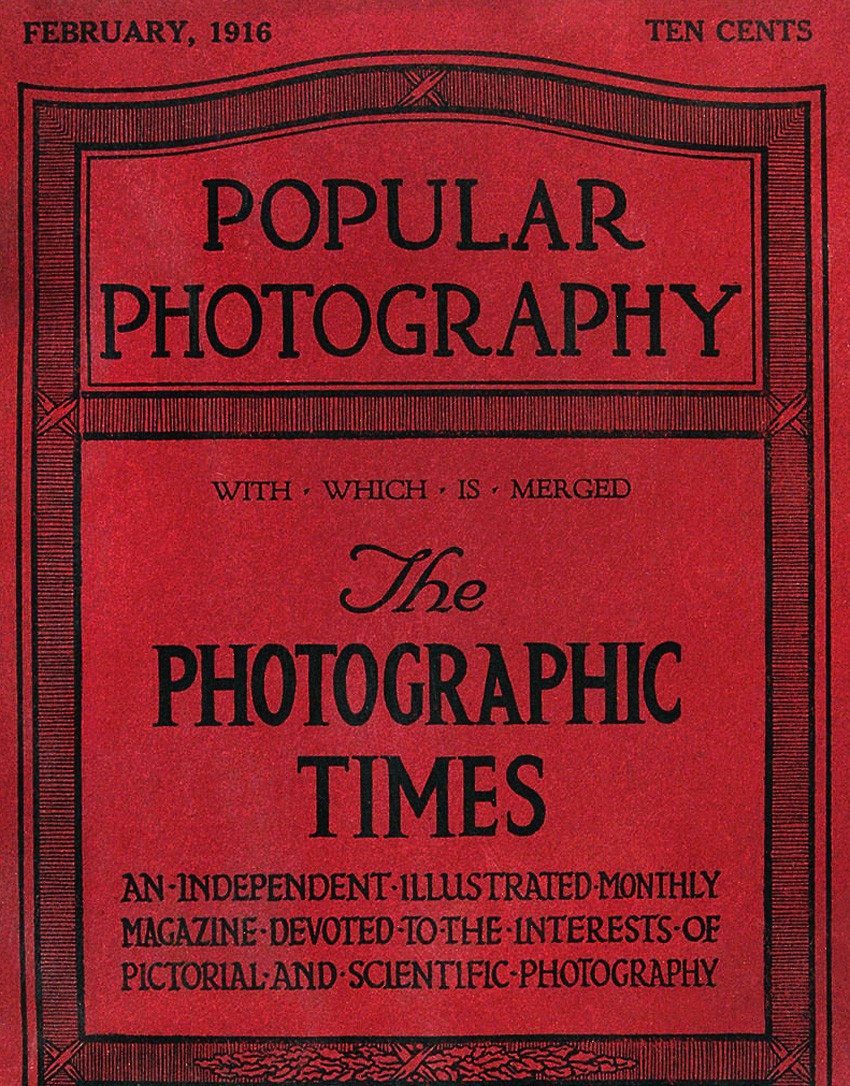 1916: With Which Is Merged: Beginning with the January, 1916 issue, the Times masthead was gone for good: absorbed into Popular Photography, a new journal published in Boston since October, 1912. Edited by Frank Roy Fraprie, W. I. Lincoln Adams was retained as an associate editor, although it is doubtful he had much of a hand with its affairs. Cover detail: February, 1916: Ebay
1916: With Which Is Merged: Beginning with the January, 1916 issue, the Times masthead was gone for good: absorbed into Popular Photography, a new journal published in Boston since October, 1912. Edited by Frank Roy Fraprie, W. I. Lincoln Adams was retained as an associate editor, although it is doubtful he had much of a hand with its affairs. Cover detail: February, 1916: Ebay
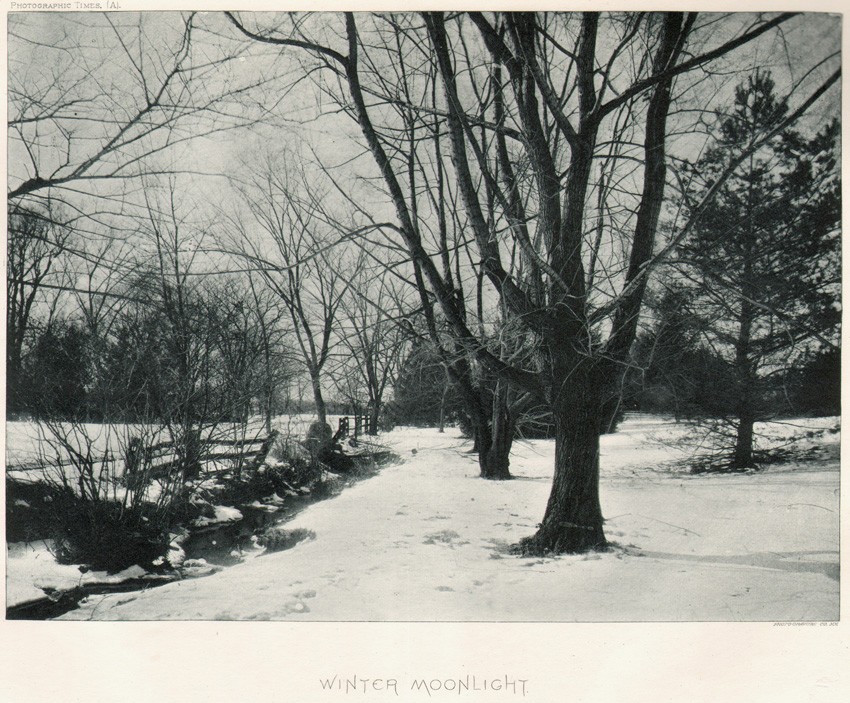 The Photographic Times was a labor of love for a father and son. Washington Irving Adams had the spark and drive to get the journal up and running beginning in 1870 and son W. I. Lincoln Adams dutifully took over the reigns of not only the journal but the Scovill & Adams firm upon his father's passing. In my view, the legacy they left in the form of the journal is invaluable, with their efforts along with many others giving enjoyment and continuing instruction on the art and science of photography from 1871-1915 we should continue to appreciate and investigate. This landscape study "Winter Moonlight" by Lincoln Adams was taken around 1885 and published in the Times in 1890. It is not especially memorable in my view, but does contain the kernel of adventure all photography has: "Let the landscape loving photographer of this city and neighborhood take a ramble with his camera" the Times copywriter (possibly Adams himself) declared as inspiration taken from the scene of this snow-blanketed wooded glade. Continuing the thought, "Mr. Adams is always eager to conduct a party, large or small, to the beautiful haunts about his picturesque home." As a young photographer myself, this was just the type of place I took my own camera to in search of what photography could accomplish and mean while learning most about my own self. My hunch is Adams own tramps in places like this shaped his thinking and outlook as well. Image: 14.4 x 19.7 cm | support: 20.5 x 28.7 cm. : photogravure in The Photographic Times, February 7, 1890 | issue No. 438: From: PhotoSeed Archive
The Photographic Times was a labor of love for a father and son. Washington Irving Adams had the spark and drive to get the journal up and running beginning in 1870 and son W. I. Lincoln Adams dutifully took over the reigns of not only the journal but the Scovill & Adams firm upon his father's passing. In my view, the legacy they left in the form of the journal is invaluable, with their efforts along with many others giving enjoyment and continuing instruction on the art and science of photography from 1871-1915 we should continue to appreciate and investigate. This landscape study "Winter Moonlight" by Lincoln Adams was taken around 1885 and published in the Times in 1890. It is not especially memorable in my view, but does contain the kernel of adventure all photography has: "Let the landscape loving photographer of this city and neighborhood take a ramble with his camera" the Times copywriter (possibly Adams himself) declared as inspiration taken from the scene of this snow-blanketed wooded glade. Continuing the thought, "Mr. Adams is always eager to conduct a party, large or small, to the beautiful haunts about his picturesque home." As a young photographer myself, this was just the type of place I took my own camera to in search of what photography could accomplish and mean while learning most about my own self. My hunch is Adams own tramps in places like this shaped his thinking and outlook as well. Image: 14.4 x 19.7 cm | support: 20.5 x 28.7 cm. : photogravure in The Photographic Times, February 7, 1890 | issue No. 438: From: PhotoSeed Archive
French Revolution Evolution
Posted September 2011 in Engraving, Journals
In France, prior to taking on the complex task of publishing the journal L’Art Photographique, (The Photographic Art) first appearing in July, 1899, Georges Carré and C. Naud in Paris had made a reputation for publishing volumes dealing in scientific, medical, as well as photographic subjects. Their journal the Photo-Gazette under the editorship of Georges Mareschal was the best known.
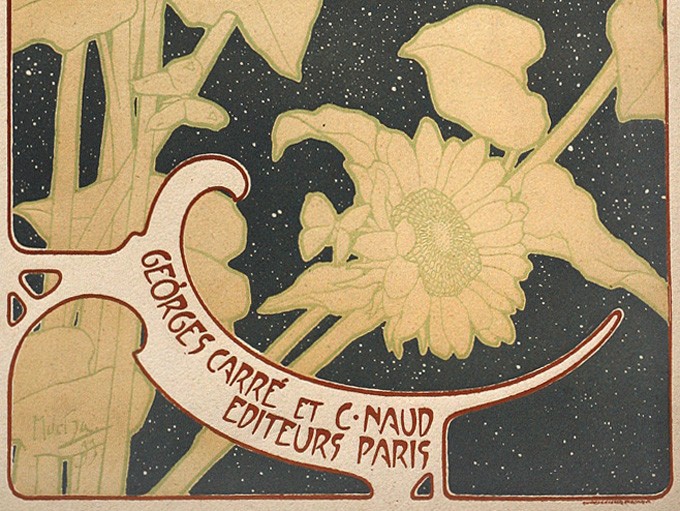 Paris publishers Georges Carré and C. Naud intended to showcase photography on the cover of L'Art Photographique but settled for the tried and true in the form of artwork and typography done by Czech Art Nouveau painter Alphonse Mucha instead.
Paris publishers Georges Carré and C. Naud intended to showcase photography on the cover of L'Art Photographique but settled for the tried and true in the form of artwork and typography done by Czech Art Nouveau painter Alphonse Mucha instead.
With the committed goal of keeping the relevance of photographic art before the public eye and with the backing of France’s elite photographic body in the form of The Photo Club de Paris, Carré and Naud under the leadership of Mareschal set about contracting with multiple printing ateliers throughout the country (1.) in order to showcase work produced by the club’s members.
 Carrying the imprint of Spécimen stamped in blue ink, this plate with the title "Automne" by French photographer Robert Demachy was eventually included with the October, 1899 issue of the journal. Without knowing any specific details, it may have been used as a working production publisher's plate at the outset to publication or even one to solicit potential subscribers for it.
Carrying the imprint of Spécimen stamped in blue ink, this plate with the title "Automne" by French photographer Robert Demachy was eventually included with the October, 1899 issue of the journal. Without knowing any specific details, it may have been used as a working production publisher's plate at the outset to publication or even one to solicit potential subscribers for it.
Certainly with Franz Goerke’s Die Kunst in der Photographie journal in Germany serving as a model beginning only two years earlier in 1897, the publishers believed bigger was better, (46.0 x 34.0 cm) and the task of presenting French work (2.) as reproduction plates in the original size the photographer intended was the stated goal from the outset. Everything about this photographic magazine is admirable, and for France, this evolution would break new ground as the first monthly photographic publication solely devoted to the image itself. Looking back, it is also an important historical record of the cutting-edge, French photographic engraving being produced at this time. The photographic plates included with it are printed in the finest hand-pulled photogravure, collotype, (photocollographie) and single and multiple-color halftone. (similigravure) These in turn are printed, often by a separate atelier, on a variety of French papers running the gamut from hand-made plate paper to traditional examples of thick coated stock. To satisfy the photographic purist, technical details for the images are often supplied on the accompanying plate tissue-guards. So in a word, revolutionary.
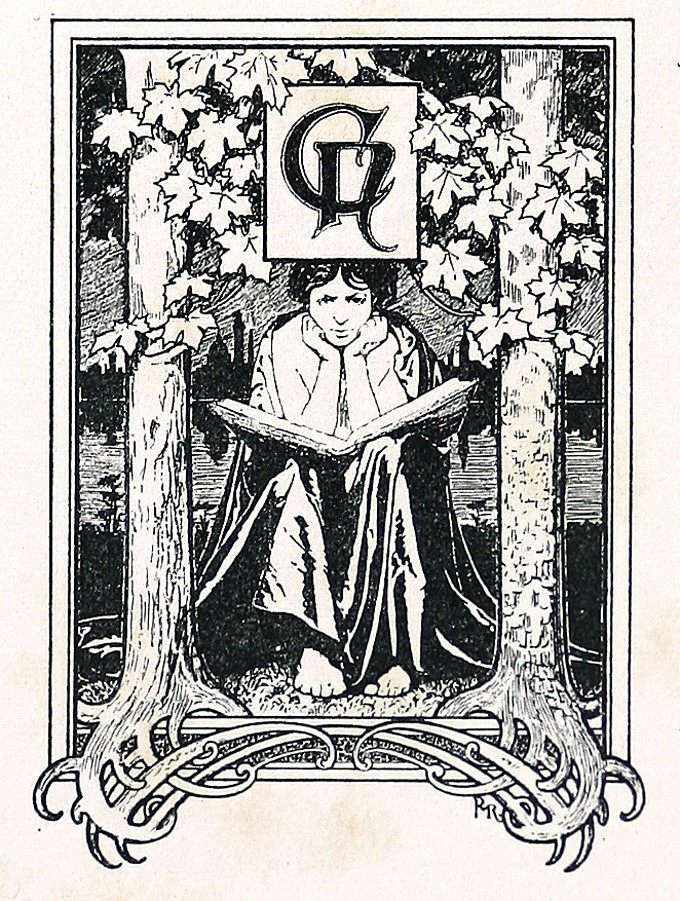 This Art Nouveau, publishers imprint ( 6.5 x 4.7 cm ) woodcut for Georges Carré and C. Naud by the French artist P. Ruty appears on the title page to the bound, collected volume of L'Art Photographique in our archive.
This Art Nouveau, publishers imprint ( 6.5 x 4.7 cm ) woodcut for Georges Carré and C. Naud by the French artist P. Ruty appears on the title page to the bound, collected volume of L'Art Photographique in our archive.
In the mission statement laid out by editor Georges Mareschal in the first issue, he explains the admirable intention of employing the cover itself to showcase a photograph. But because of logistical problems not revealed, (3.) the talents of Czech Art Nouveau painter Alphonse Mucha were employed in 1899 to design its cover used consistently over the one year run ending in June, 1900.
 This detail of a tissue-guard for the plate "Étude a L'Atelier" by Polish photographer Count Aleksander von Tyszkiewicz, (working in Paris) is an example of engraving and technical specifics for work included in the journal. It was included in the September, 1899 issue.
This detail of a tissue-guard for the plate "Étude a L'Atelier" by Polish photographer Count Aleksander von Tyszkiewicz, (working in Paris) is an example of engraving and technical specifics for work included in the journal. It was included in the September, 1899 issue.
At PhotoSeed, we are excited to be able to present all 48 photographs from L’Art Photographique in their order of publication beginning here.
Notes:
1. Nine in France and the long established firm of Jean Malveaux in Brussels.
2. Although several examples from Argentina, Belgium, England and a Polish photographer working in Paris are included.
3. My own conjecture on this surmises the publishers felt an over-sized magazine needed to be “shown off” better-especially with the resources being devoted to its production, and there was certainly no better way to do this than to employ a cover “poster effect” in the form of a full-color lithograph by Mucha.
New Fruit in Color, Black & White, and Shades in Between
Posted August 2011 in Color Photography, Journals, New Additions, PhotoSeed
Since PhotoSeed launched a month ago, I have been putting together material on a run of the important German photographic journal known as Photographische Mitteilungen. (Photographic Reports) Several hundred photographs, almost all of them hand-pulled photogravures, are now searchable in our archive database. As a working photographer myself, it is an honor to be able to give new light to this material and introduce fresh eyes to it over a century later.
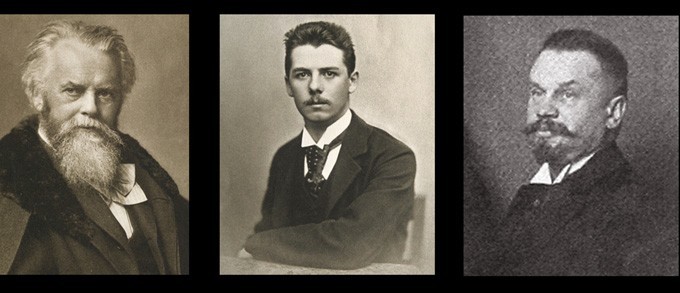 From left to right: Photographische Mitteilungen founder and editor H.W. Vogel: 1864-1898; his son Dr. Ernst Vogel, who edited the journal from at least 1893-1901; and Paul Hanneke-sole editor from 1901-1911.
From left to right: Photographische Mitteilungen founder and editor H.W. Vogel: 1864-1898; his son Dr. Ernst Vogel, who edited the journal from at least 1893-1901; and Paul Hanneke-sole editor from 1901-1911.The challenge for me has been trying to get things right the first time. The language barrier in assessing this material has often been difficult in some cases to overcome. But fear not. If I’m not comfortable about something regarding a translation, I will probably not include it unless I spell it out verbatim on the site-which I have done in a few cases already. I wish I could say I spoke five languages but since four years of high school French is my reality, Google as well as other online translation software has taken up the slack in this department. I have been translating titles of the work where appropriate (found in the misc. tags area) in order to give our English-speaking audience an idea what the photographer’s intent was as well. “Unidentified” seems to be my new favorite word on some days but consistency will always be my mantra while adding material to the site.
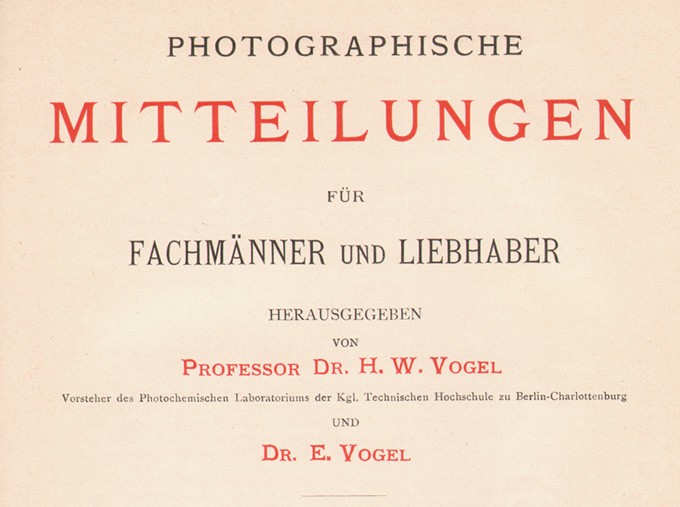 This detail shows the title page for the 30th year of Photographische Mitteilungen covering 1893-1894.
This detail shows the title page for the 30th year of Photographische Mitteilungen covering 1893-1894.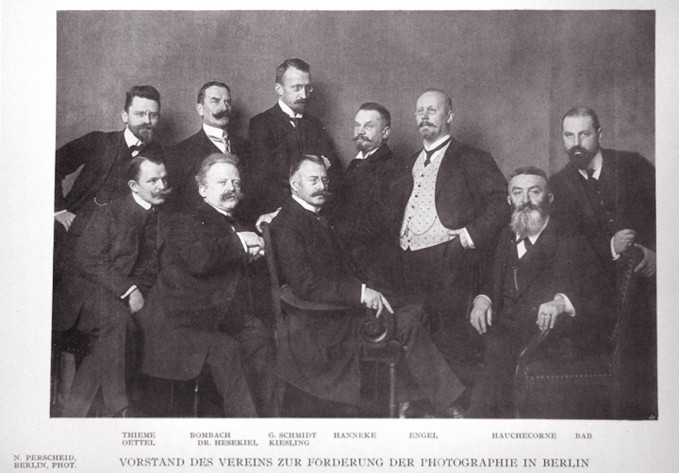 This photograph taken by Berlin photographer Nicola Percheid from the March, 1909 issue of Photographische Mitteilungen shows board members of the Association for the Promotion of Photography in Berlin. (Vorstand des Vereins zur Förderung der Photographie in Berlin) This is the same organization founded by H.W. Vogel in 1863. In the early years of the publication, the name was incorporated into the title page since the journal was actually its mouthpiece. (example- Photographische Mittheilungen: Zeitschrift des Vereins zur Förderung der Photographie) Over the years, the journal lost the "h" in Mittheilungen as well. Seen in this photograph at center is journal editor Paul Hanneke and to his right, journal publisher Gustav Schmidt.
This photograph taken by Berlin photographer Nicola Percheid from the March, 1909 issue of Photographische Mitteilungen shows board members of the Association for the Promotion of Photography in Berlin. (Vorstand des Vereins zur Förderung der Photographie in Berlin) This is the same organization founded by H.W. Vogel in 1863. In the early years of the publication, the name was incorporated into the title page since the journal was actually its mouthpiece. (example- Photographische Mittheilungen: Zeitschrift des Vereins zur Förderung der Photographie) Over the years, the journal lost the "h" in Mittheilungen as well. Seen in this photograph at center is journal editor Paul Hanneke and to his right, journal publisher Gustav Schmidt.
In researching the history of the journal, I discovered early examples of color plates reproduced from 1893. Twenty years earlier, journal founder and photochemist H.W. Vogel had first figured out how color sensitizing agents could be added to photographic plates in order for objects to delineate themselves into their proper shades of gray.
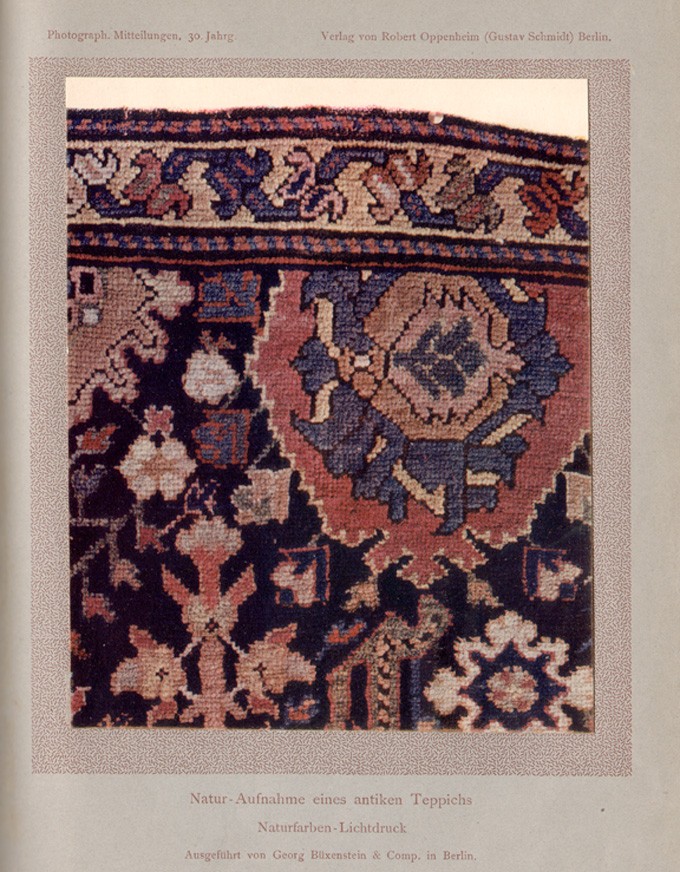 This very early natural-color collotype photograph showing a swatch of an antique rug was done by the atelier Georg Büxenstein in Berlin and reproduced as a full-page plate in the April 15 (heft 2) 1893 issue of Photographische Mitteilungen. Dimensions- image- 15.3 x 12.2 cm -support- 24.4 x 16.9 cm (trimmed)
This very early natural-color collotype photograph showing a swatch of an antique rug was done by the atelier Georg Büxenstein in Berlin and reproduced as a full-page plate in the April 15 (heft 2) 1893 issue of Photographische Mitteilungen. Dimensions- image- 15.3 x 12.2 cm -support- 24.4 x 16.9 cm (trimmed)
Later, his son Ernst Vogel- (who had joined his father as co-editor at an undetermined date but at least since 1893) took up the challenge of printing three-color photographs in halftone as well as collotype. He first teamed up with William Kurtz in New York in 1892 (who was a good friend of his father’s) and a year later with Berlin engraver Georg Büxenstein.
The three-color halftone below showing a still life of fruit reproduced in the January, 1893 issue of the journal is believed to be one of the very first three-color halftones ever done on a large scale. In Berlin, Ernst Vogel’s subsequent business relationship with Büxenstein bore additional fruit in the form of this firm’s exquisite gravure plates now available for your examination on our site.
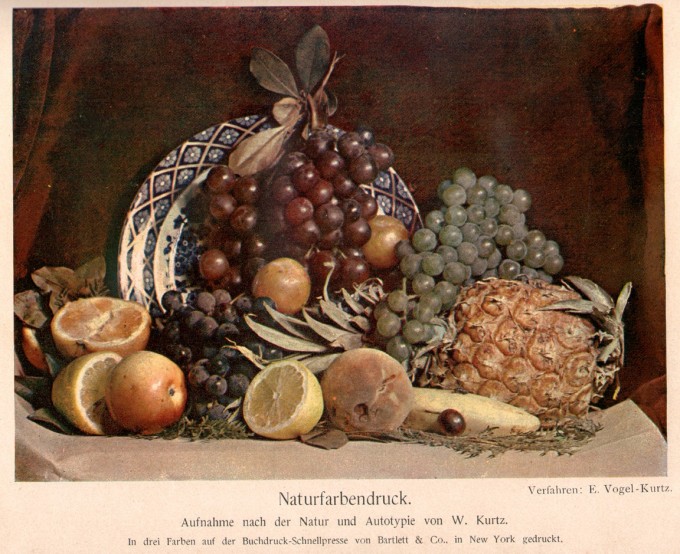 The New York engravers Bartlett & Co. under the direction of William Kurtz and Ernst Vogel printed this very early three-color halftone image. Dimensions: image: 13.3 x 18.3 cm : support: 16.7 x 24.5 cm coated stock paper (trimmed)
The New York engravers Bartlett & Co. under the direction of William Kurtz and Ernst Vogel printed this very early three-color halftone image. Dimensions: image: 13.3 x 18.3 cm : support: 16.7 x 24.5 cm coated stock paper (trimmed)